Judging and Evaluating Dairy Cattle
Introduction
This material was developed for youth, such as 4-H'ers, FFA students and beginning judges in college or university courses. The chapters presented follow the Dairy Cattle Selection course at the University of New Hampshire that Dr. Drew Conroy has taught for the last 3 decades. This resource has a lot of photos which help provide additional examples, to be used in judging and evaluation. The numerous photos have been selected and included here to supplement other resources as listed below. For decades the textbook, Dairy Cattle Judging Techniques, first by George Trimberger and the 4th edition by Trimberger, Etgen and Galton (last published in 1993) provided a array of photos to help beginning judges see the extremes and variation found in dairy cattle when doing visual evaluation. The book had many photos of animals that went back to the first edition in the 1950's, which showed what are now historic photos of dairy cattle, with less and less relevance to the cattle of today as time went on. Finally, with this book no longer being published and used copies bringing high prices, this OER resource was developed to help beginning judges see some of those same variations in dairy cattle and provide a supplement to other materials available on the internet.
Use of this material
There are numerous short workbooks for dairy cattle judging, for example those available through Hoard's Dairyman[1] and the Holstein Association[2]. Please use their materials as additional resources. Hoard's Dairyman has just initiated a whole set of videos and other materials in conjunction with Dairy Science Professor and Dairy Coach, Dr. Katharine Knowlton of Virginia Tech. Click below for a direct link to these excellent resources
Holstein Association Judging Workbook
Ohio State Cooperative Extension Judging Resources
See: Hoard's Dairy Dairy Judging Corner - resources
Readers are free to adapt or use the written material here and/or the photographs for instructional non-commercial uses. The photographs are all original photos taken by the author. The videos highlighting breeds and judging techniques are examples that were available on YouTube at the time of publication. These videos add outstanding images and ideas from others to assist new judges in developing their skills.
Chapter 1- Introduction and Evaluation Techniques
Why Judge Cattle?
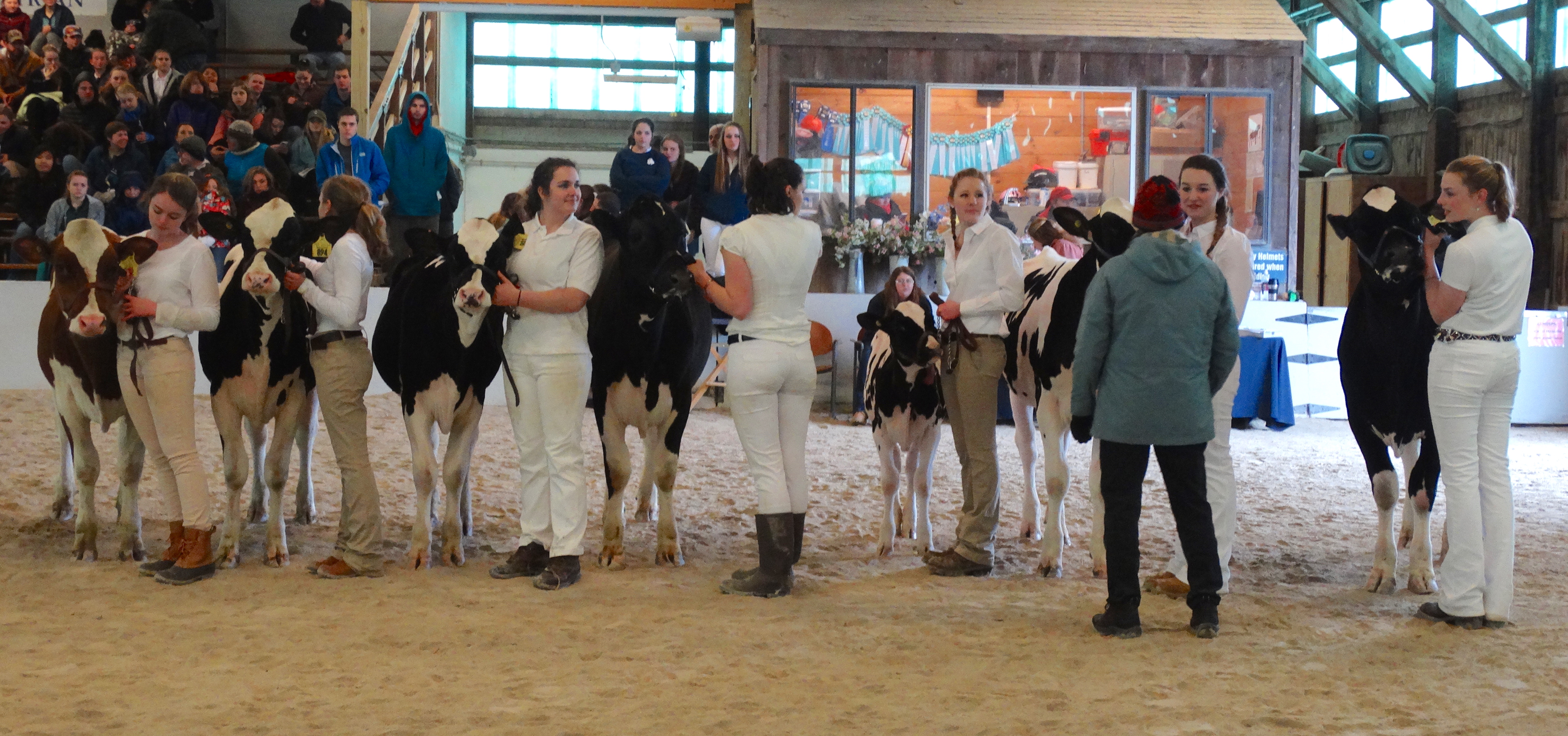
Judging Dairy Cattle can be done for competition, fun, recognition, and even money
Historically, since the first animals were domesticated, they have been selected by people who controlled them. Mating decisions may have been somewhat random at first, but large animals like cattle were likely selected first for traits such as being tame and more easily managed. Unruly animals or dangerous animals would have likely been eliminated, as they would have been difficult to herd and keep in confinement. Therefore any animals eliminated from the herd, also eliminated their genetic influence over time. Farmers continue to select animals for temperament, even if it is not a selection criteria we think about. Animals that do not fit into our management systems, such as being difficult to milk, too high strung to be kept in our fencing systems, or being aggressive toward handlers do not stay in the herd, and therefore neither do their genetics.
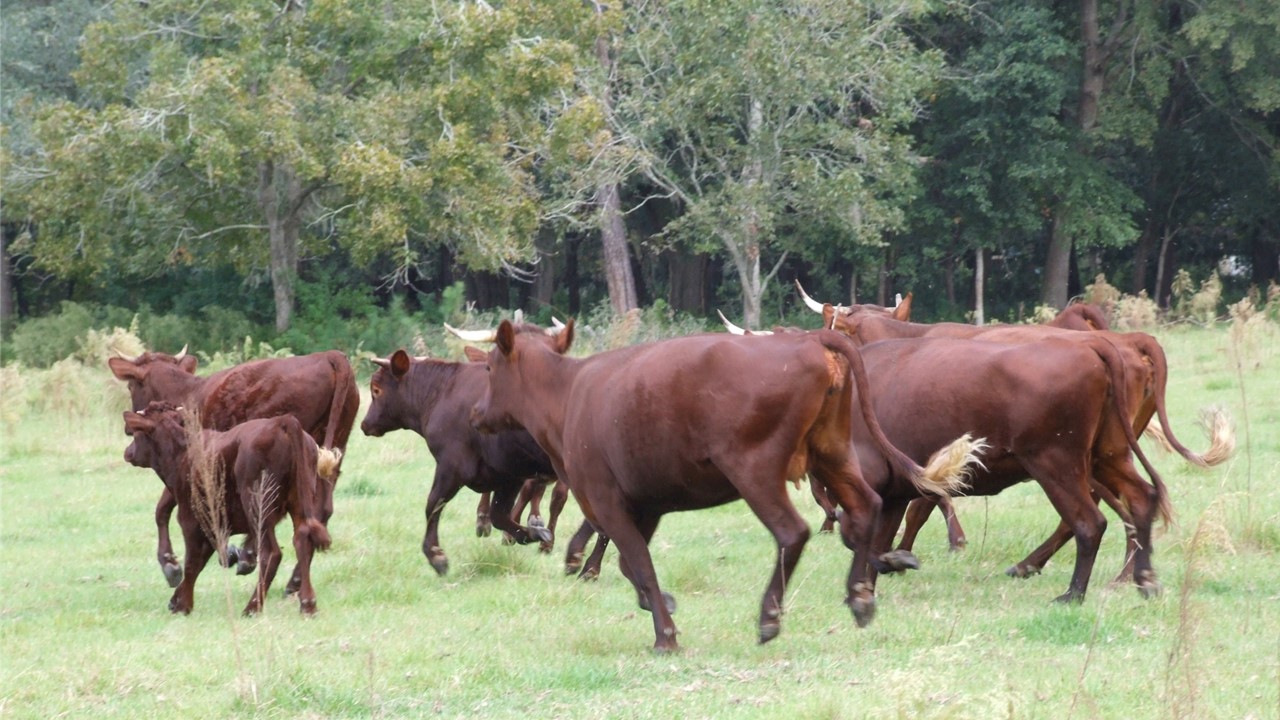
Dairy Cattle have been selected away from traits like this where they run at the sight of humans or are really difficult to manage.
Overtime people recognized they could breed animals, including cattle for certain colors, sizes, and other criteria. For thousands of years, most cattle were bred by small farmers who simply hoped to produce a calf and milk, meat or draft power for the family, with little regard for pedigree, breed or specific criteria. It was often the most wealthy people and nobility who bred animals for specific characteristics. Climate, geography, feed availability and other factors also influenced the characteristics cattle would have had in different regions of the world. Cattle evolved where they were, whether it be Asia, Africa or Europe, but most modern dairy breeds found in the United States were descended from the cattle found in Northwestern Europe, such as The Netherlands, England, France, Germany, Ireland and Scotland.
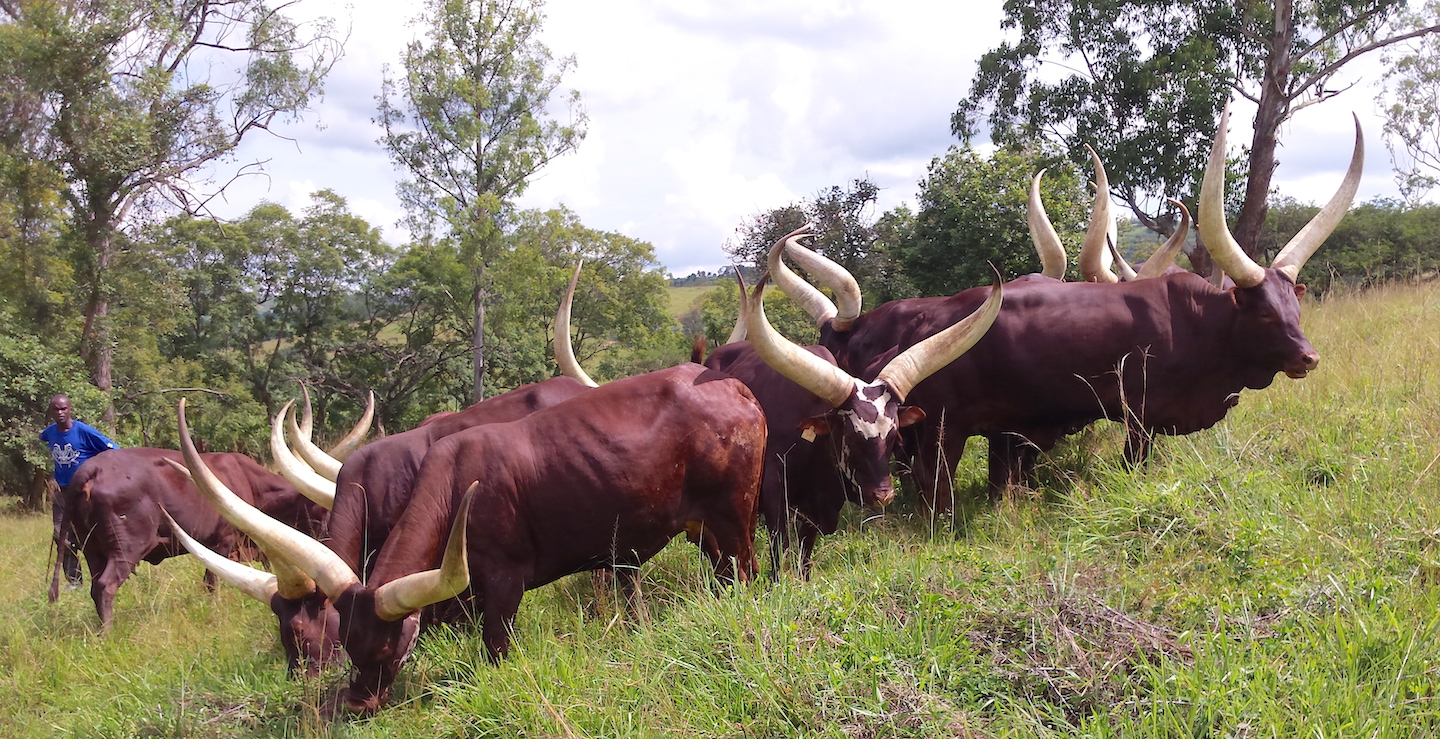
Ankole-Watusi Cattle, also called Inyambo cattle, when a solid, red, the desired cattle of Rwanda's royalty
The example of the Holsteins in this video, also show how good selection and breeding can achieve remarkable results with a cow that produces large amounts of milk over its lifetime, while at the same time maintaining the traits and characteristics desired in a modern dairy cow.
Introduction and Evaluation Techniques
Visually evaluating dairy
cattle based on physical traits observed in the animal is a qualitative skill
that takes practice and requires an understanding of cattle body parts. Using visual evaluation can
help identify the traits that are desired in the animals for their health, longevity,
and high milk production levels as well as provide a tool in selecting animals
to be kept for breeding and those that will be sold or culled from the herd. Below is a list of things a student, farmer, veterinarian or other person interested in dairy cattle judging could learn from a quick visual evaluation of the animal or animals in just a few moments with some basic understanding of desirable and undesirable characteristics.
Visual evaluation skills can
be used by and be helpful to farmers, veterinarians, 4-H and FFA youth, as well
as students of agriculture and animal science, where they learn to quickly
evaluate the quality and health of an animal, without the need for other tools
or technology. While visual evaluation does not provide the information
possible with new genetic technologies, it does provide insight into an animal
that will be healthy and productive. These skills are also valuable to 4-H
Leaders, FFA advisors, agriculture teachers, and college instructors, who teach
students to judge cattle. Over time fewer and fewer people grow up interacting
with cattle on a farm, and have little or no knowledge about what makes a
healthy and productive animal, without some instruction.
With some training in qualitative evaluation of dairy cattle, all of these can be seen in less than a minute by Simply looking at an animal providing insight on the animal's:
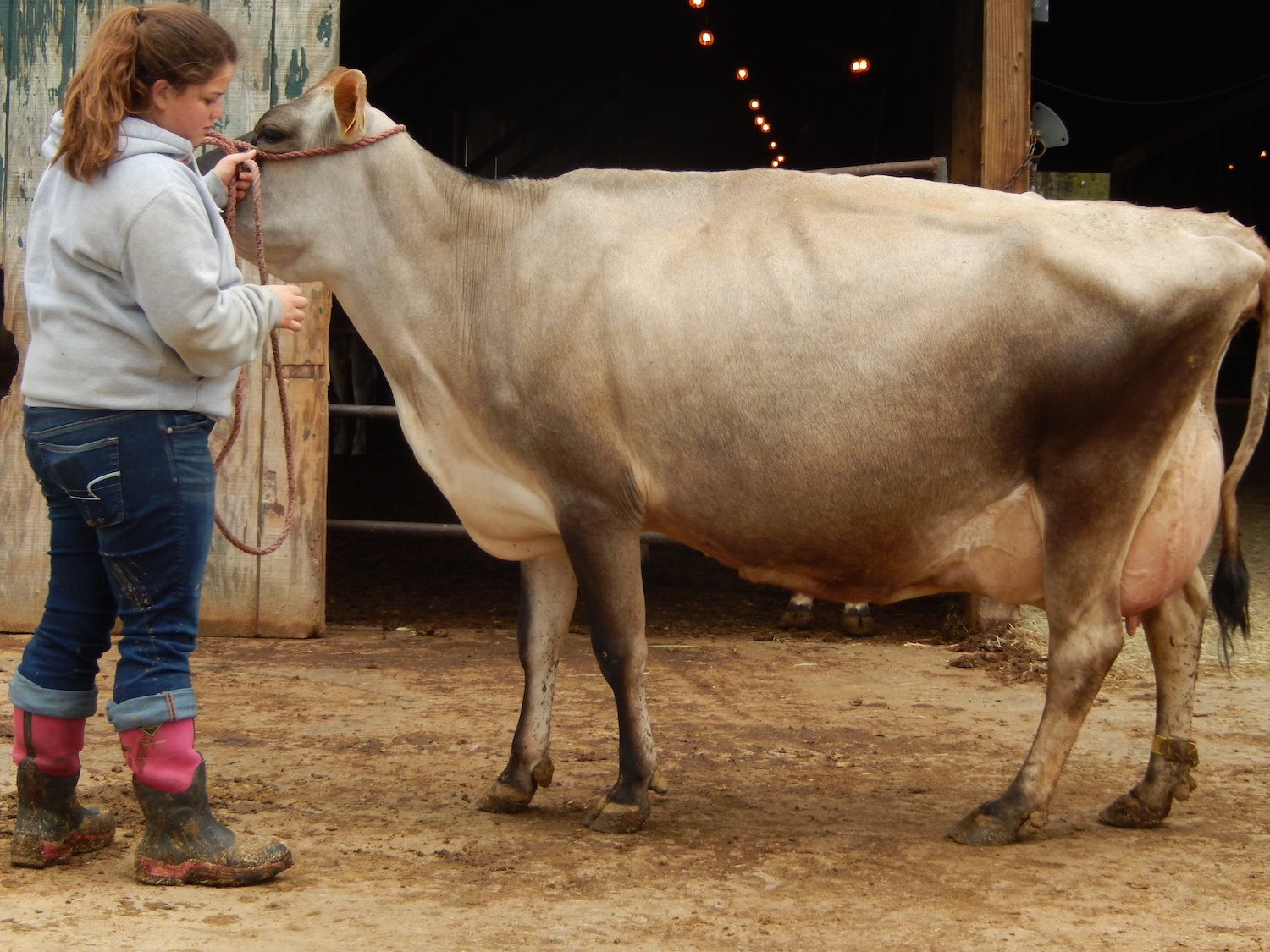
A quick look at this cow shows that she is mature, with realtively high production, likely in early to mid lactation as she is lean and angular, with no noticeable health issues, and slighly weak pasterns
- Age
- Size
- Weight
- Health
- Sex
- Breed
- Possible Family/Lineage
- Production Level
- Production Capacity
- Body Condition
- Stage of Lacation
- Body Capacity
- Reproductive Capacity
- Soundness (Feet and Legs)
- History
- Environment it has lived in
Learning to quickly evaluate an animal's strengths and weaknesses can be done by viewing an animal in a photo or live for just 10-30 seconds and writing down or sharing what was seen. This can help train people to look at what is most important and learn to focus their attention on the most important parts of the dairy animal.
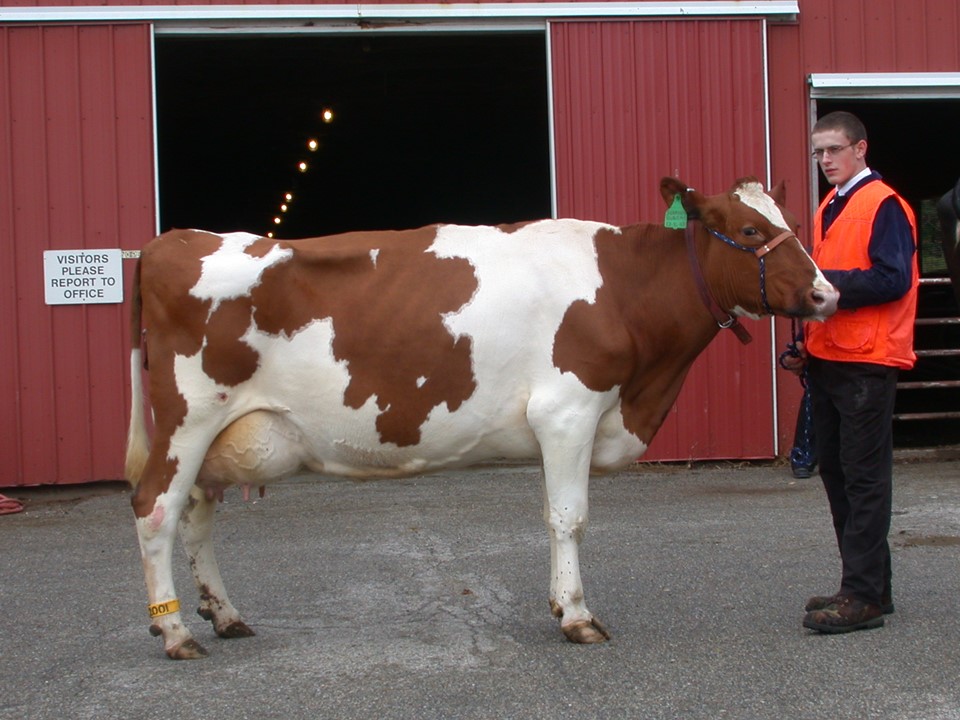
Quickly and effectively evaluating an animal can provide a wealth of information
Over time many new technologies have been developed to assist in identifying and evaluating animals based on their genetic merit or more recently their actual genetic make-up[3]. These tools are extremely valuable, but they still need to be combined with an evaluation of the physical traits that allow the animal to exhibit its full genetic potential. For example, a cow with genomic information showing her to have high milk production, could have an udder or teat shape and size that make the animal far less valuable than her genetic information might suggest.
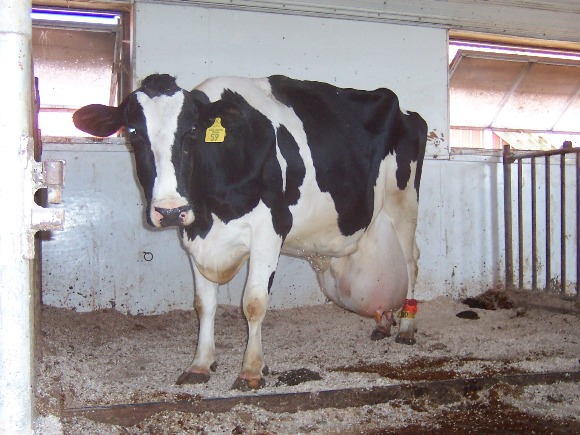
Possibly a High Genomic Animal for Milk
Furthermore, the traits we desire in dairy cattle has changed over time, with animals that have been bred to better fit our management systems. Cattle from decades ago were thicker, carrying more flesh, had lower udders and less body capacity and openness of rib (meaning the ribs did not show as often).
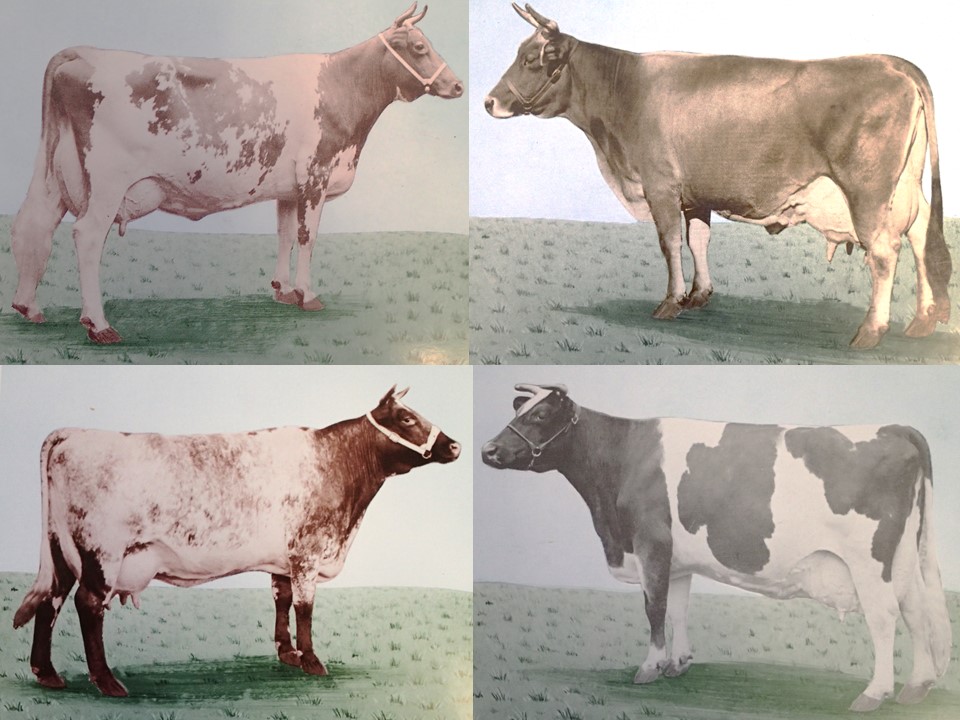
Breeds have changed over time due to selection for animals that produced more milk, had fewer issues related to feet and legs, and could consume more feed. These cattle 60-70 years later would be considered poor representatives of their breeds.
In years past cattle were milked by hand. These cattle required larger teats that allowed someone to effectively milk the animals. The same size teats today are problematic, as the milking machine teat cups do not fit such teats.
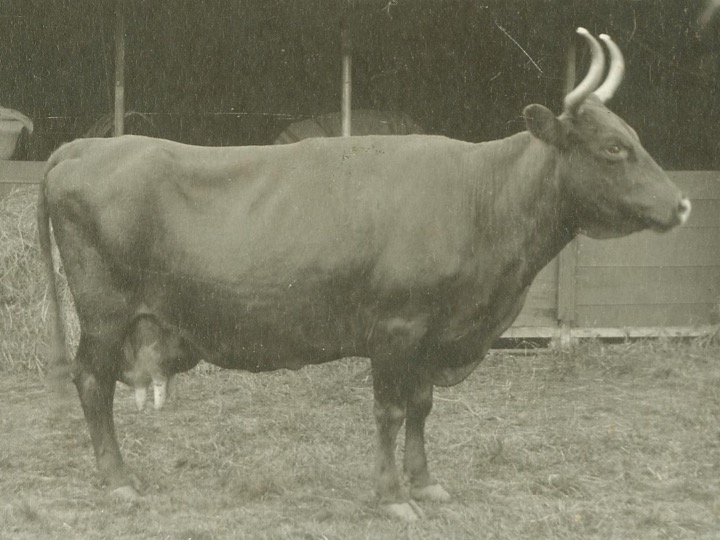
Devon Cow
Milking machines require
shorter and more narrow teats which had to be selected for after making
qualitative observations of the animals and breeding decisions based on this
physical trait.
More and more dairy cattle are being milking in robotic systems, which has also created the need for a certain shape of the udder, as well as specific sizes and placement of the teats. Qualitative evaluation of the udder and teats can quickly identify animals that will be problematic.
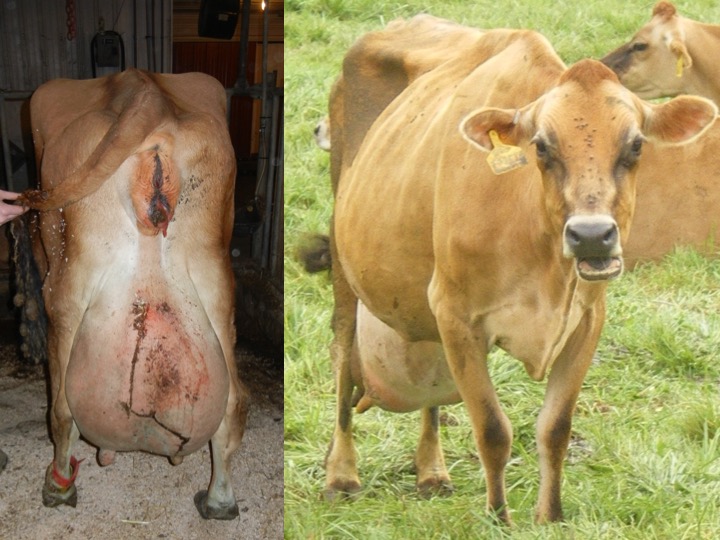
Jersey Cows with low udders and poor teat placement
So why should anyone care about dairy cattle judging? It has value at many levels, especially for people involved in the industry. Farmers learn to evaluate cattle, even if they are not interested in judging them competitively.
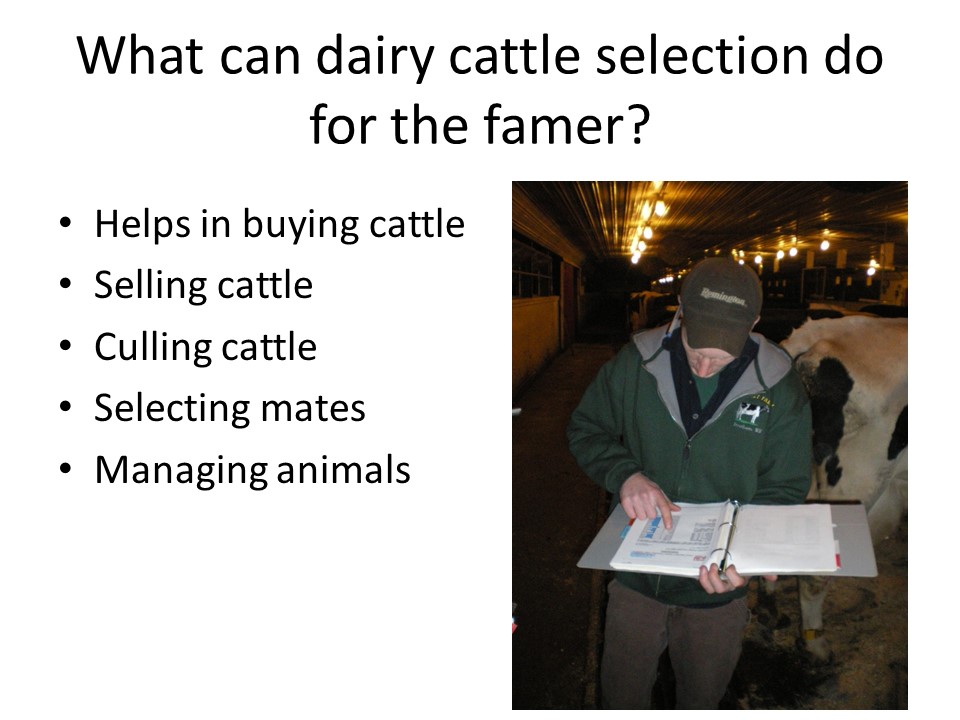
Evaluating records and the live animal are important
Students who hope to work as Veterinarians or others working as professionals such as nutritionists gain credibility with farmers if they can look at cattle and compliment the good ones in the herd. It demonstrates an understanding of the animals that someone who has not studied dairy cattle evaluation would not have.
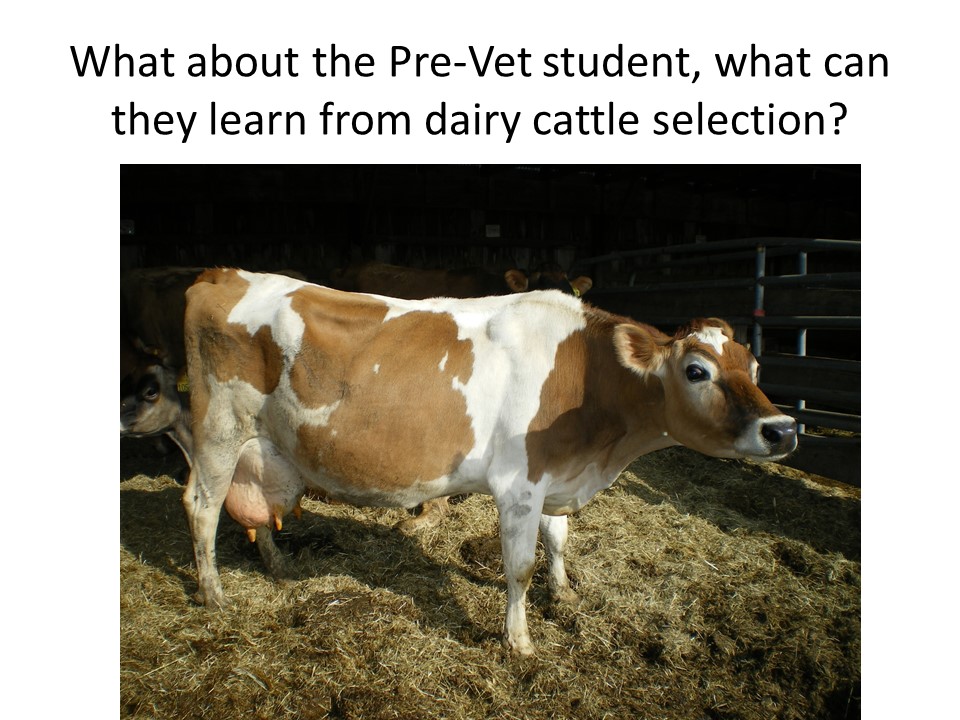
This Jersey cow is older, with a number of issues that are going to catch up with her. What are they?
Even just looking at a group of cows, as noted above, there is a wealth of information being displayed by the cows. It simply takes some training and observation to learn to determine and understand what the cows are displaying.
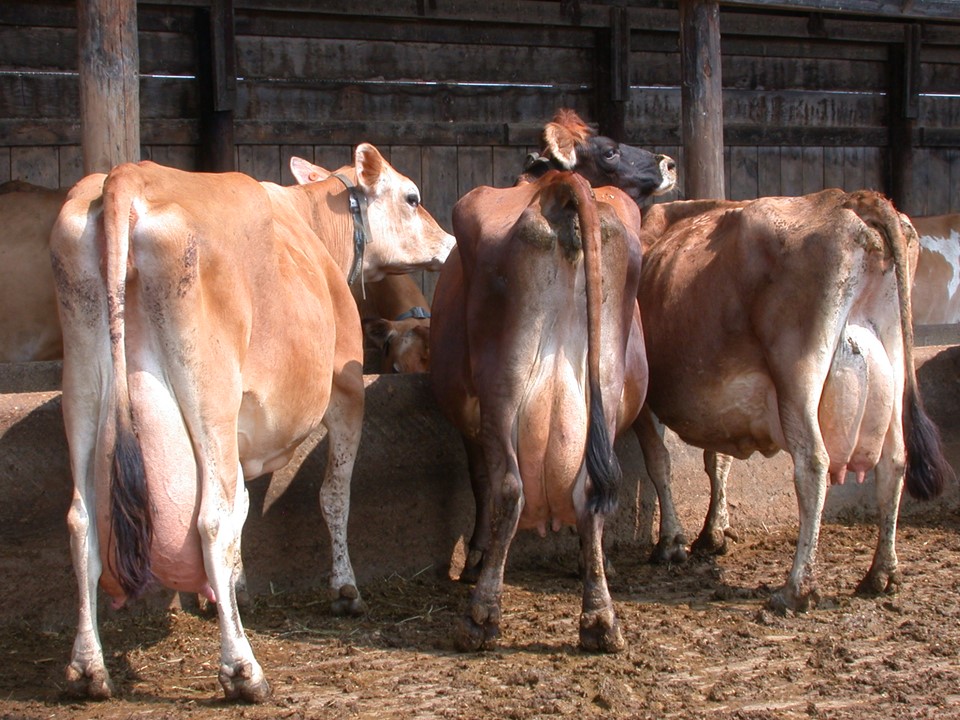
There is a wealth of information a judge, veterinarian or student can gain by understanding how conformation affects productivity and health. The difference between the udder height alone in these three cows will have a large bearing on which cow stays longer in the herd.
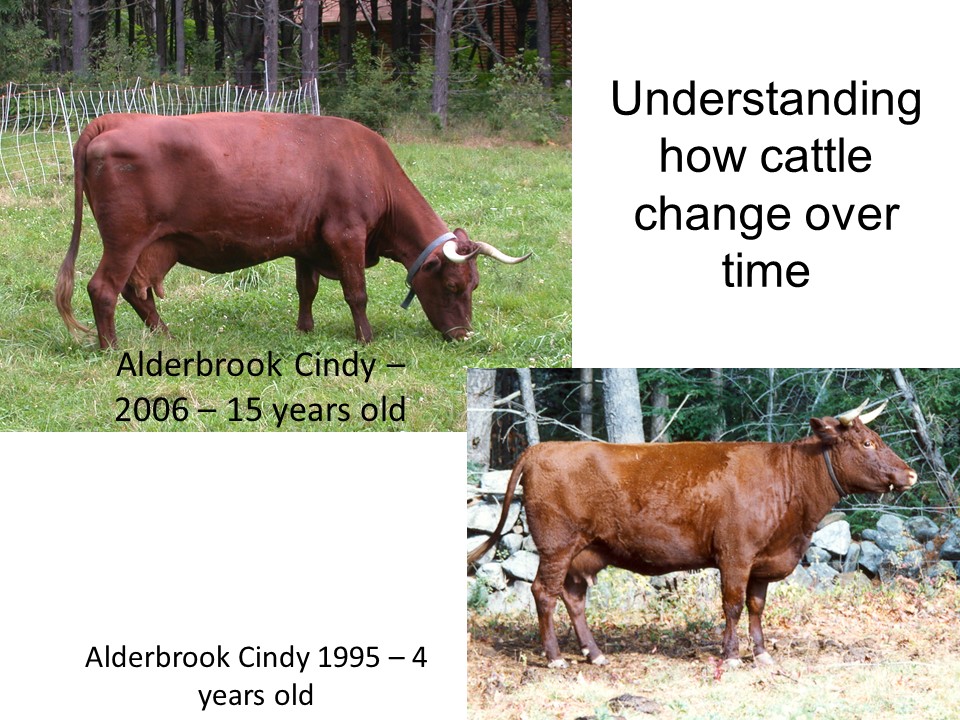
What happens to a cow as she ages? She becomes deeper in the body, the udder drops lower, the teats become larger, and they often dip more in the loin, as with this cow after 11 calves in 13 years.
4-H Youth, FFA students, and college students also have other opportunities to compete with their knowledge of dairy cattle evaluation. They can exhibit the animals, learning both animal behavior and training, but also what it takes to present an dairy cow or heifer in the best possible way in front of a judge.
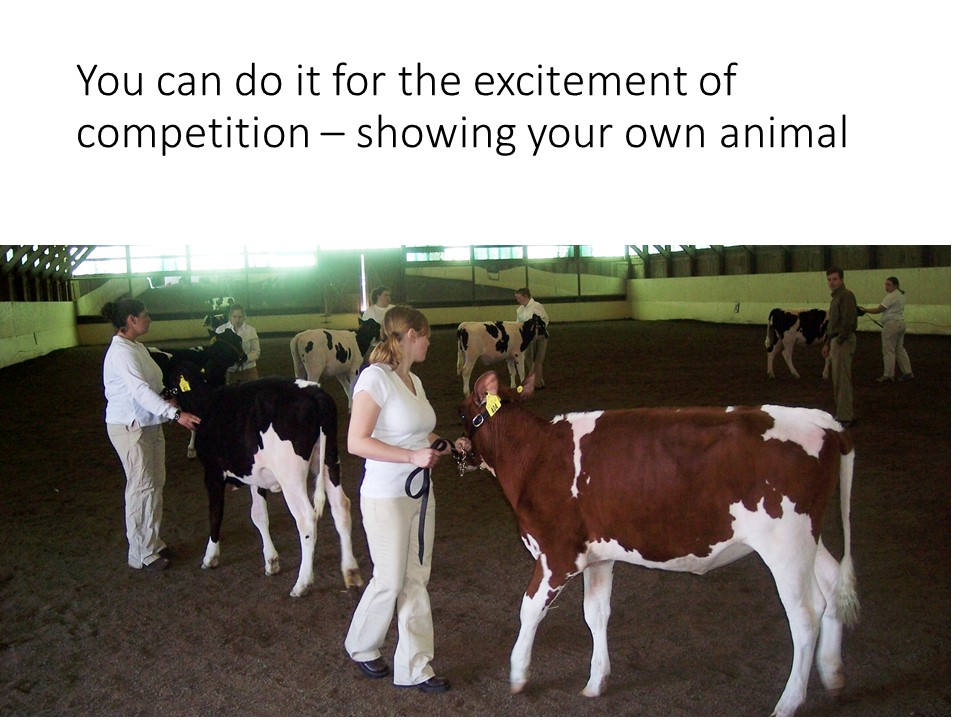
Youth and adults enjoy the challenges and rewarda of exhibiting dairy cattle.
There are also judging competitions throughout the United States. These are often held at agricultural fairs and exhibitions. Some are at the county or state level, others are national events, where high quality animals are presented and teams compete based on their ability to judge and place 4 animals in a class as well as giving oral reasons to justify their placings.
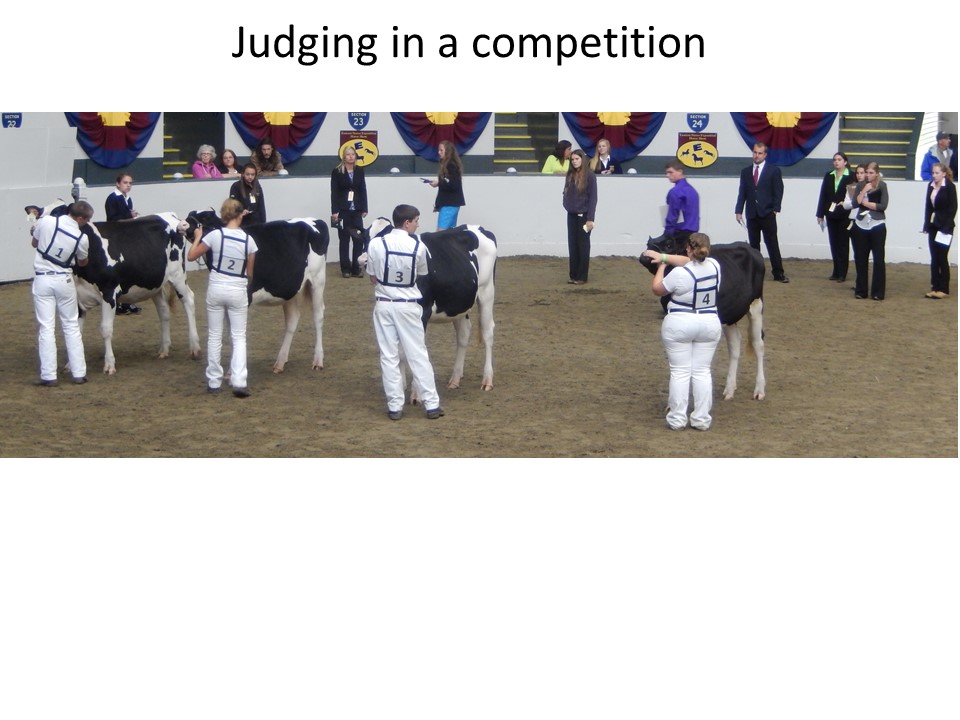
Dairy cattle judging is done in 4-H, FFA and collegiate teams around the USA
Challenges in Learning to Judge Cattle
Some students find qualitative evaluation more difficult than others. Having grown up on a farm does not necessarily make one better at learning to evaluate the cattle based on physical characteristics of the body. It takes practice in learning what is desirable conformation in each of the cow body parts and what is undesirable conformation.
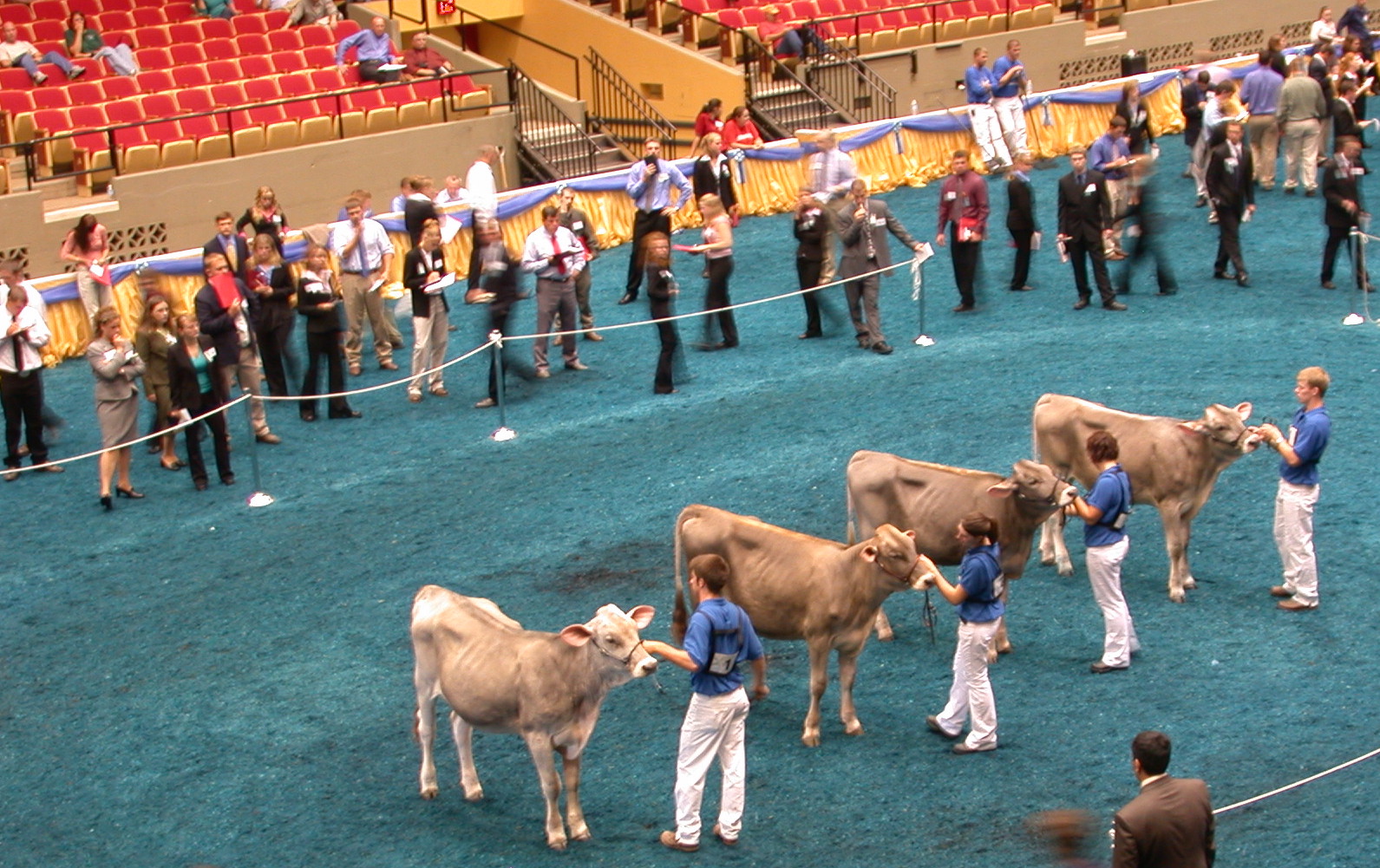
World Dairy Expo, Intercollegiate Dairy Cattle Judging
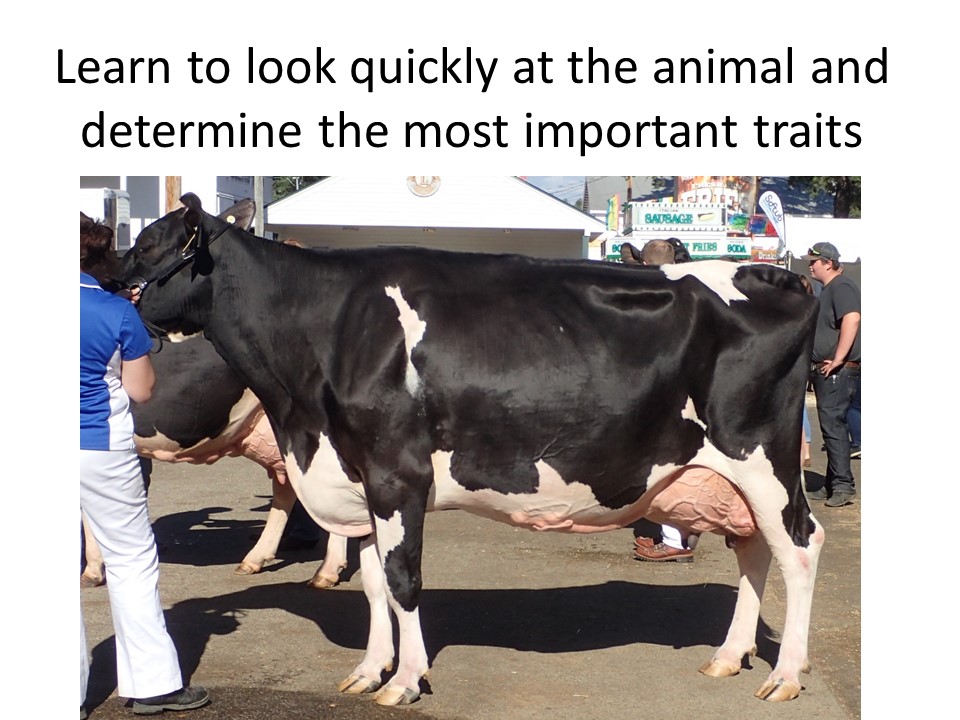
Holstein cow going into a regional show
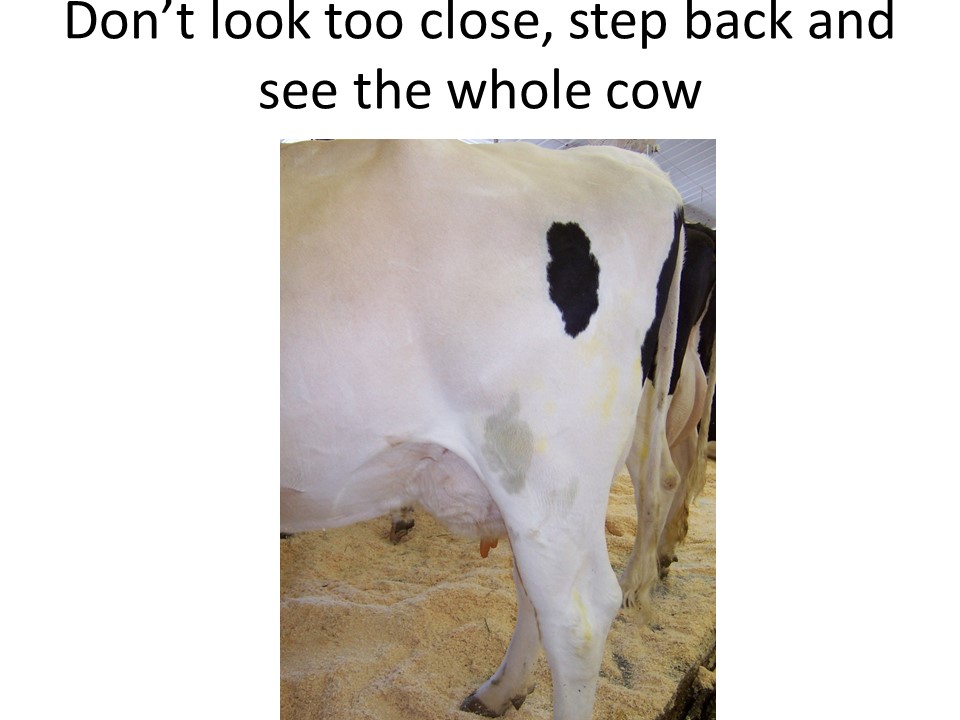
For many beginning judges they crowd the cow and do not see the whole "picture" or animal they are evaluating.
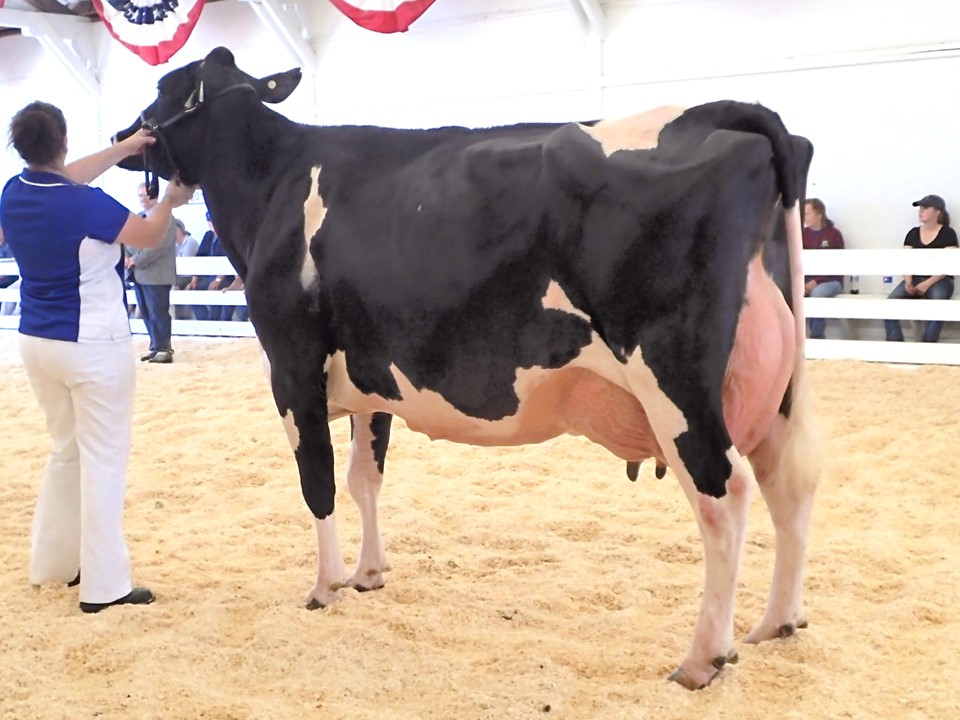
Step back and look at the whole cow, and then the whole group of cows.
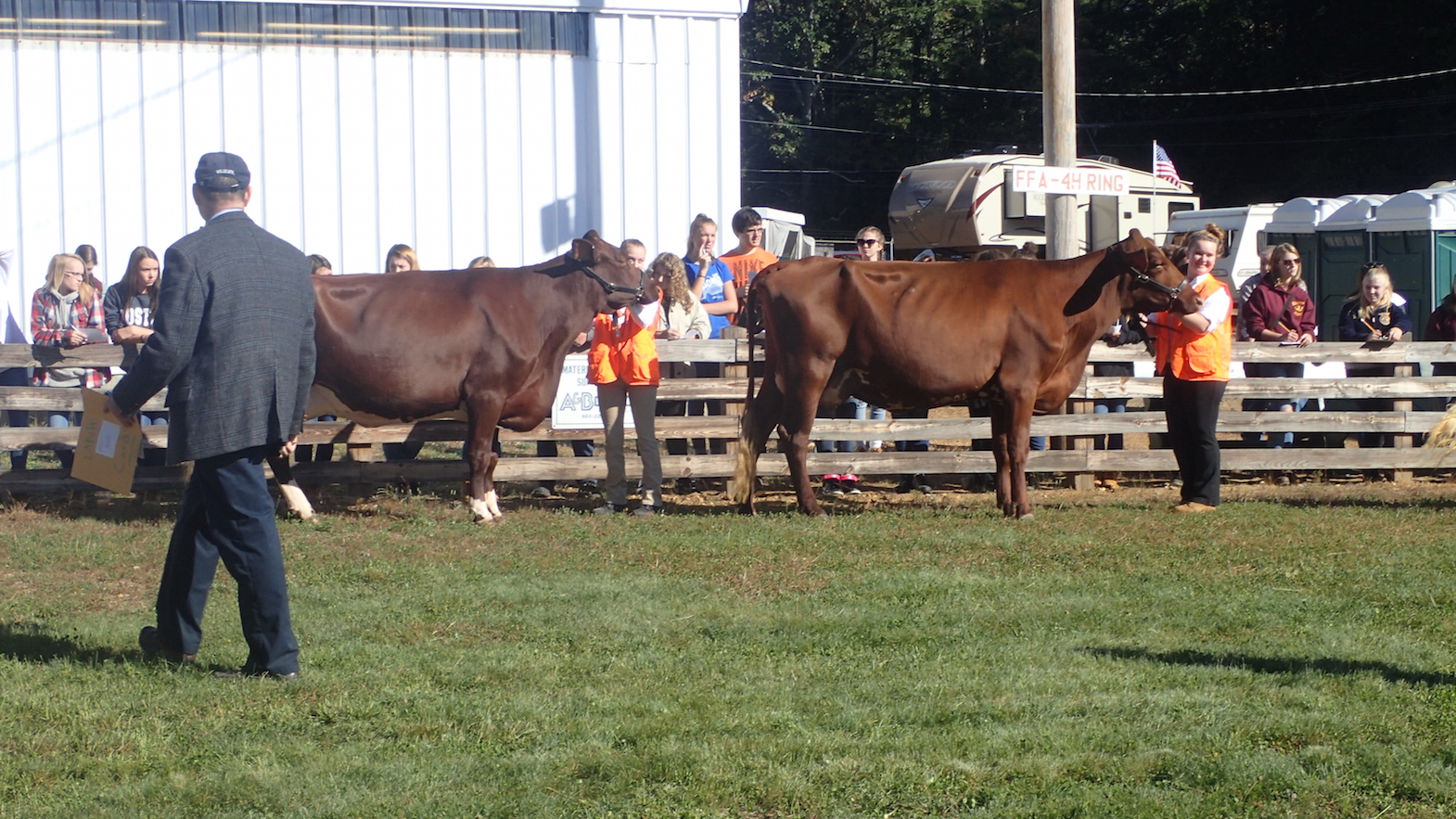
Comparative judging is what is done both on the farm and in the show ring. The judge compares the animal being evaluated to the ideal dairy cow.
Most judging contests where animals are exhibited live, or where they are judged in photographs, such as the Hoard's Dairyman contest present high quality animals. It can be difficult for a new judge to determine differences between high quality animals. The photos presented below and in the section on Live Animal Evaluation provide stark examples of characteristics we do not want dairy cattle to exhibit. The photos, like the one below present extreme examples of what is not desirable. These are really most useful for beginning judges. Competitive judges at state and national events have to learn to look at much finer levels of detail, and use the Purebred Dairy Cattle Association scorecard to determine how to value subtle differences.
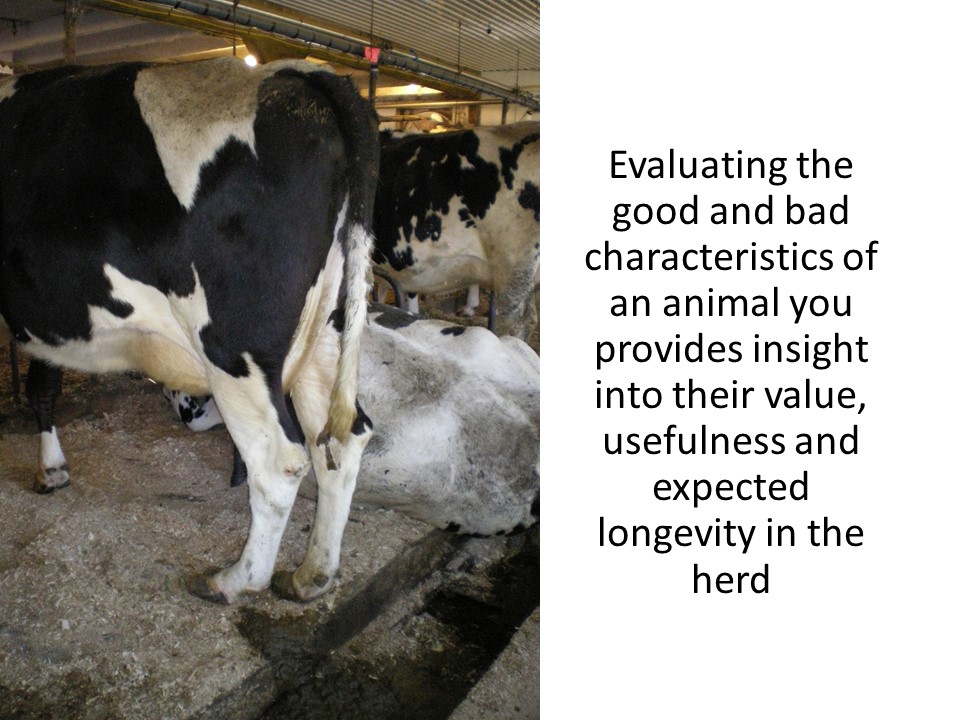
This cow has a strong fore udder attachement, but extremely weak pasterns, which will affect her ability to remain in the herd.
Learning the Body Parts of the Cow
One of the most important things to learn in evaluating dairy cattle is the body parts of the dairy cow. Learning the names and locations of the external body parts of the cow is critical in identifying the most important parts of the cow (related to judging). This helps identify the strengths and weaknesses of the cow in each one of the body parts, but also assures everyone is using the same recognized terminology. Below I will highlight some defects and deviations in body parts. But first learn the simple terms used to describe the various parts of the cow. These diagrams point out a few body parts, there are many more to learn as can be seen in other resources referenced in the first chapter or below in the PDCA Unified Scorecard.
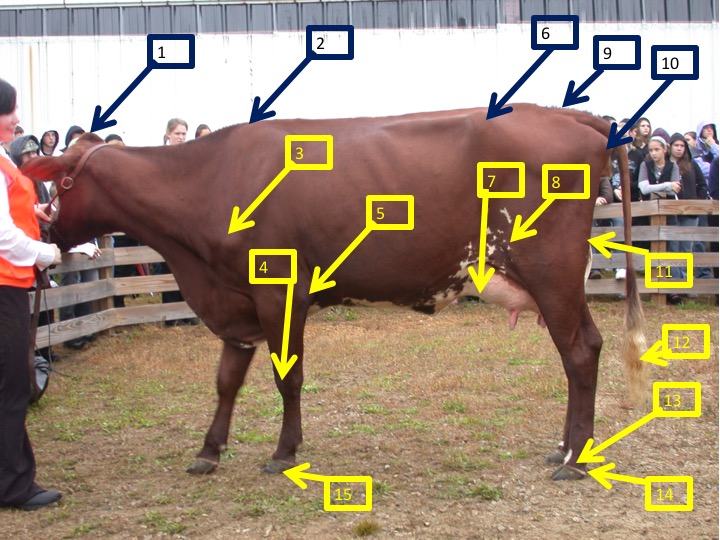
2) withers 3) point of shoulder 4) knee 5) elbow 6) Hip or Hook
7) foreudder 8) stifle 9) rump 10) pins 11) thigh 12) switch 13) pastern 14) heel 15) hoof
1)
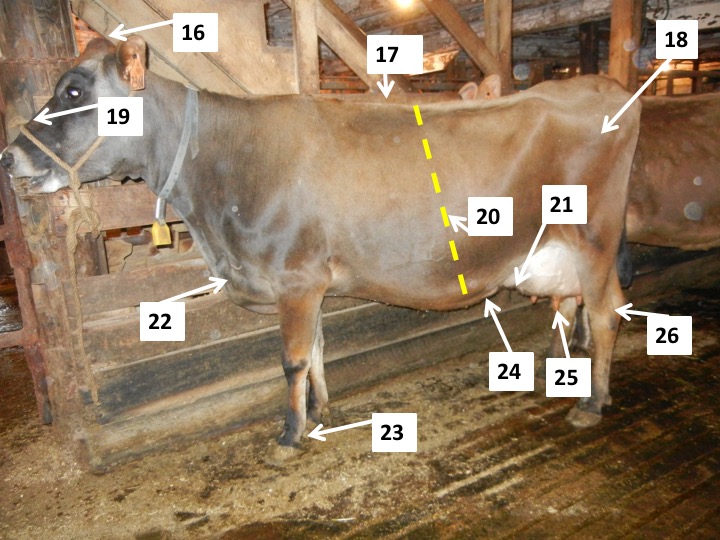
23) dewclaw 24) milk vein 25) teat 26) hock
16)
Chapter 2- The Purebred Dairy Cattle Association (PDCA) Unified Scorecard
When making decisions or choices about anything, whether it be what TV show to watch, which sport team to support, or even which bicycle to buy, there are criteria we use to make these choices. Some of the choices may simply be based on criteria such as personal preference, or possible cultural or family preference. Judging dairy cattle can be similarly subjective (somewhat personally biased). It is very difficult to be completely objective and impartial. However, this is the goal in comparative dairy cattle selection. Farmers have to make choices as to which animal to keep for its genetic and financial value. These will require more objective criteria, such as milk production levels or pregnancy by a certain numbers of days in milk. Sometimes even commercial dairy farmers sometimes keep cattle longer than they should for purely personal reasons. Maybe its keeping a favorite show cow into old age, which would be more subjective. Beware that with this mind, a farmer also has biases when you are judging cattle at their farm. For example, a cow that won first place the previous year at a fair, may in their mind still be the animal they want to see another time. Cattle change over time, may appear different due to feeding or handling, and once you have learned to judge be confident in your skills and bringing outside eyes that use specific criteria as outlined below to judge the animals
The Unified Scorecard provides specific criteria which help dairy judges all use a similar system of evaluation to try to make visual evaluation more uniform and objective. However, it takes practice to learn to evaluate these criteria, and a good teacher, coach or 4-H leader can help people learn to use this system. For the Purebred Dairy Cattle Association (PDCA) complete website with a lot information about judging, ethics and showmanship see: PDCA link
Link to the 2009 (most recent) version of the PDCA Unified Scorecard
The Purebred Dairy Cattle
Association has developed a Dairy Cattle Unified Scorecard, that is the
accepted standard for judging dairy cattle. The idea is that this scorecard
provides a fairly detailed set of criteria in a relatively easy to understand
format. This two-page scorecard offers an excellent guide to the traits that
cattle breeders in North America find desirable with weights or points given to
each trait. The scorecard has changed 5 times since 1943. The changes reflect
desired traits at the time and changes in the cattle. Anyone teaching dairy cattle judging needs to
make sure to use the latest scorecard in instruction. Cattle judged with the 1971
scorecard differed physically in their appearance from the dairy cattle judged using the 2009 scorecard. The
scorecard also has had category changes, for example eliminating a category for General Appearance and new categories with an emphasis on Frame, Rear Feet and Legs as well as Dairy Strength are categories added in recent years. The scorecard’s changes over time has had a direct impact on the physical changes in the conformation and
external appearance of the dairy cattle in the United States and other regions of the world.
The PDCA Unified Score Card highlights 4 categories that need to be evaluated in dairy cows. These are Frame, Dairy Strength, Rear Feet and Legs, and Udder. Each one is assigned a weighting or points toward the total and is subdivided into other characteristics that are to be evaluated.
The scorecard is the basis for dairy cattle judging in the United States, as described in the rest of this document. The section on defects shows the extreme examples from what we hope to see. The images in later sections highlight examples of animals that have desirable and undesirable traits so that a novice judge can practice their visual evaluation skills.
- Frame is worth 15 points out of the total 100 points in judging. This category includes the Rump (5 points), the Front end (5 points), the Back and Loin (2 points), Stature or hieight (2 points) and Breed Characteristics (1 point)
- Dairy Strength is worth 25 points out of the total 100 points in judging. This category includes the Ribs (8 points), the Chest (6 points), the Barrel (4 points), the Thighs (2 points), the Neck (2 points), the Withers (2 points) and the Skin (1 point).
- Rear Feet and Legs is worth 20 points out of the total 100 points in judging. This category includes the Movement of the cow (5 points), the Rear Leg - Side View (3 points), Rear Leg-Rear View (3 points), the Feet (3 points), the Thurl Position (2 points), the Hocks (2 points), the Bone, specifically the flatness of the cannon bone (1 point) and Pasterns (1 point).
- Udder is worth 40 points out of the total 100 points, and is therefore the most important category, even though it comes last on the scorecard. Udder Depth is the single most important sub-trait in any category (10 points), the Rear Udder* (9 points), the Teat Placement (5 points), the Udder Cleft (5 points), the Fore Udder* (5 points), the Teats (3 points), and finally the Udder Texture and Balance (3 points). **The scorecard also notes that the Holstein breed prefers to use equal points for both Rear and Fore Udder (at 7 points each).
Breeds of Dairy Cattle
Any breed of cattle can be milked, but in the United States there are 7 predominant dairy breeds. These breeds have had a history of being used in the dairy industry and are all recognized by the Purebred Dairy Cattle Association. These are the Ayrshire, Brown Swiss, Guernsey, Holstein, Jersey, Milking Shorthorn, with the Red and Whites added in the 1960's to the list of modern dairy breeds recognized in the USA. There are numerous other minor or rare breeds, which tend to be lower milk producers and have less value in the commercial dairy industry. These include breeds such as the American Milking Devon, Dexter, and Dutch Belted. Finally, there are also breeds that have been imported and used primarily for crossbreeding from other parts of the world. Examples include such as the Viking or Swedish Red, the Montbéliarde and Normande from France.
It is often thought that Holsteins are the predominant breed of cattle used for milk production in the world. This is not really true, as there are estimated to be nearly 1.5 billion cattle in the world (2018 FAO), and Holsteins are only numbered in the millions and kept primarily in more developed countries. Which means the vast majority of cattle that are milked are not the breeds of cattle we recognize in the United States, yet can be evaluated by some of the same criteria if they are being selected for milk production.
The following provides information and images about each breed. For anyone judging cattle it is important to be able to be able to identify the common breeds and know what physical and other characteristics make them unique. Learning what the individual breeds standards are, for example, what are acceptable color patterns, sizes of mature animals, and other relevant characteristics is also important. One of the challenges for beginning judges has been breed associations that have opened their herdbooks. This means that they have allowed crossbreeding in order to bring in genetics from higher producing animals of other breeds into their breed. This has allowed breeders to track and later register the resulting offspring when they have reached a certain level of pureblood. This has created some challenges, as breeds are supposed to be identifiable by their physical characteristics. It is a bigger issue in the beef industry with breeds that were brown, white or red, now registering black animals (due to the greater value of Angus beef in the marketplace).
Beginning judges sometimes find the Ayrshire, Milking Shorthorn and Red and Whites look similar. However, by studying characteristics in the Unified Scorecard and the live animals, or photos, characteristics such as average size, color and overall body shape, a group of Ayrshires can easily be distinguished from a group of Milking Shorthorns. Jerseys are sometimes confused with Brown Swiss among beginning judges. Again, closely studying the head shape, average body size, angularity and color patterns helps beginning judges identify the two breeds.
Ayrshire
The Ayrshire breed is medium in size with mature cows generally weighing between 1200-1400 lbs, and their color as defined by the PDCA is "light to deep cherry red, mahogany, brown or any combination of these colors with white or white alone. .Distinctive red and white markings are preferred." The US Ayrshire Breeders Association says, "The spots are usually very jagged at the edges and often small and
scattered over the entire body of the cow. Usually, the spots are
distinct, with a break between the red and the white. Some
Ayrshires exhibit a speckled pattern of red pigmentation on the skin
covered by white hair." [4]This is slightly different from the Milking Shorthorn where red and white colors will more often mix into a roan color. The Ayrshires also tend to have darker colored noses than the Red and Whites or Milking Shorthorns, where pink or lighter colored noses are preferred. The Ayrshire tends to be an active and alert animal, whose temperament can stand out to people not used to working with these animals. Their active temperament has made them stand out as efficient and aggressive grazing animals. The breed originated in Scotland and has been in the United States since 1831[5]
For more information see Michigan State University series - Ayrshire Breed or US Ayrshire Breeders Association
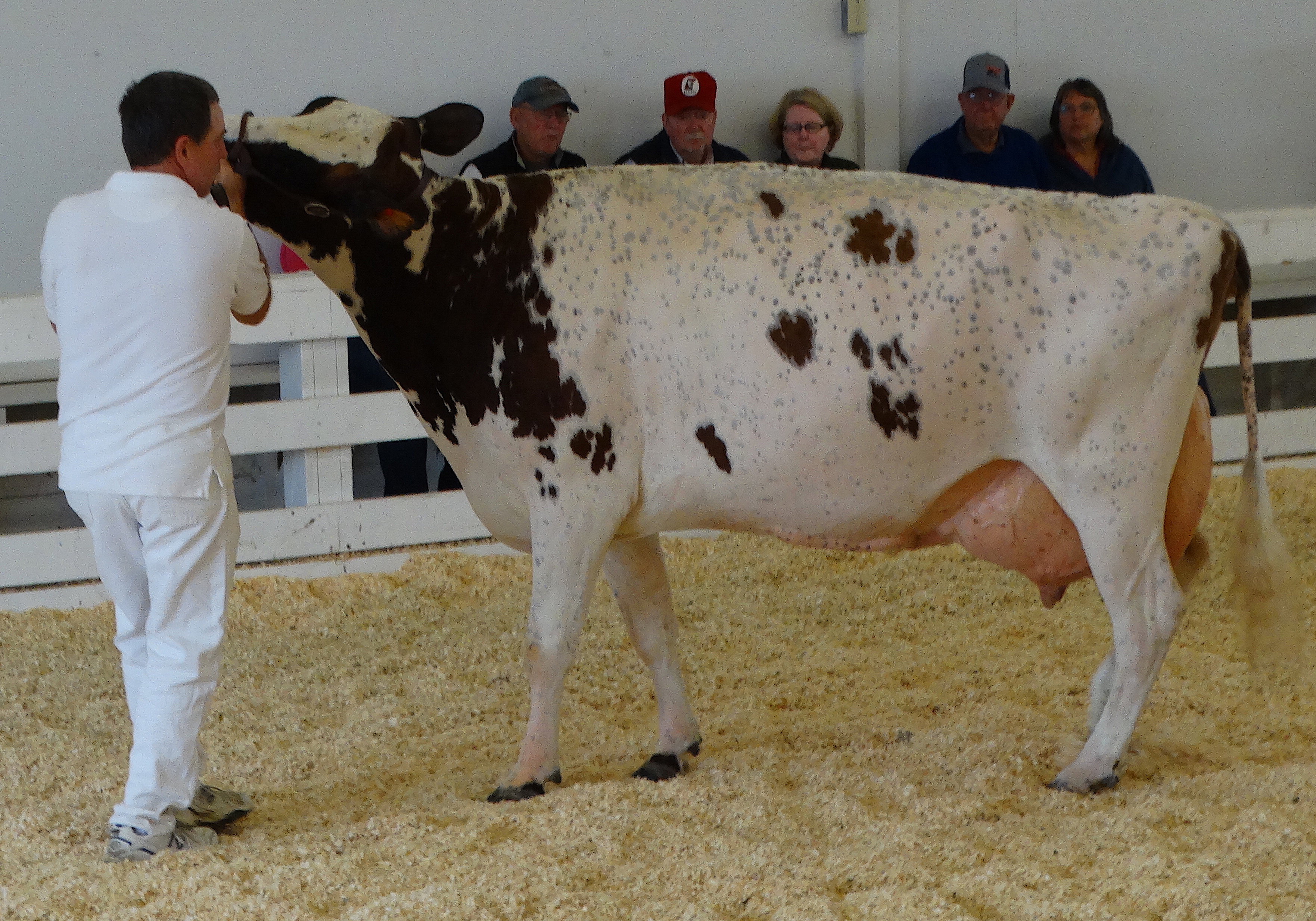
Mature cow showing the medium size of the breed
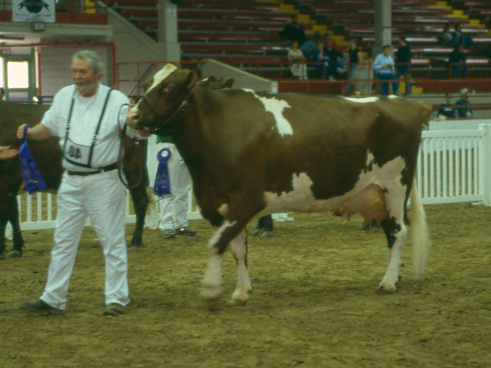
Syracuse, New York Spring Dairy Show
Brown Swiss
The Brown Swiss is a large breed of cattle, with more rugged features than other breeds, particularly in the feet and legs. This is a distinguishing feature that can help novice judges tell the difference between the Brown Swiss and the Jersey Breed. The body and tail switch are solid brown varing from light fawn, to greyish brown or a very dark brown color. The muzzle has a white ring around it, with a black or very dark brown nose, tongue and hooves. [6] Bulls tend to be darker in color and the Brown Swiss tends to almost change shades of brown with age and even season. Animals on pasture will tend to lighten in color. Their coloration is also different than the Jersey in that no white patches or black spots are allowed. They rival the Holstein in size and weight, and according to the PDCA scorecard should weigh at least 1400 lbs. Yet many animals will weigh 1600 lbs. and more. During their dry period if carrying excess body condition it is not uncommon for cows to weigh almost 2000 lbs. Their size and solid brown color makes them stand out as distinctly different than other breeds. Their ruggedness has been somewhat discouraged in the show ring in the United States, as modern show animals tend to show more refinement and angularity than animals in the past. However, they are still noted for their strong feet and legs, and the ability to tolerate both cold and hot climates. This has provided the breeders with many international markets. The first Brown Swiss were brought into the United States in 1869.[7] For additional breed information see: Michigan State University Series - Brown Swiss breed or The Brown Swiss Association
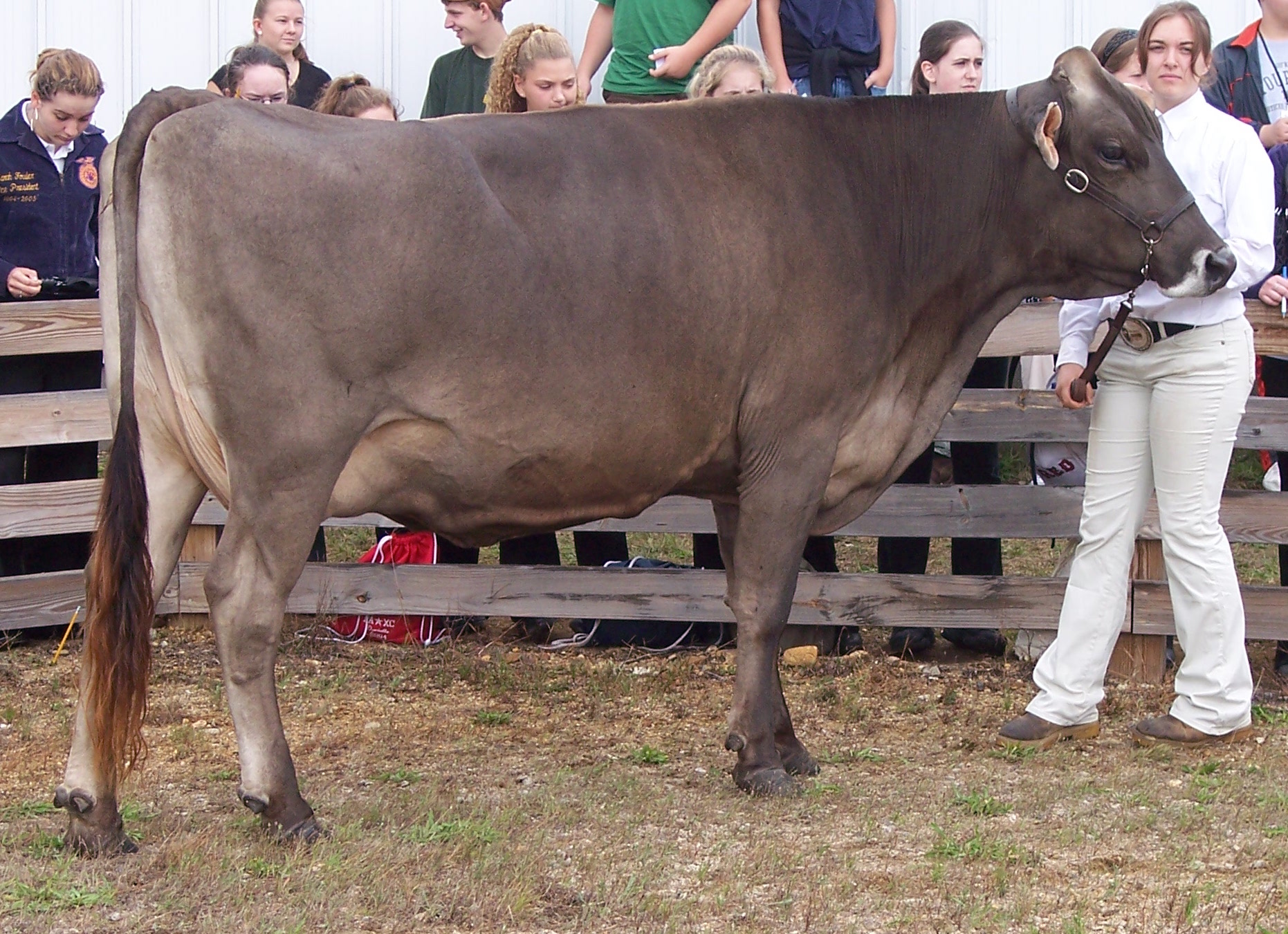
This Brown Swiss cow shows the solid coloration and ruggedness typical of the breed.
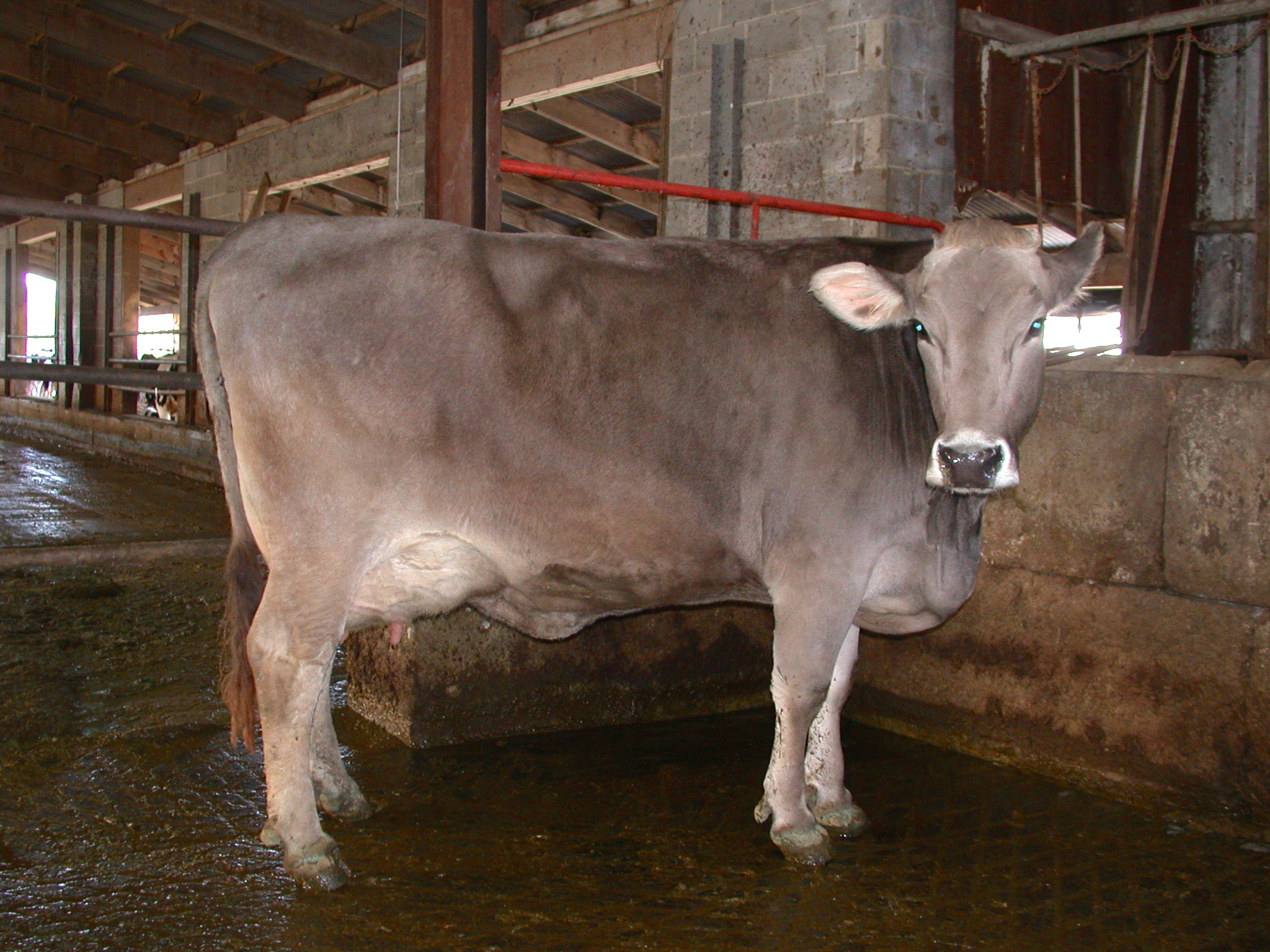
Showing the size and ruggedness that makes the breed unique and easy to identify
Guernsey -
The Guernsey is a breed that is medium in size, and often a lighter brown with distinct white patched, when compared to breeds such as the Ayrshire or Red and White. They historically had pink noses, which helped to make them easy to identify, but today dark colored noses are more common. The breed is known for its angularity and dairyness, more often being free of excess flesh compared to some of the other breeds. They are larger than the Jersey and their temperament is known for being calmer and easier to handle than other breeds. They tend to have finer bones than the Holstein or Brown Swiss, with lower hoof angles. They are not as commonly seen as other breeds in smaller county and regional shows in the United States. For additional information see: Michigan State University Series - Guernsey Breed or American Guernsey Cattle Association Website
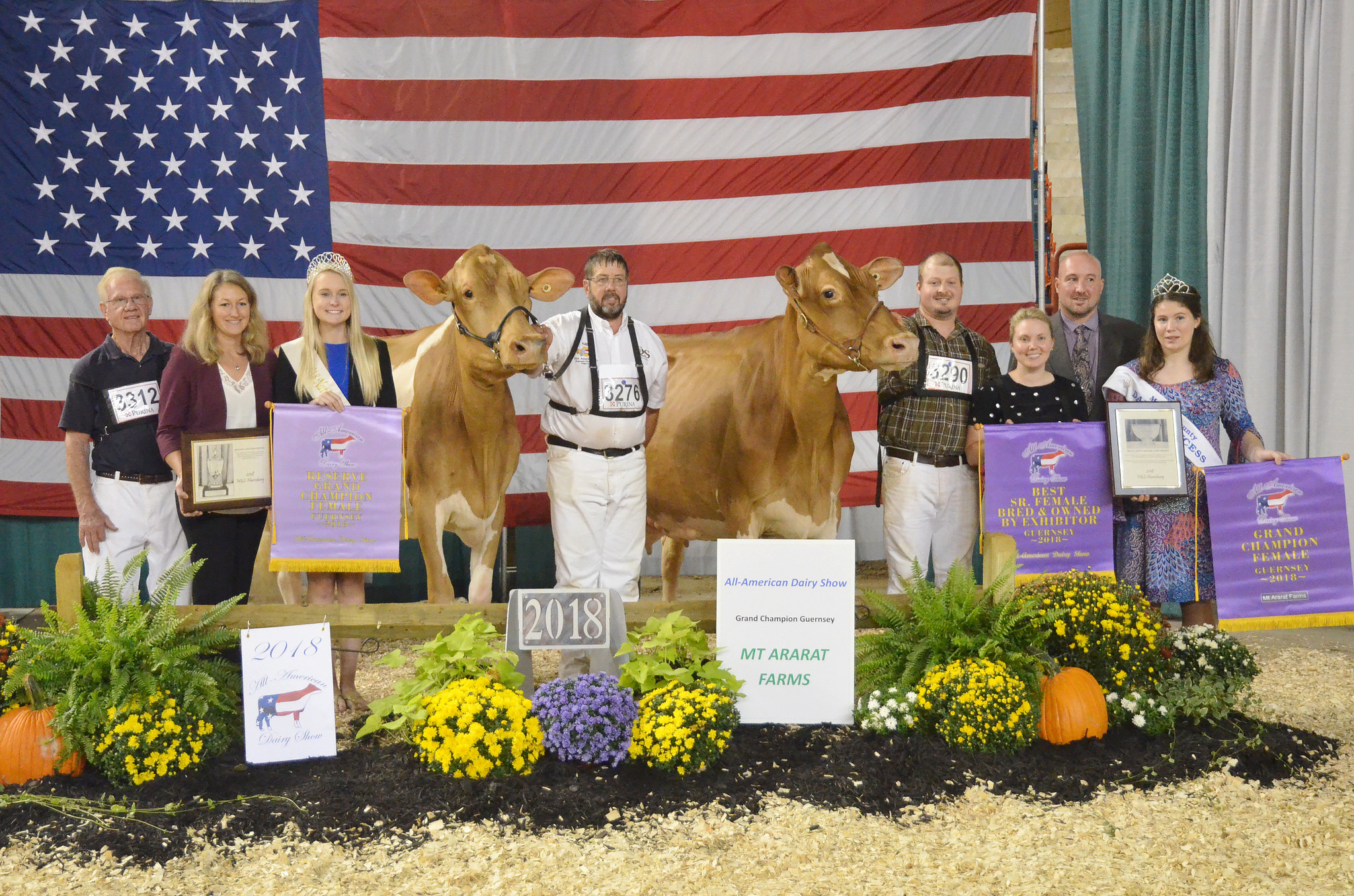
The Guernsey is know for its calm disposition and light brown or fawn color with white patches. This photo is not by the author, but was found at: https://www.flickr.com/photos/152239955@N03/44762012612/in/album-72157701292448774/. Licensed Creative Commons Attribute 2.0 Generic.
Holstein
Holsteins are the most common breed of dairy cattle in the United States, making up more than 90% of all dairy cattle. They can be found all over the world, with their highest animals numbers in more developed countries, due to their need for good care and management. Their large size and black and white color are easy to identify, although Red Holsteins seem to be gaining in number. Their black and white or red and white colors are supposed to be clearly defined. Found in all 50 states, the Holstein breed displays a great deal of variation in their conformation, particularly regarding the udder, feet and legs, and size. However, with millions of animals to select from there are many cows that show outstanding conformation. Holsteins are the highest milk producers, with averages over 25,000 lbs./year and the world record breakers, being Holsteins that made more than 74,000 lbs. of milk in one year. Mature Holstein cows are supposed to weight at least 1400 lbs, but individual cows can weigh up to 1800 lbs. or more. For additional information See: Michigan State University Series about the Holstein Breed or Holsteins USA website
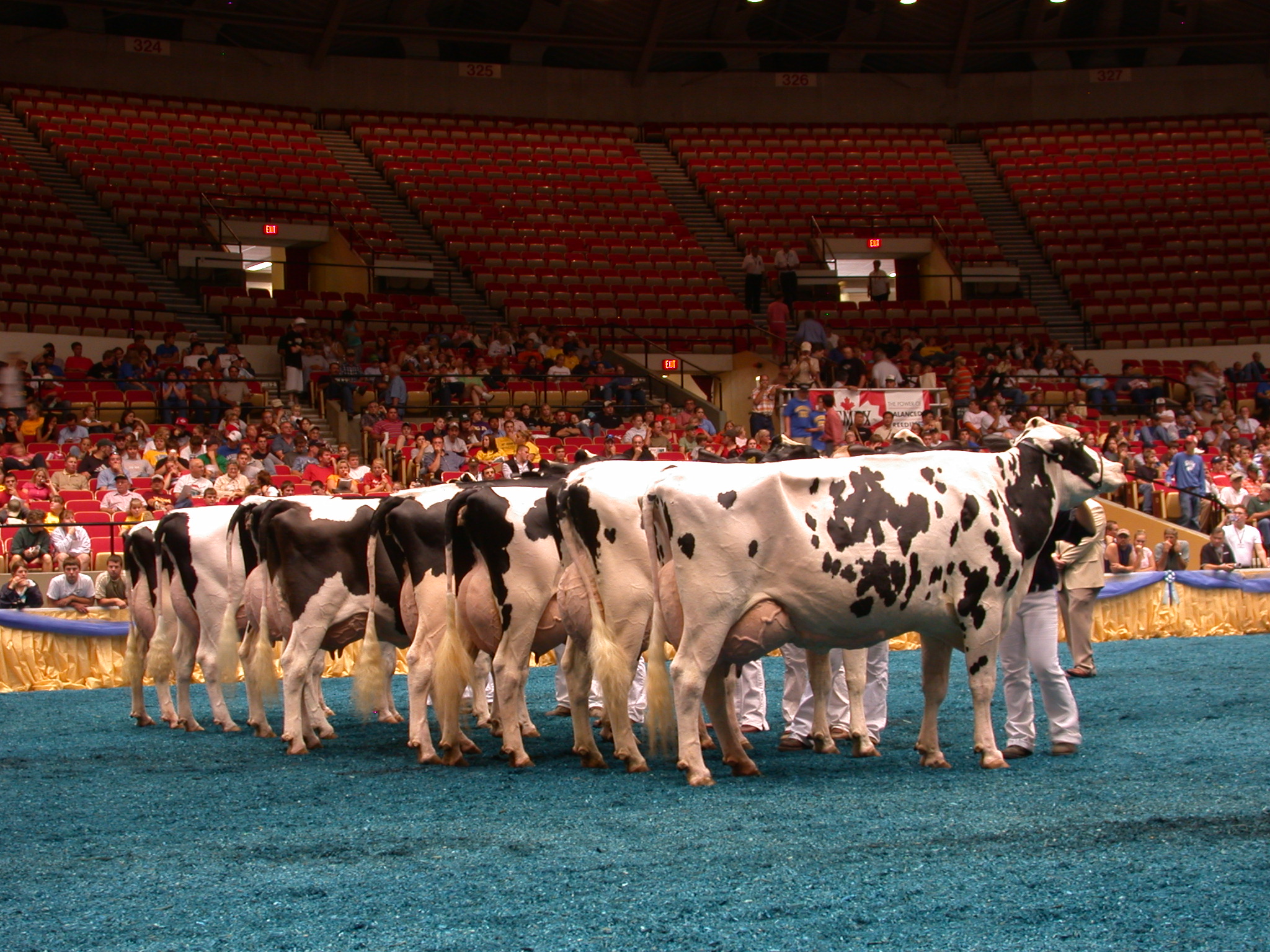
Mature Holstein Cows at the World Dairy Exposition, in Madison, Wisconsin
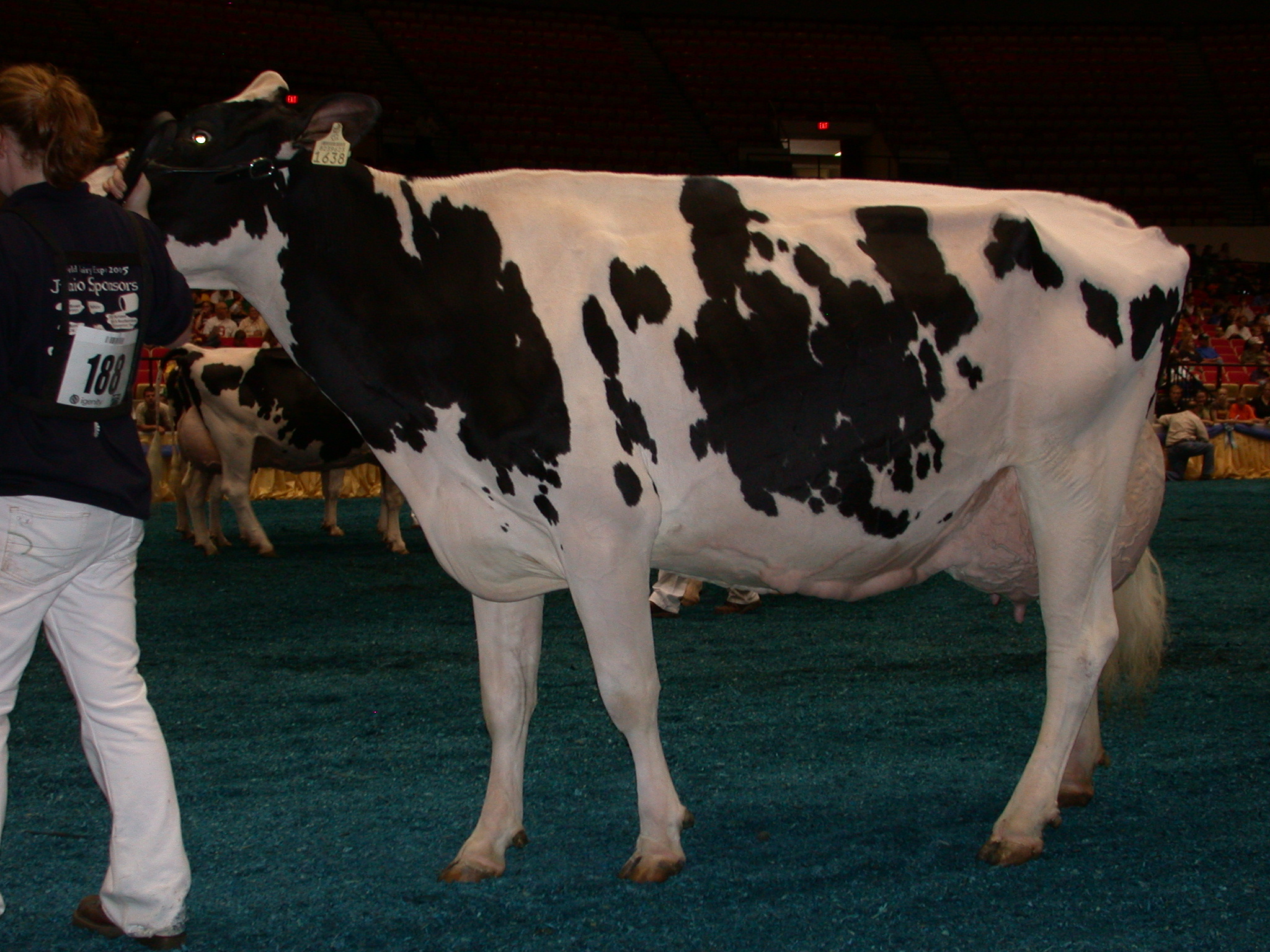
Holstein Exhibited at the World Dairy Exposition, Madison, Wisconsin
Jersey
Jerseys are the smallest of the major dairy breeds in size. Anyone that has raised them with other breeds know their temperament is anything but small. Their adaptability, longevity, and lack of calving problems, combined with the highest protein and butterfat levels in milk make them the the second most popular breed of dairy cattle in the United States and common all over the world. Despite their smaller size their average milk production levels are higher than some of the larger breeds such as the Ayrshire and Milking Shorthorn. The cows should weigh at least 1000 lbs, and tend to be lean and angular when lactating. The breed is the second most common dairy breed in the United States, giving breeders more options for selection due to the genetic diversity in a greater number of animals than other breeds such as the Ayrshire, Guernsey, Milking Shorthorn. Historically the breed was developed from what were called Alderney cattle in the United States and Jerseys as a breed were imported after 1850. For more information about the breed see: Michigan State University series - Jersey Breed or The American Jersey Cattle Association
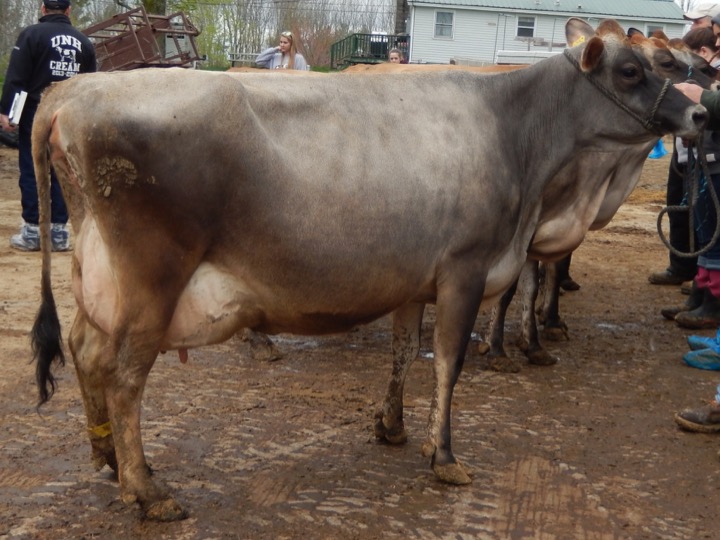
Jersey Cow from New Hampshire 2017
Milking Shorthorn
The Milking Shorthorn is a breed that was developed in the United States from the Shorthorn, which was historically a multi-purpose animal, bred for meat, milk and draft purposes. In recent decades the breed has worked to increase milk production by more intensive selection among the breed, and opening its herdbook. This allowed the introduction of genetics from the Red Holstein and Red and White. This has resulted in animals with more desirable udders, higher levels of milk production, and also more dairy character or angularity and taller animals. They are heavier boned than the Jersey or Guernsey and tend to carry more flesh late in their lactations as well. The Milking Shorthorn can be found across the United States, but regionally it is represented in higher numbers in the Northeast United States. For additional information about the breed see: Michigan State University series - Milking Shorthorn breed or the American Milking Shorthorn Society
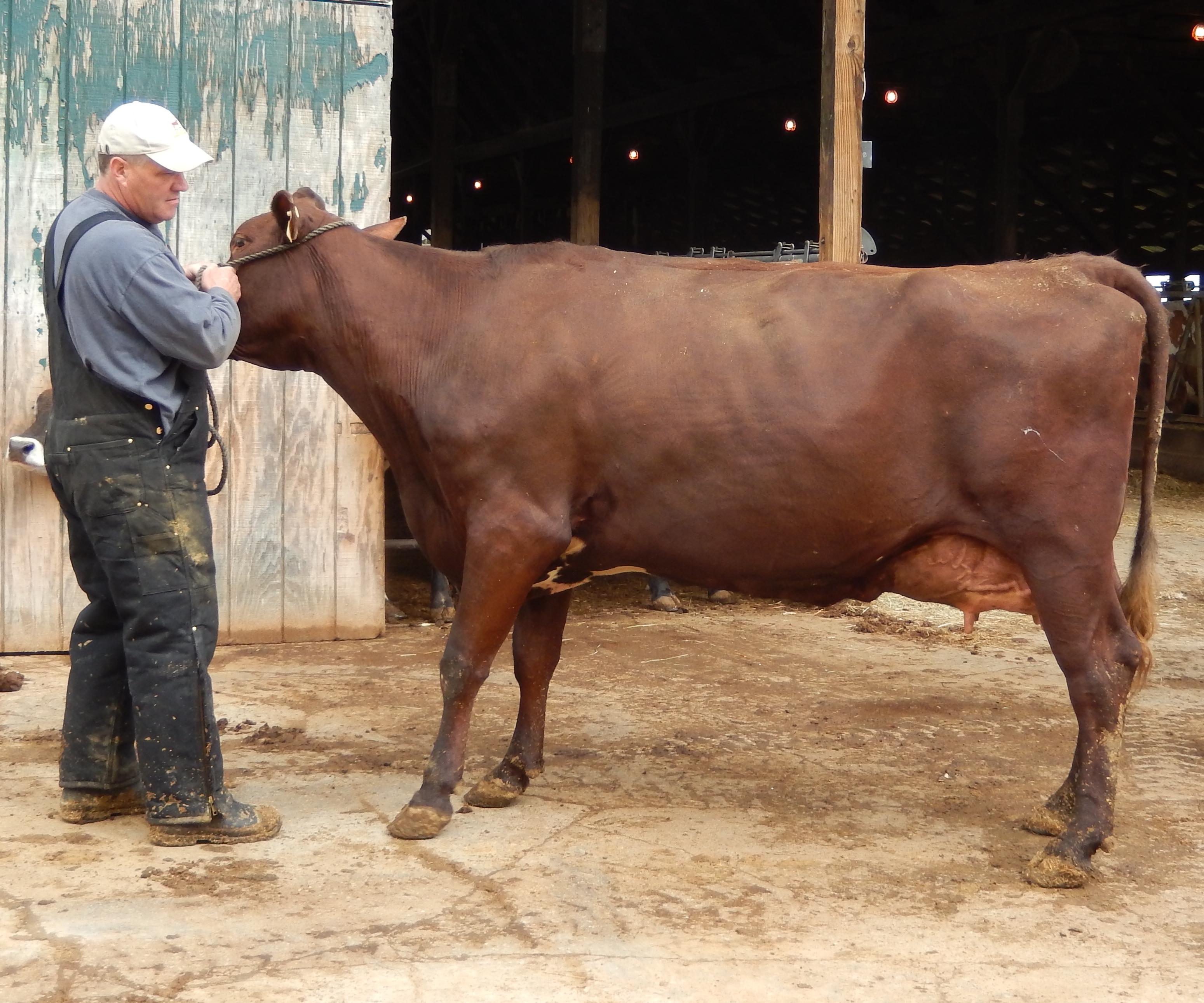
The Milking Shorthorn is a medium to large sized animal.
Red and White
The red and White breed is unique in that is a breed that was developed by Milking Shorthorn breeders in the 1960's using Red Holstein and Ayrshire genetics. Historically Holstein breeders did not want to have red calves or in some cases even want it known that they were "red genes" in their herd or association. The Red and White breed was in developed in part started to allow Red and White animals to have a registry. Times have changed and today the Holstein breeders openly allow and some promote Red Holstein cattle. However, this breed. The cattle tend to be smaller on average than Holsteins, depending on the breeding and lineage of the animals. However, like other breeds, as can be seen in the video below the quality of the cattle is as high as other breeds. For more information check out: Michigan State University series about the Red and White Breed
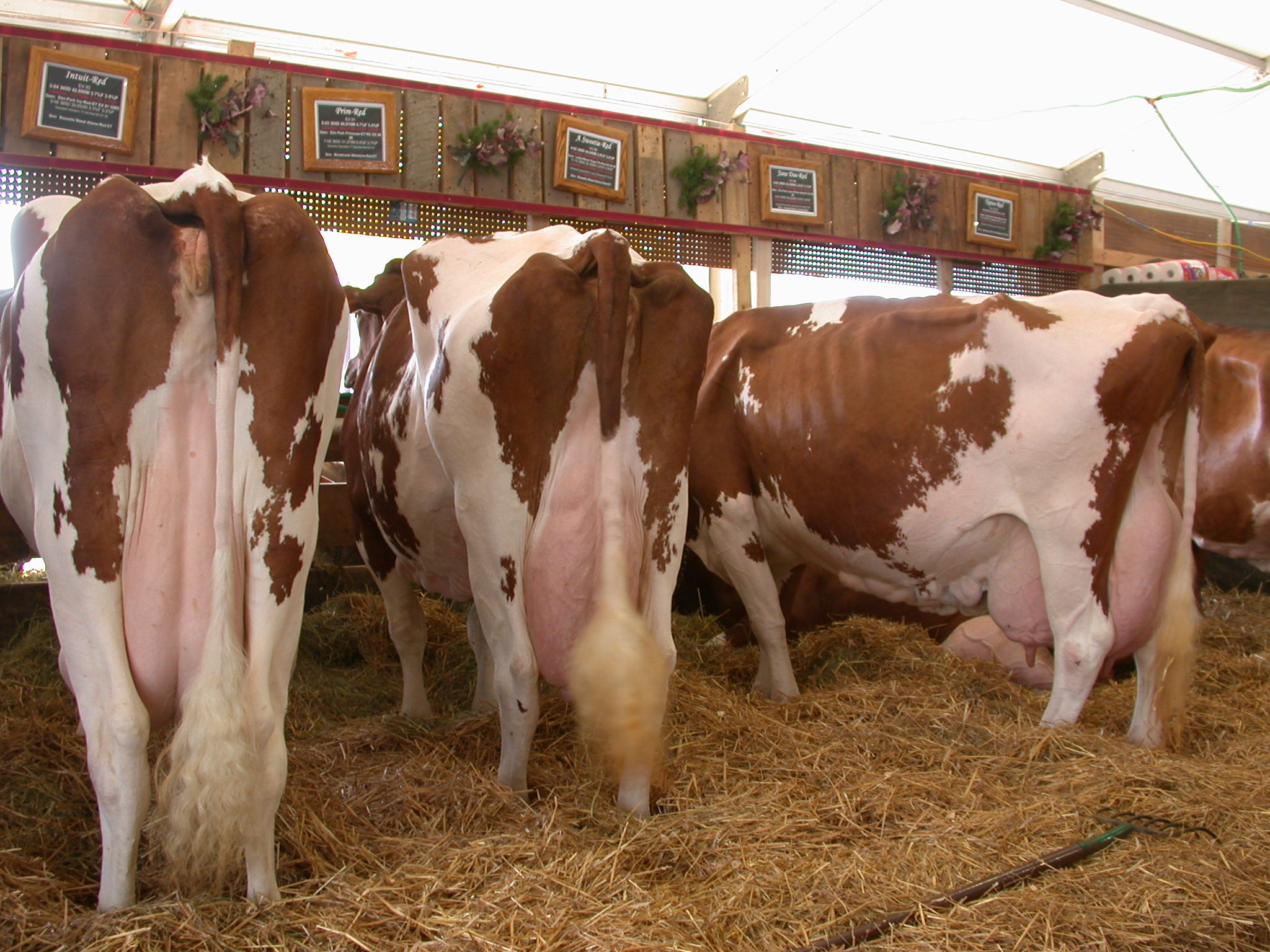
A group of mature Red and White Cows
Breed Quiz - Look at the following photos and identify the breed of dairy cattle
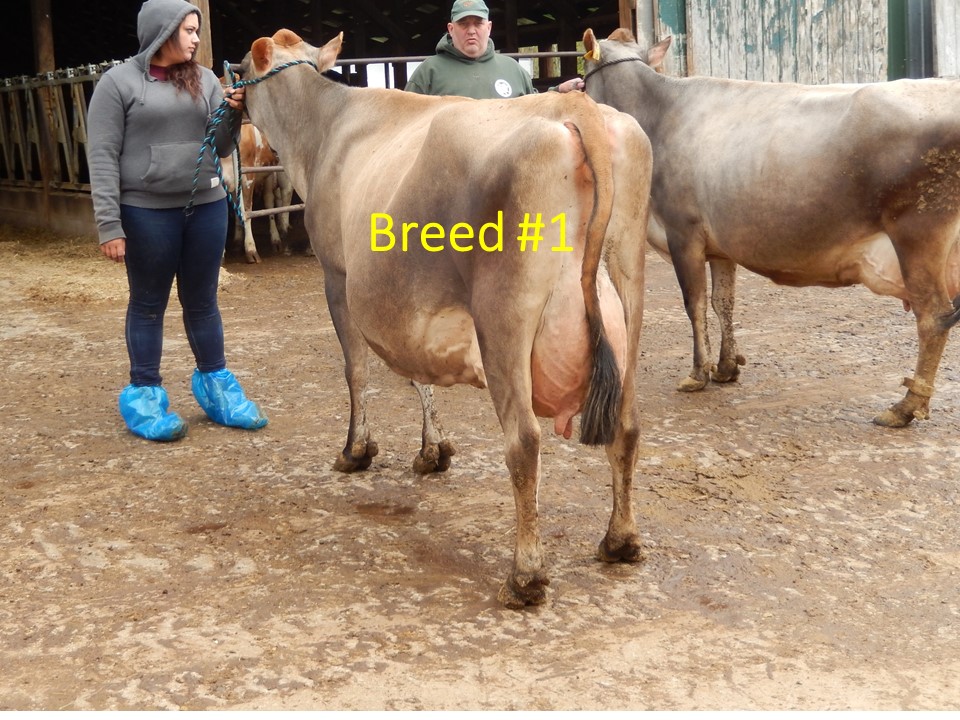
Look at the color as well as the size of the animal to help you Identify the breed
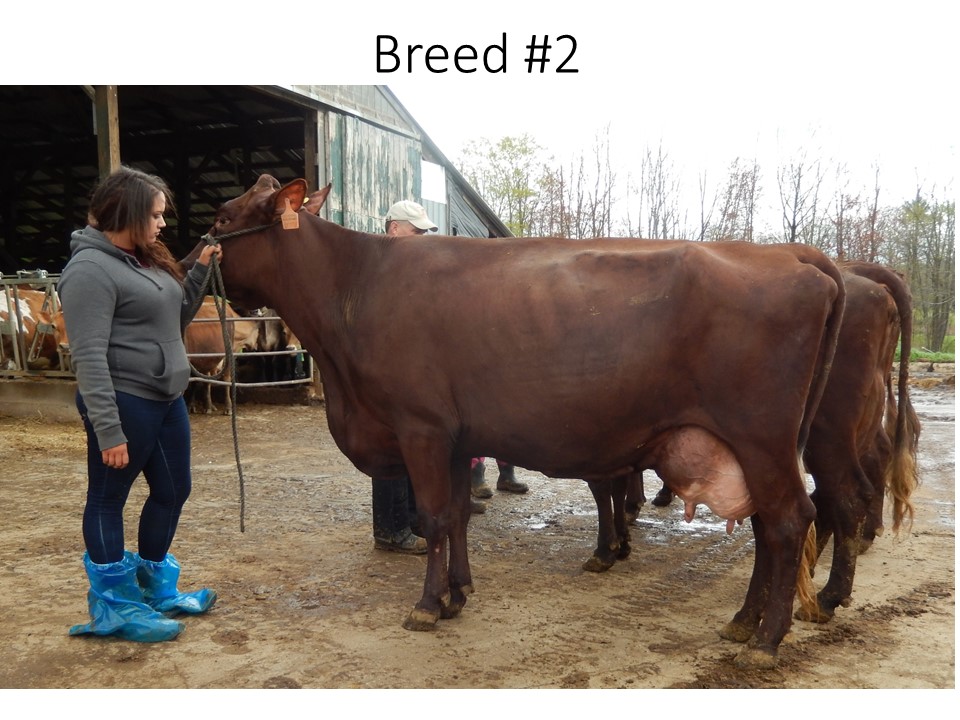
Look at the color, especially across the group of animals, and also note the size of the cows.
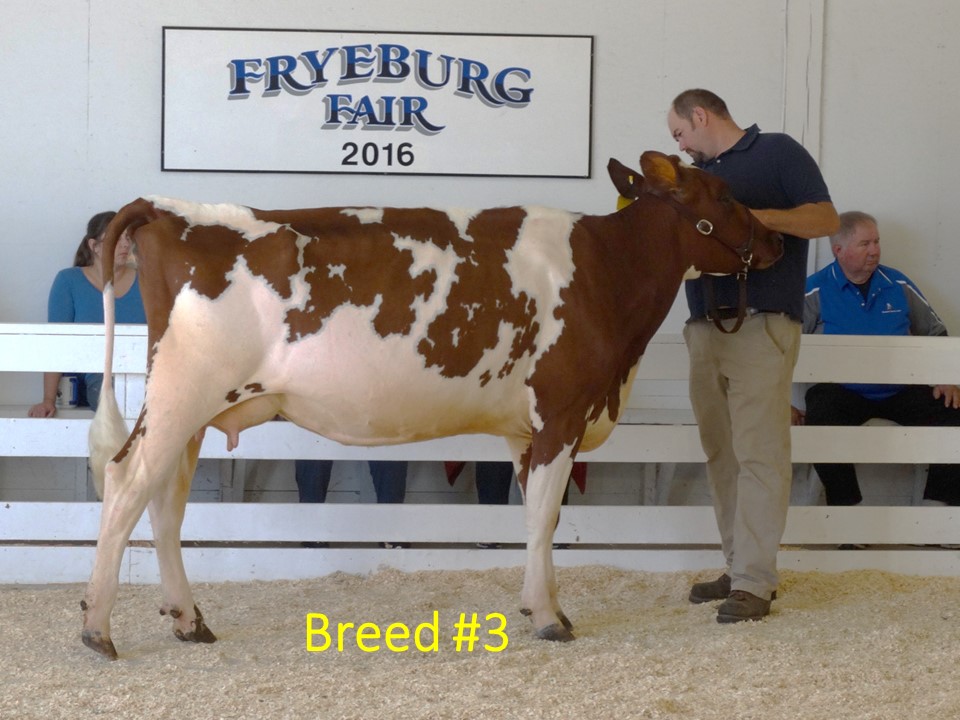
This is a younger cow, only 2 years old, but her size and color should help you identify her
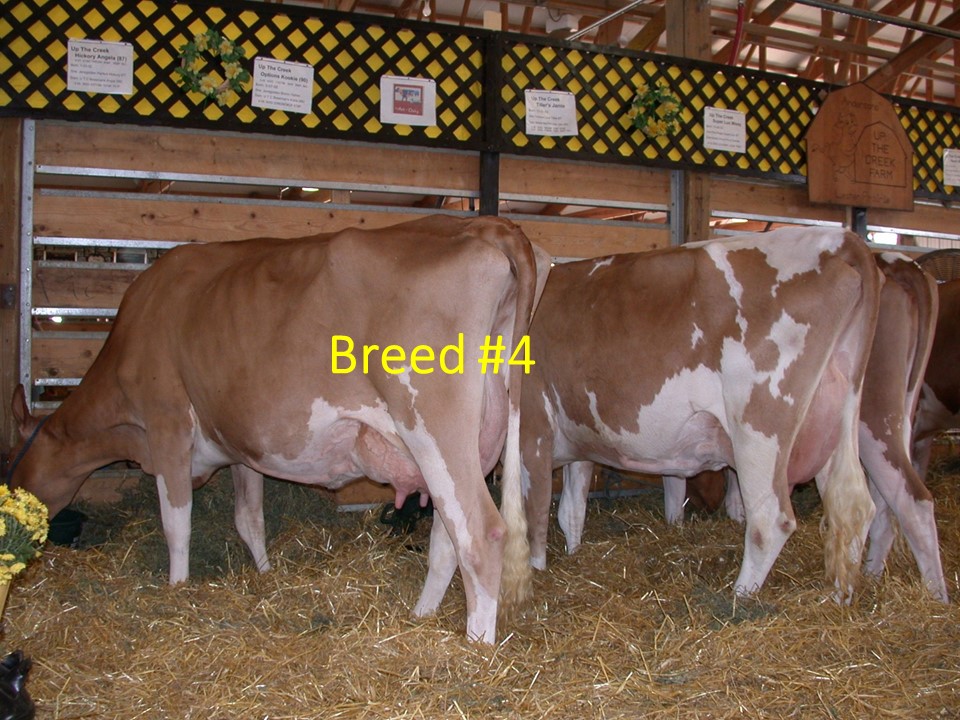
While you cannot see the head, this breed tends to be a lighter brown or fawn color with white patches.
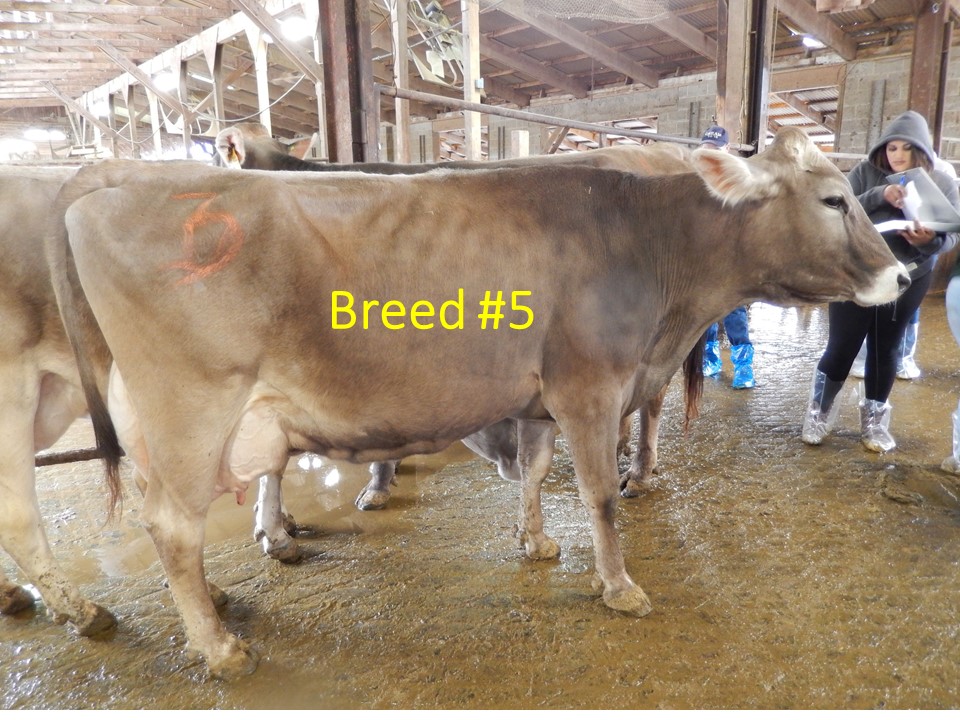
The person in the background is the same person in the photos with the first two breeds. Use this as a comparison of the cow's size
Less common, Rare and/or Heritage Breeds
There are many more breeds of cattle used for dairy purposes than what are listed above. In recent year breeds have been imported for crossbreeding from Europe, such as the Viking or Swedish Red, See: Viking Red Website or the Montbeliarde See: Website for the Montbeliarde Breed and others such as the Normande See: Normande Website There are other breeds that are milked in places like India and Asia that are not breeds we might recognize in the United States. The following are a few examples of breeds sometimes used by farmers in the USA who are part time and generally are not marketing milk commercially, but want to have a family cow or a breed that is different or more rare than the breeds listed above.
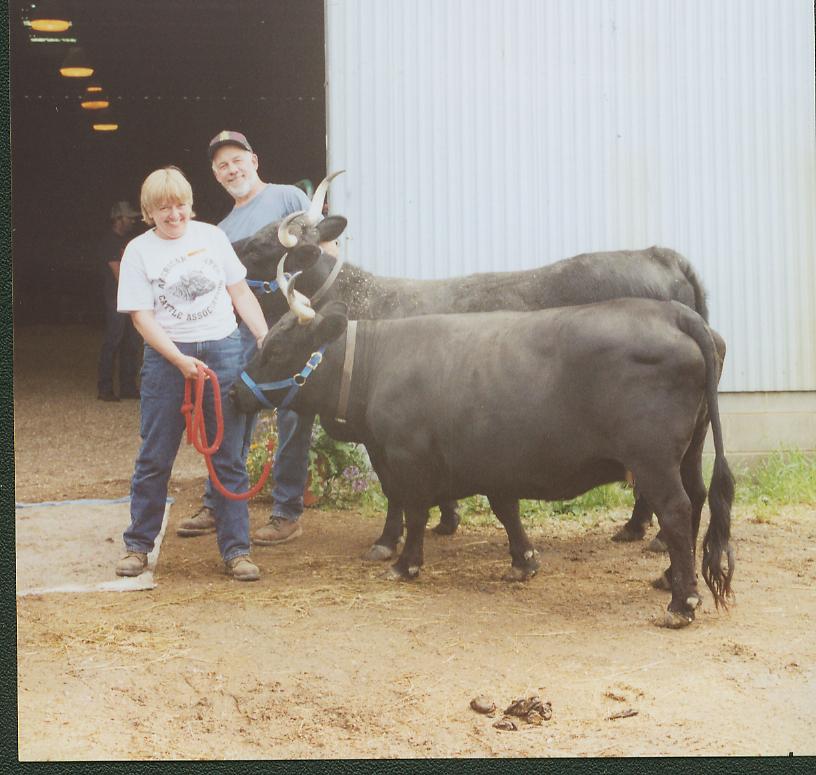
The Dexter is a breed that originated in Ireland and has found a niche in the United States among small hobby farms.
For more information about the Dexter Breed see: American Dexter Cattle Association and The Livestock Conservancy - Dexter Cattle
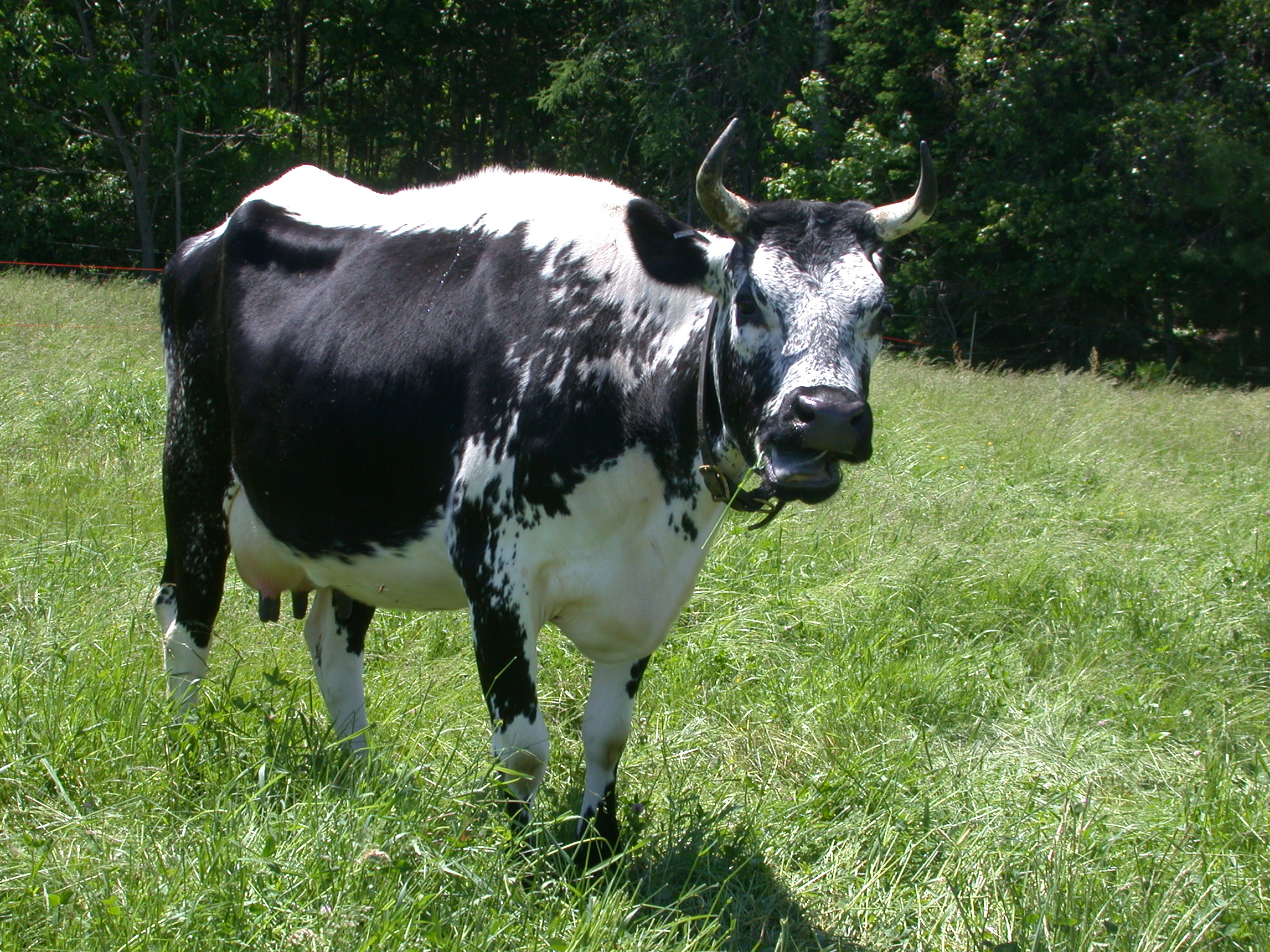
This is a rare breed that was developed in the United States, with a delightful temperament, which has found a niche on small farms.
For more information about the Randall Lineback see: Livestock Conservancy - Randall Lineback and
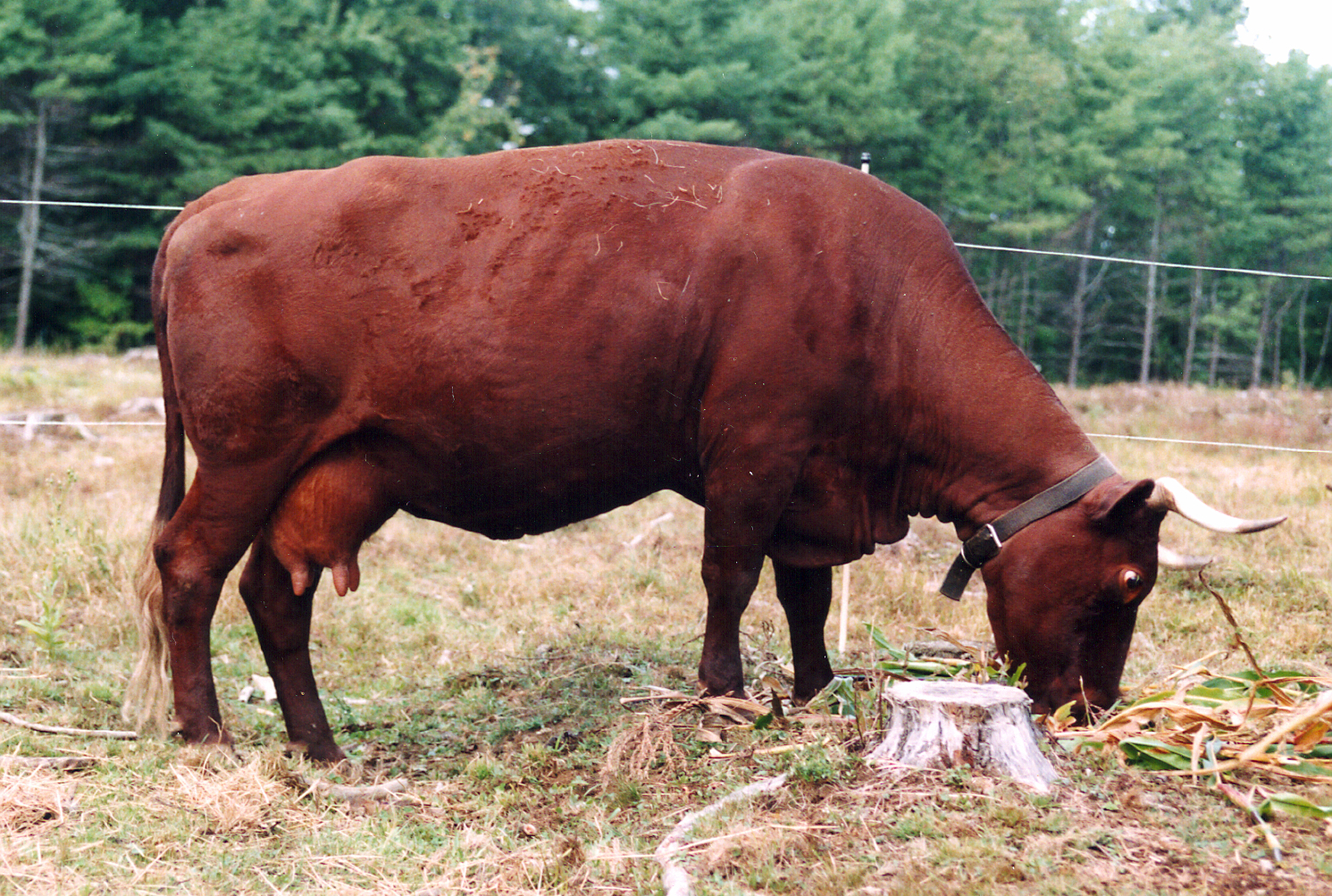
The American Milking Devon has retained its original triple purpose traits of dairy, beef and draft. The breed is smaller than the Beef Devon and South Devon, which have focused exclusively on modern beef traits. They are found on small farms where a few cows are kept. They tend to be more high strung than other breeds.
For more information on the American Milking Devon Cattle see: American Milking Devon Cattle Association and
Livestock Conservancy - American Milking Devon
For a brief history of the breed See: Link to History of the American Milking Devon
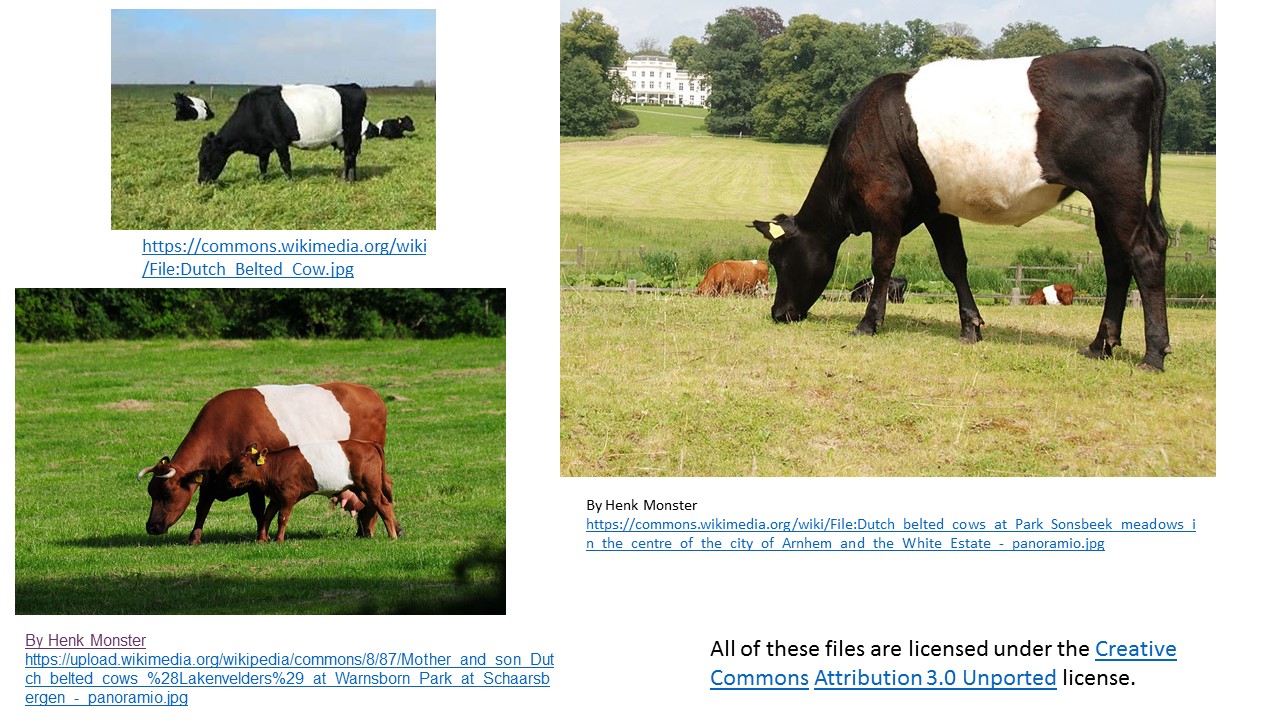
These are Dutch Belted cattle, all taken in Europe, but they are found in the USA
For Information about the Dutch Belted Breed see: Article Progressive Dairyman Dutch Belted Breed and
The Dutch Belted Association of America
Chapter 3- Live Animal Evaluation for Defects and Deviations -
For beginning dairy judges, it is often easier to see the major faults of animals, especially when one has limited experience in viewing animals on farms or in shows. Evaluating major defects or faults in the animals can help a judge at any level quickly make a decision as to whether the animal has enough merit or quality to place in the show or for a farmer deciding which animals are to be kept in the herd or culled. Some faults are extreme, and will affect an animal's ability to move, reproduce, and produce milk without problems. Examples would be heifers that are extremely weak in the legs, especially the rear legs. A dairy cow could remain productive for more than a decade, but in order to do so they have to be able to support an udder that will weigh over 100 lbs, meaning the rear feet and legs have to be strong enough to do so. Animals with extremely weak pasterns or those that are sickle hocked as heifers, will not have the conformation that would allow them to last in a modern dairy herd. View the following photos, which show examples of undesirable characteristics in dairy cattle. While the faults in the following photos are easy to see,this is intentional to help develop an eye for what we do not want to see in cattle. It is meant to help a judge determine if an animal might be disqualified in a show or automatically put at the bottom of a class for a serious defect.
Realize a common challenge is that beginning judges tend to focus on the negative characteristics of animals. In judging and presenting either written or oral reasons, we try to always emphasize the positive attributes animals have over the animals below them in a show, not faulting every animal in our reasons.
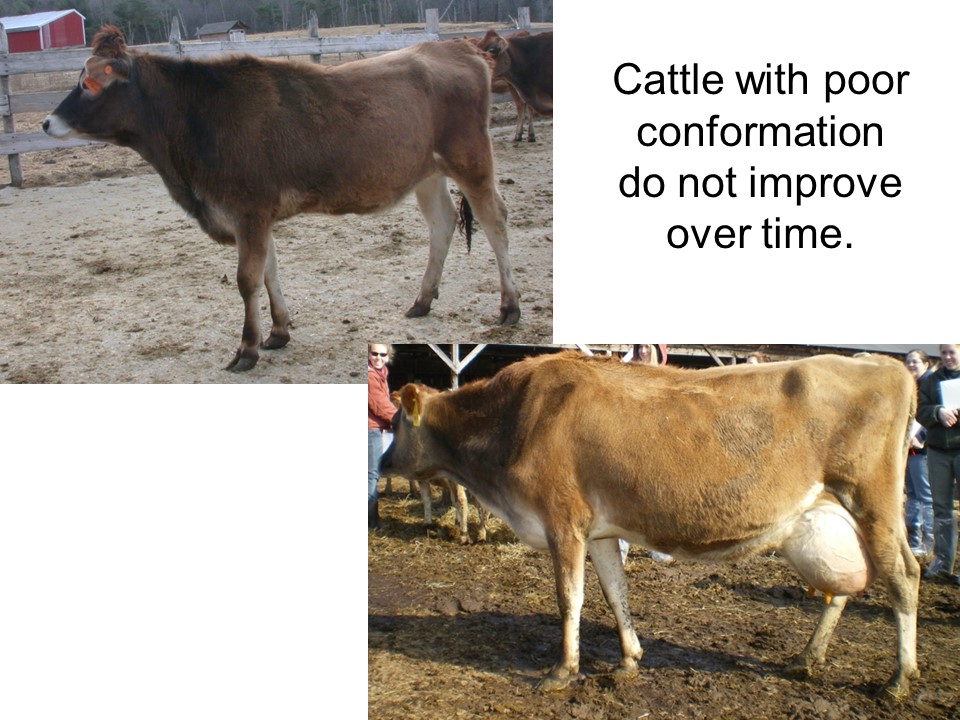
Poor conformation is something that will often become worse over time, so it is important in selecting animals for the farm to recognize the seriousness of conformation faults.
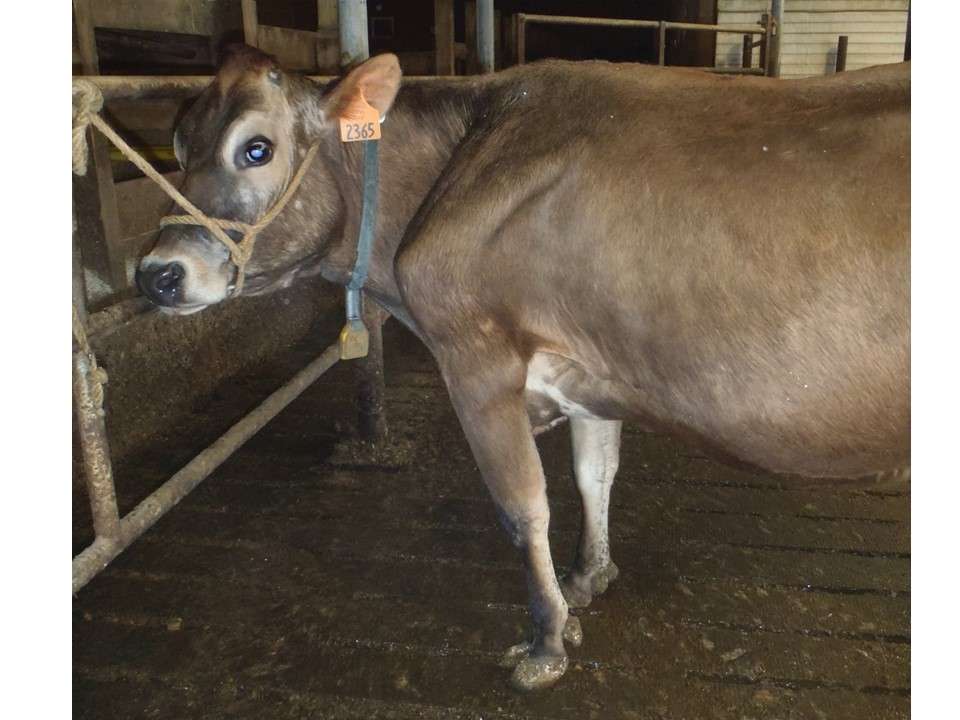
In some cows this condition is the result of lameness in the rear legs, with the cow trying to push her weight forward.
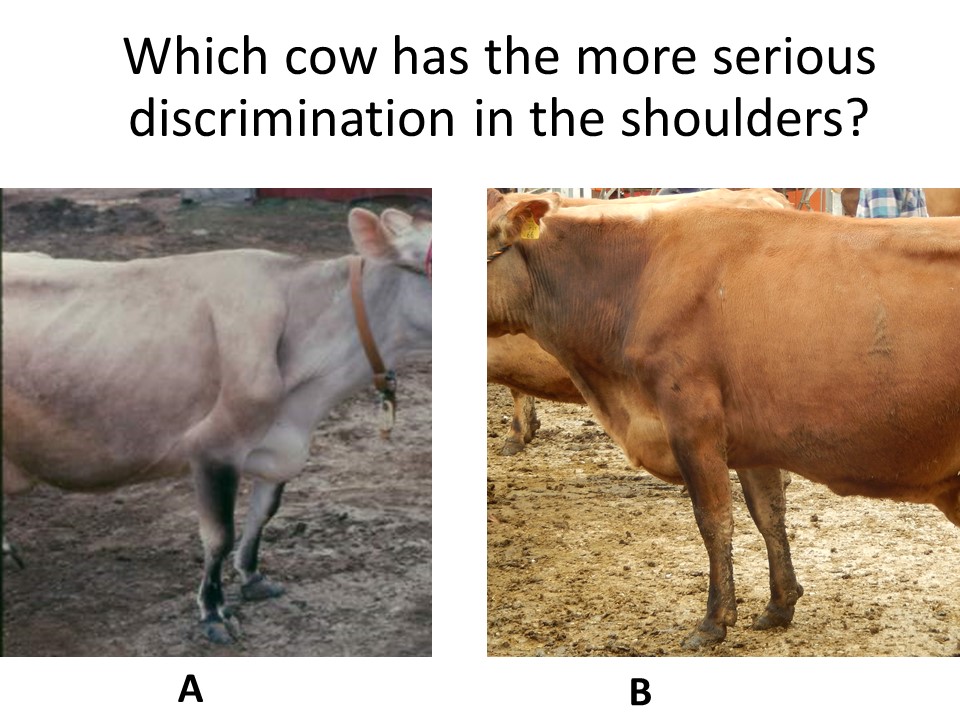
Showing the variation in winged shoulders
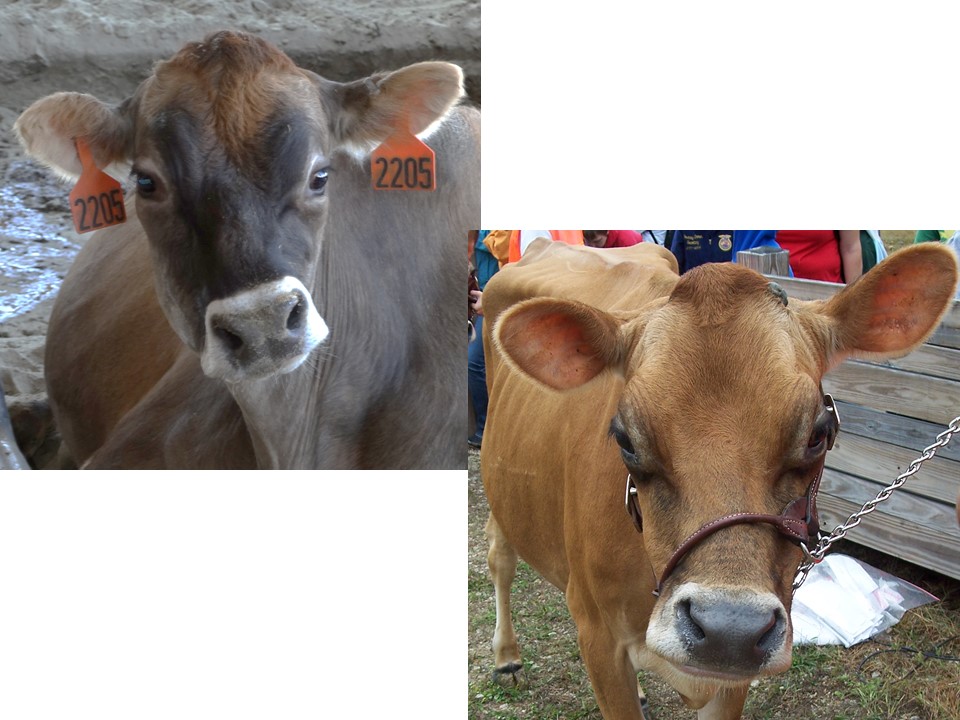
This condition seems to often manifest itself after birth. Animals with a wry face will have this condition for life. The severity of this condition varies, but the worst cases are when it impedes an animals ability to eat normally.
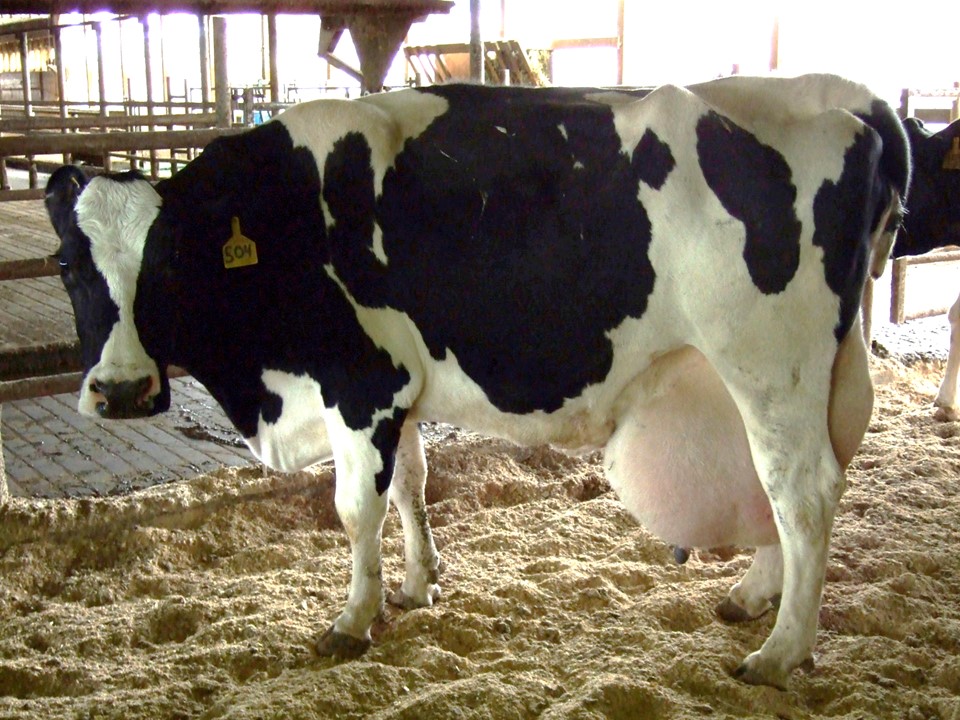
This cow may be an extremely high producer, but an udder that drops below the hocks has been shown to be one of the greatest factors affecting a cow's ability to remain in the herd.
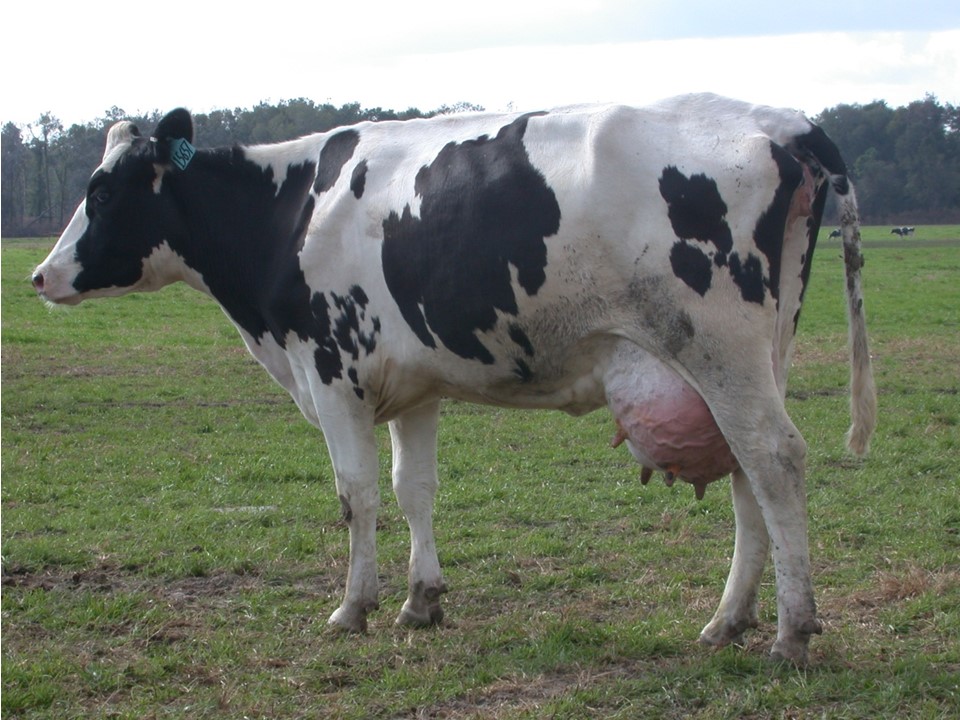
This cow has a blind left front quarter
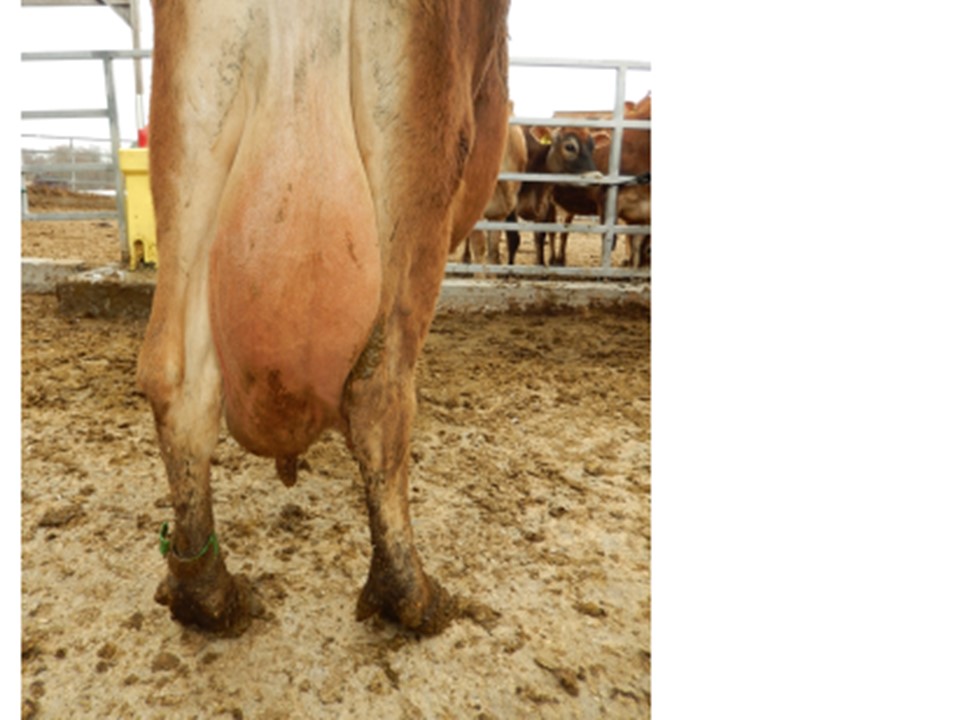
This cow has not only an udder that hangs below the hocks, she also has a blind right rear quarter, disqualifying her in a show or contest.
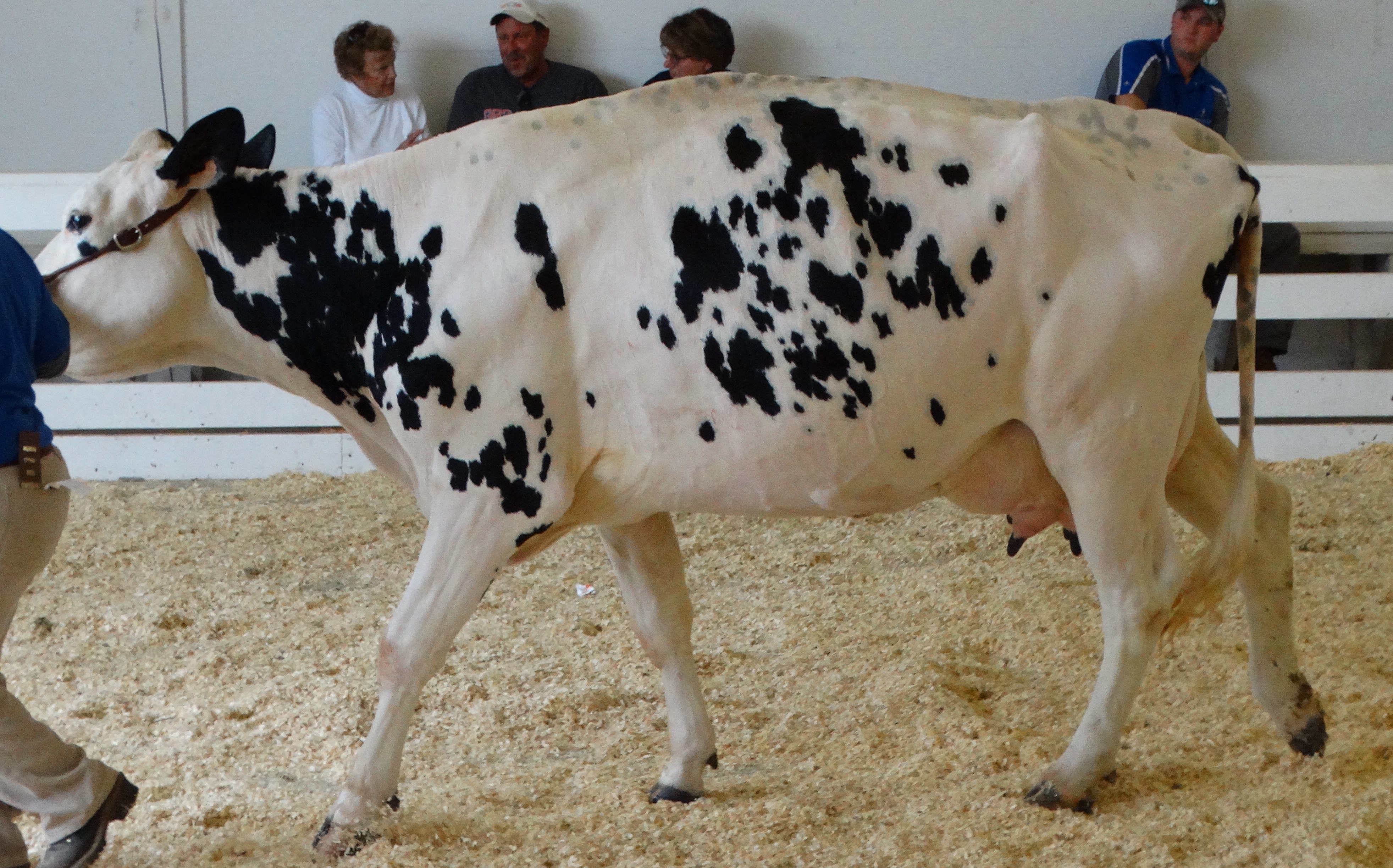
Lameness is a serious issue, and the degree of lameness must be taken into account when judging cows. This cow is showing the arched back and is slightly off her normal gait. A permanently lame cow would be disqualified.
Frame
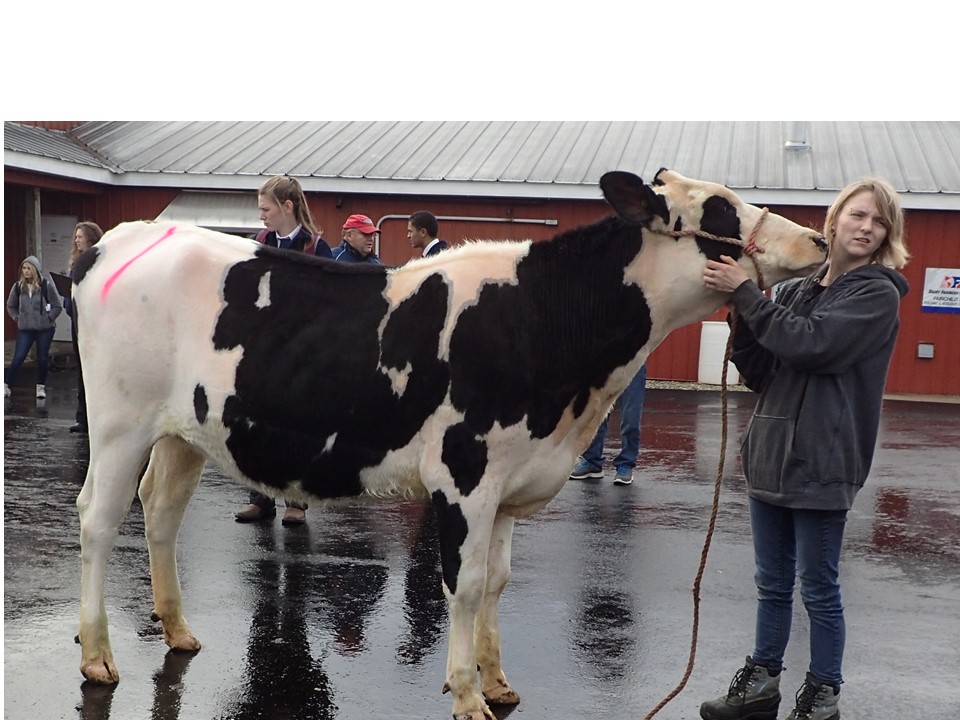
This heifer has a weak topline, and as she ages, carrying a calf and consuming large amounts of feed as a lactating cow will continue to pull this topline down. Cow's with poor conformation do not get better with age.
Dairy Strength
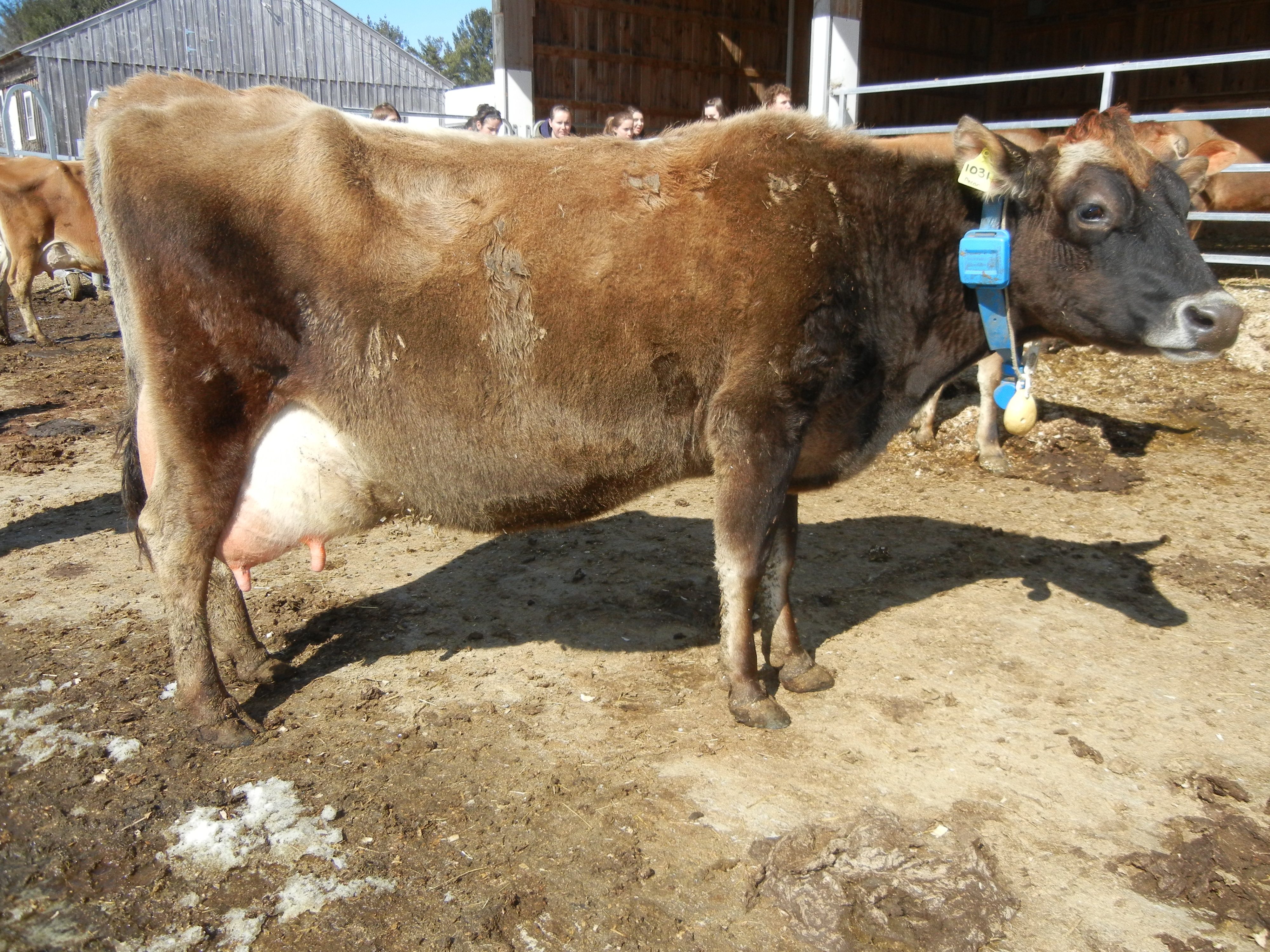
This cow shows numerous weaknesses in the category for frame. She does blend smoothly from front to back as she is weak in the chine, and has high pins and is also loose at the elbows.
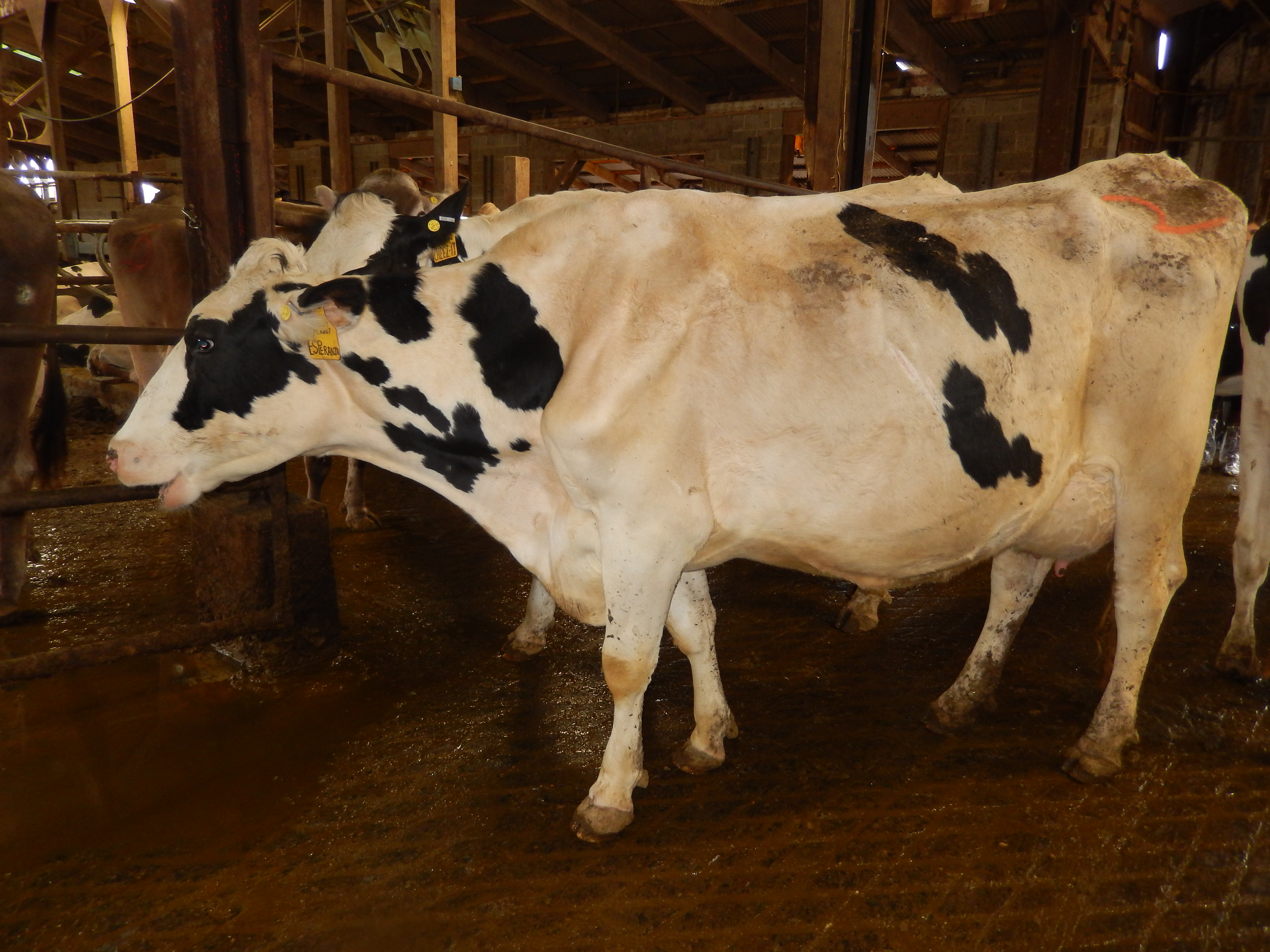
This cow is loose in the shoulders, and slightly high in the pins.
Rear Feet and Legs
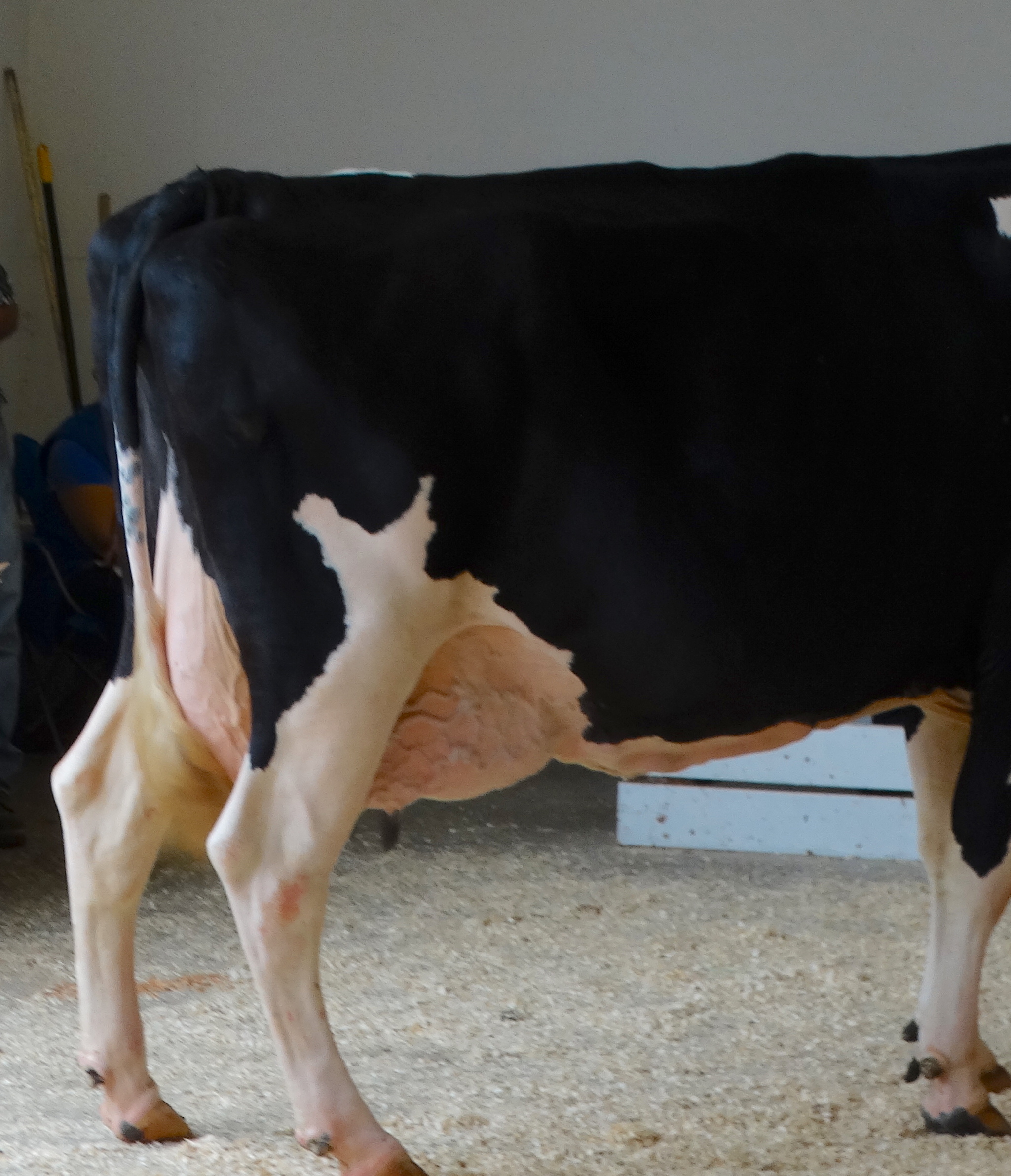
This Holstein cow is showing too much curve to her rear legs, which is called sickle hocked. She is also weak in the pasterns, with the dewclaws dipping down as she moves.
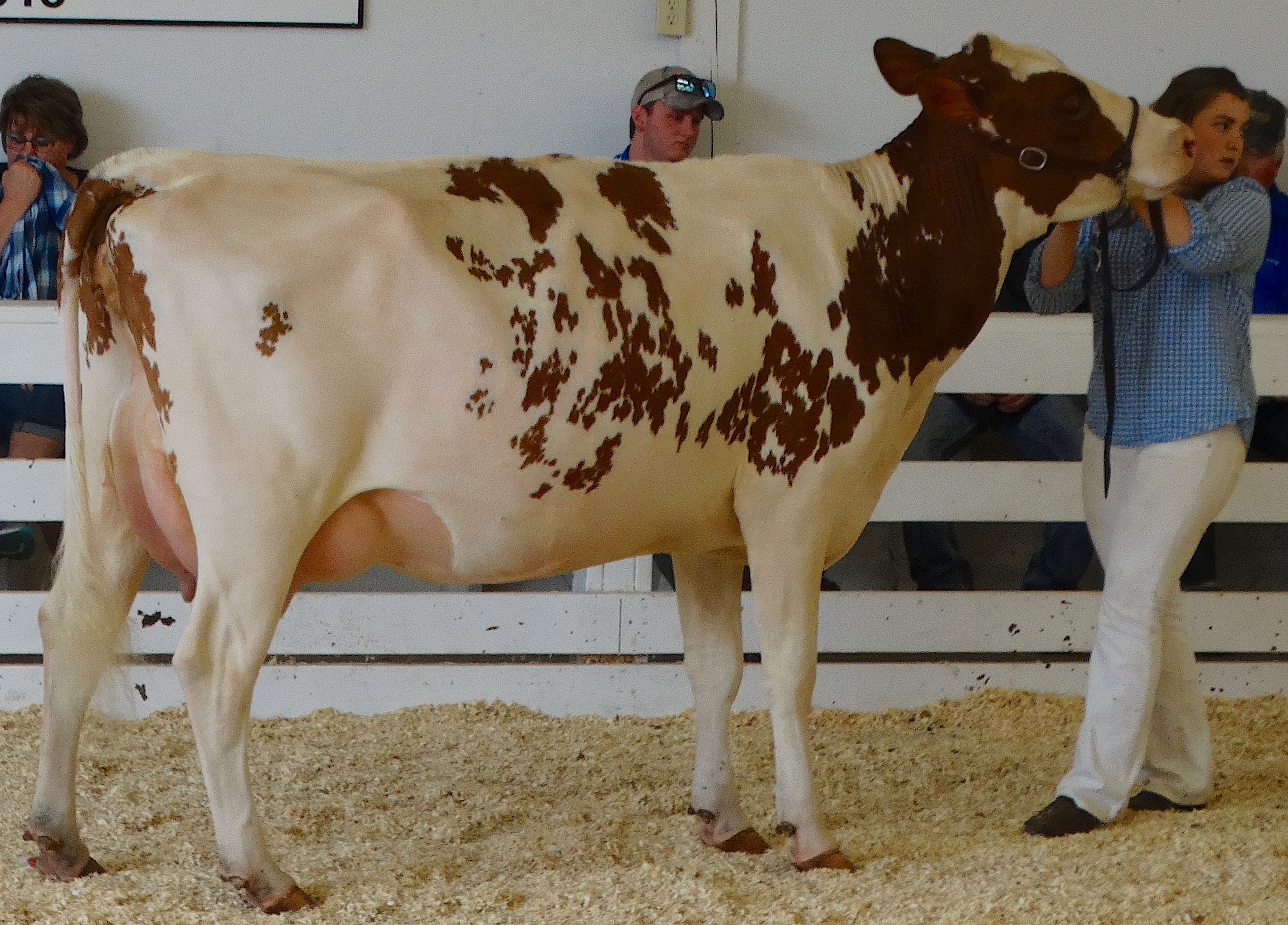
This two year old is showing weakness in her pasterns, which as she gets older will become more severe. The weight of the udder and carrying a calf, will pull her pasterns and dewclaws down.
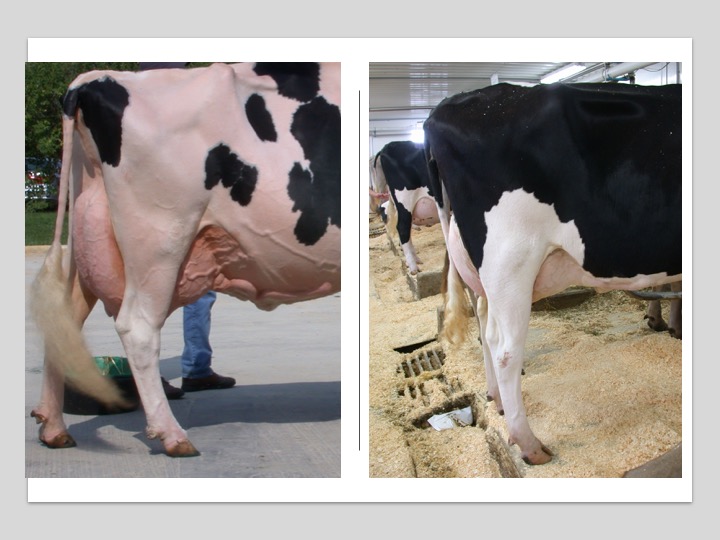
The cow on the left is low in the heel and slightly sickle hocked. The cow on the right is post legged. Both cows are functional, but these are characteristics to evaluate as weaknesses in the rear legs
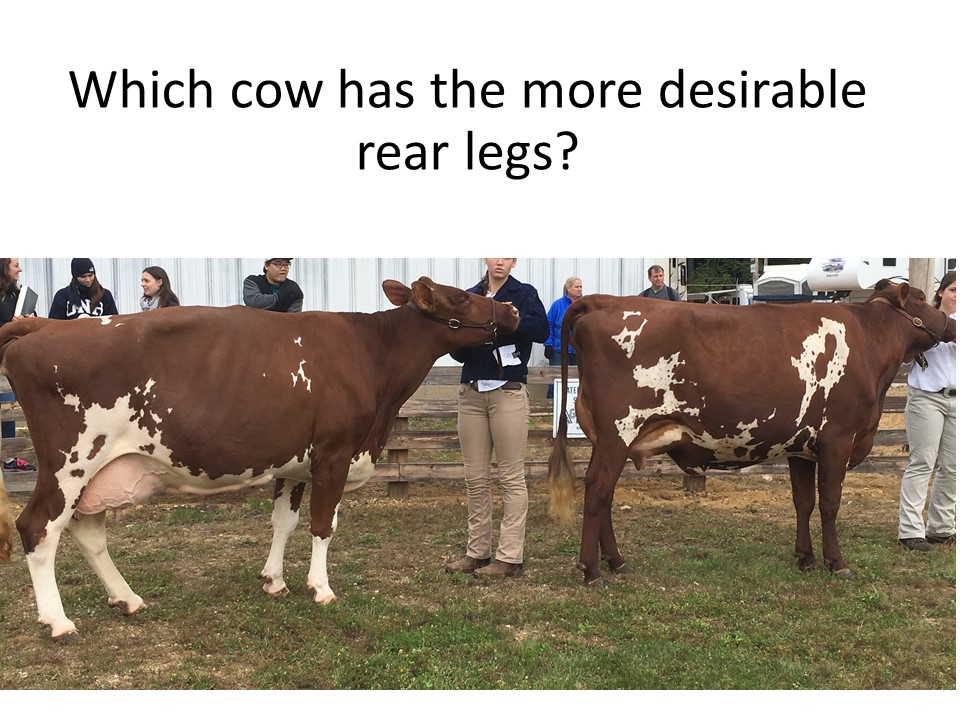
The rear legs in a dairy cow must provide support for the mammary system that can weigh 100 lbs. or more, and do so while also providing soundness for animals that may live their whole life on concrete.
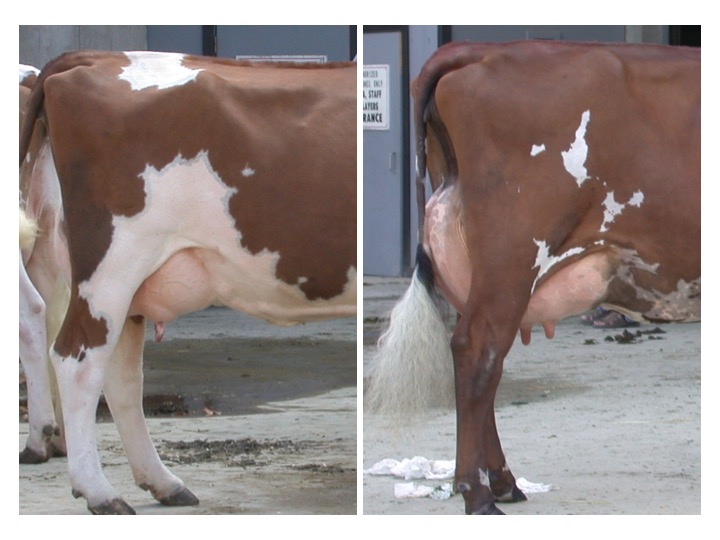
The cow on the left shows extremely weak pasterns for an animal this age. In contrast the cow on the right is much straighter and stronger in the pasterns.
Udder
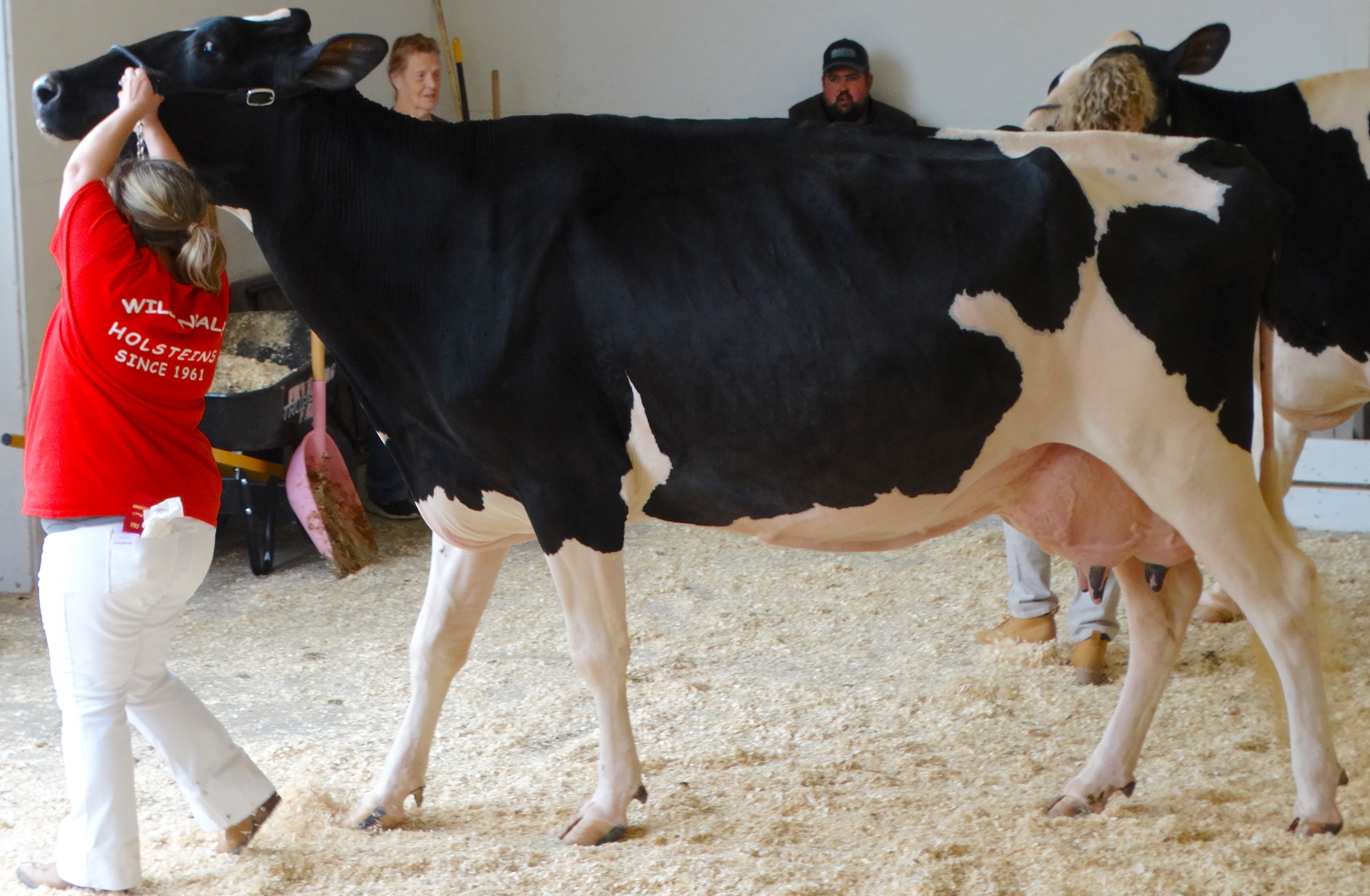
This cow is showing a weaker fore udder attachment than the other cows in the show. While not severe, it was enough to move her down in the class.
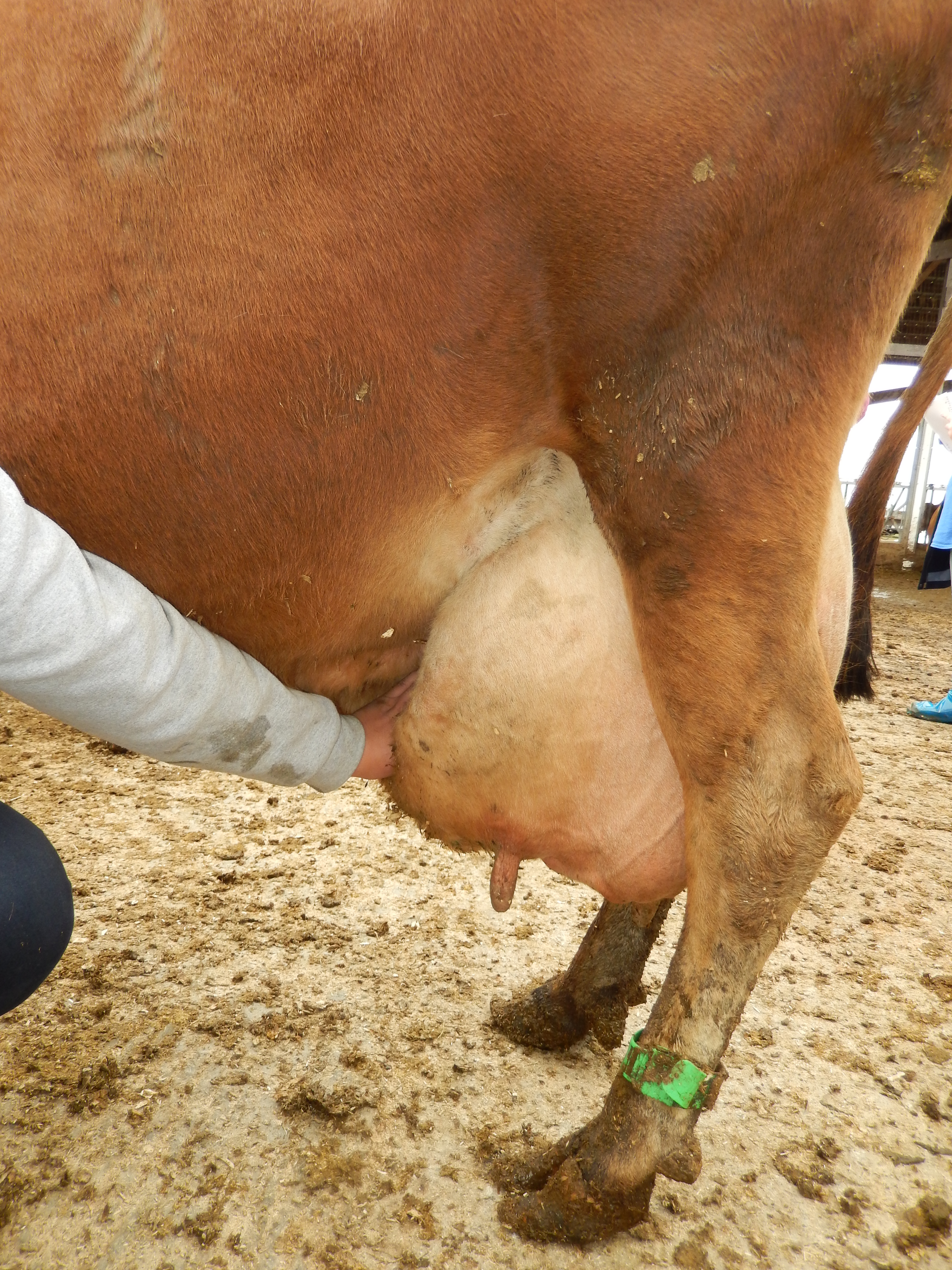
This cow has an extremely weak fore udder attachment, as demonstrated by the person's hand disappearing into the space between the udder and the barrel.
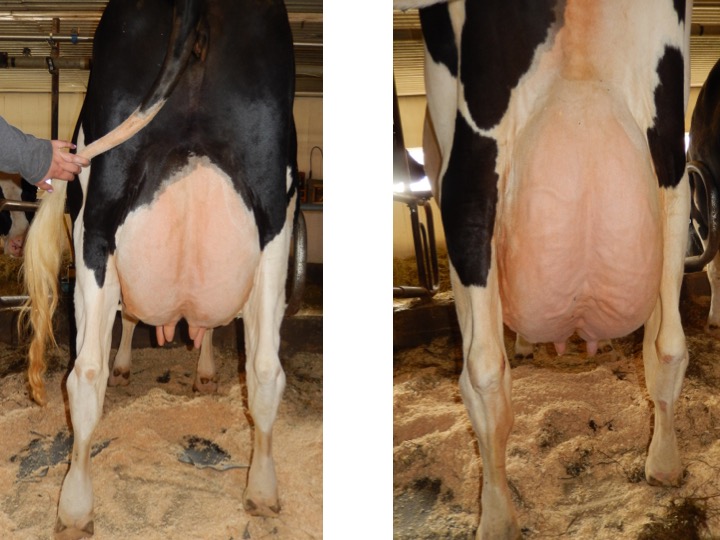
The cow on the left is younger wit her udder held higher above the hocks. The cow on the right is older with a more capacious udder but lower to the hock.
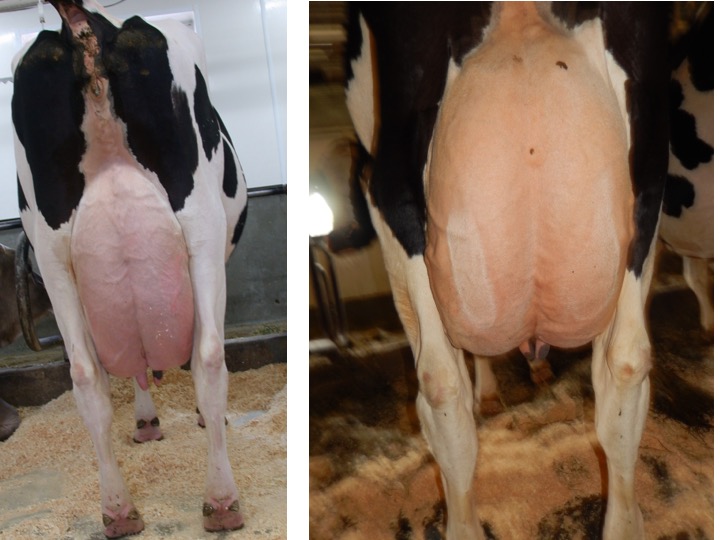
Both of these cows display excellent mammary systems. The cow on the left carries her udder a little lower and has less width. The cow on the right holds her udder higher in relation to the hock and is wider in the rear udder.
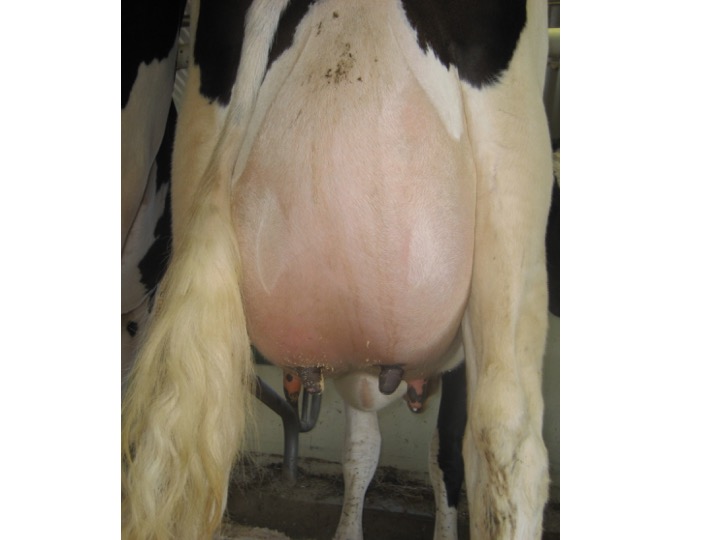
This young cow lacks udder cleft and medial suspensory ligament support. Over time her teats will point outward and the udder will likely drop down to the hocks or below at a young age.
Chapter 4- Judging Cows and Heifers
What is most important in judging cows?
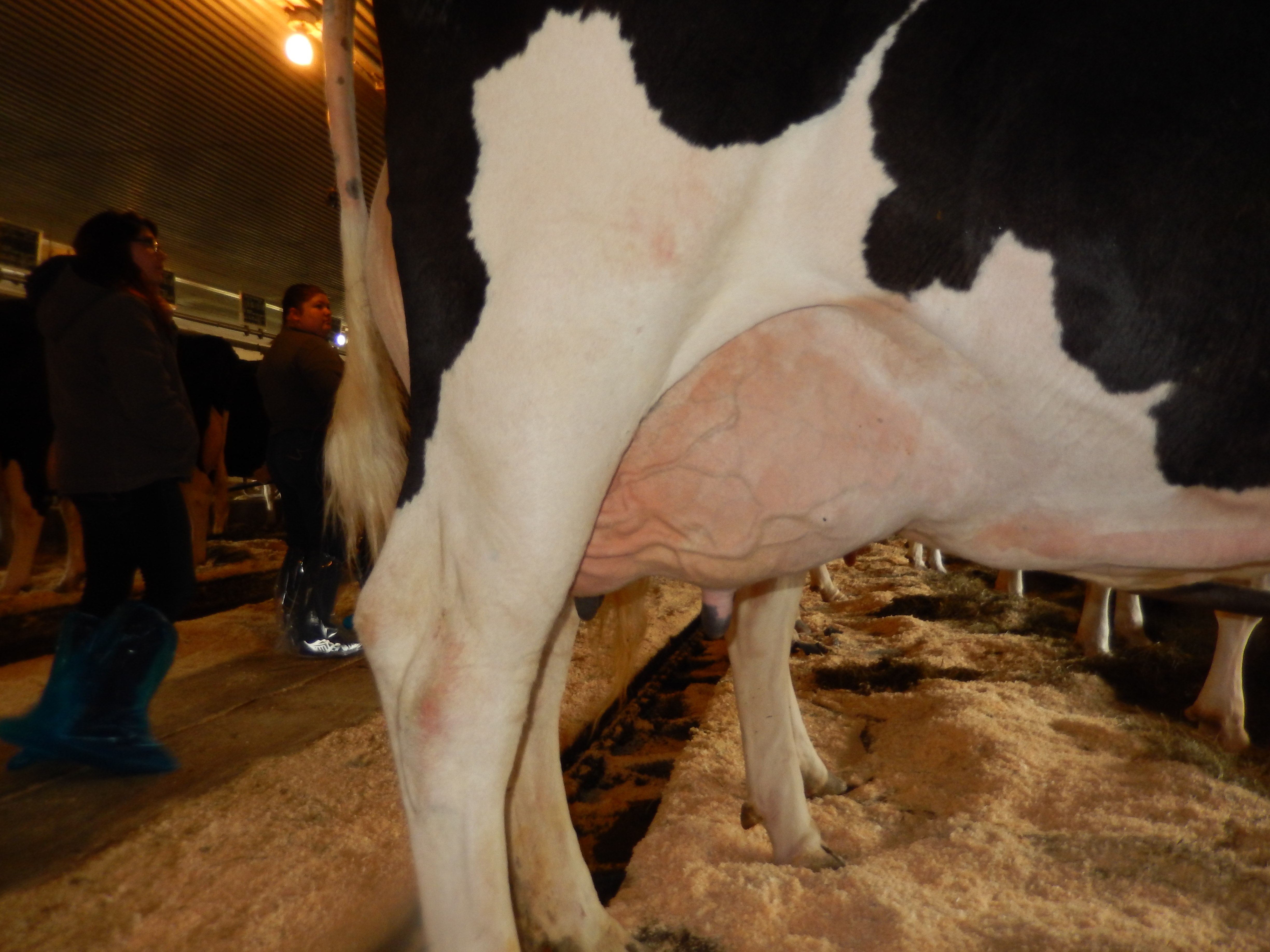
This mature Holstein cow holds her udder slightly above the hock. Her udder floor is relatively level and the udder shows good quality, and cleanliness.
A few comments by Ted Halbach, University of Wisconsin at the World Dairy Exposition related to the importance of the udder depth in relation to the hock.
https://www.youtube.com/watch?v=4uF1qF2t-mY
Click on the link below to a Youtube video by Dr. Catherine Knowlton, of Virginia Polytechnic University, who clearly outlines how to begin judging, by starting with the udder.
The udder of the dairy cow is the most critical part of the body used in judging lactating dairy cattle. Every cow has a different shape and size to her udder, and this has a huge impact on the cow's production level, function, health and longevity. For example, below are two cow's udders as viewed from the rear. The cow on the left shows an animal that was likely just milked or in her dry period. The same cow also shows an unbalanced udder from right to left, that is slightly below the hock. In comparison the cow on the right has a full udder, with very little cleft, teats that splay out, which can create problems in effectively milking her, both in conventional and robotic milking systems. The lack of a cleft is an indicator that the cow has a weak medial suspensory ligament, and will be prone to the teats continuing to splay outward and also the possibility of the udder dropping rapidly in a subsequent lactation.
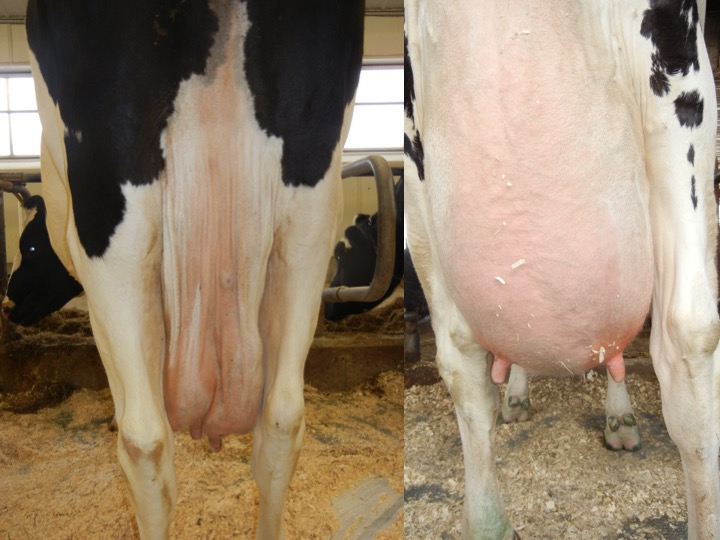
comparing two udders
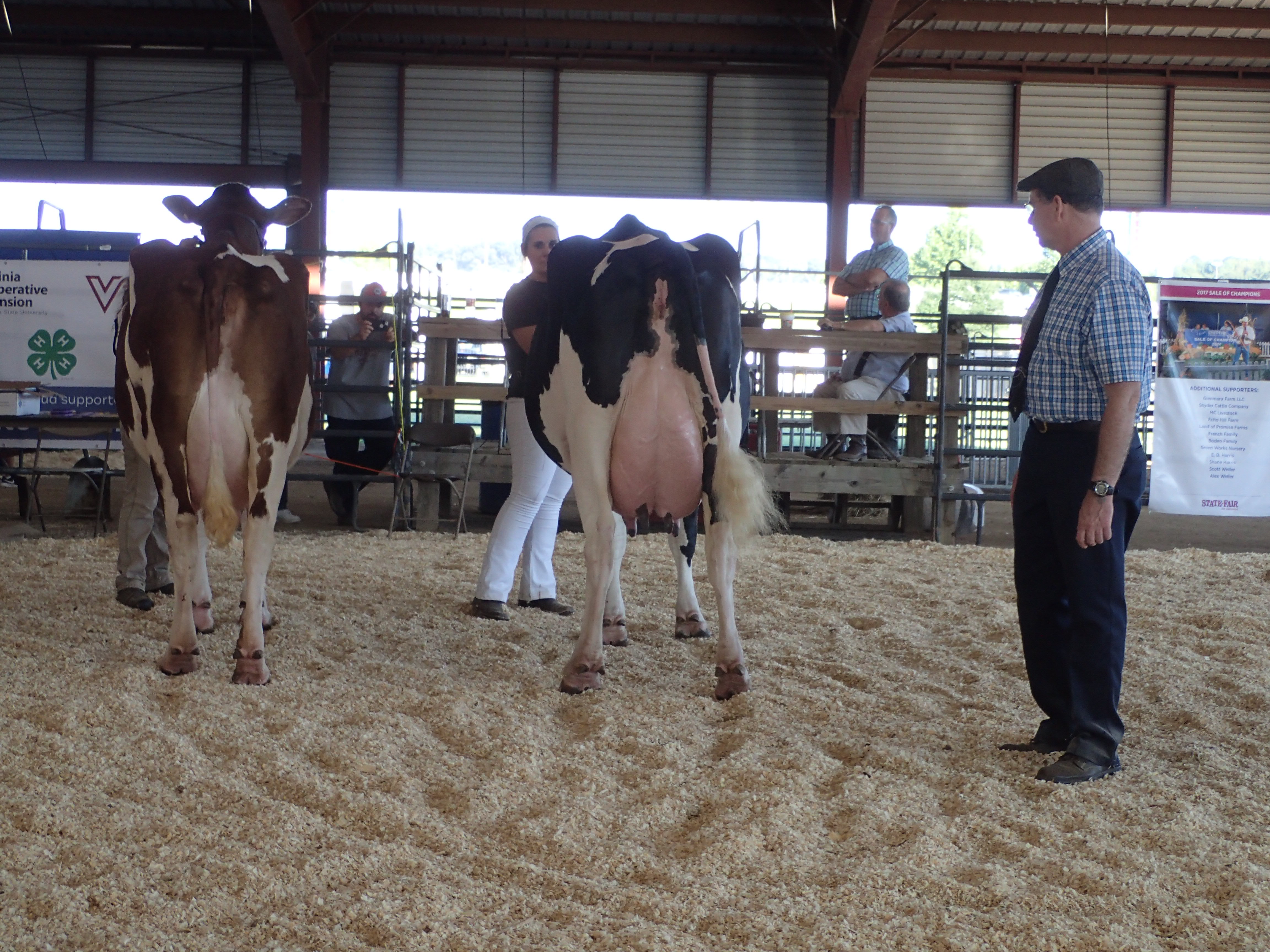
Udder height, in relation to the hock and rear Udder attachment are critical to evaluate
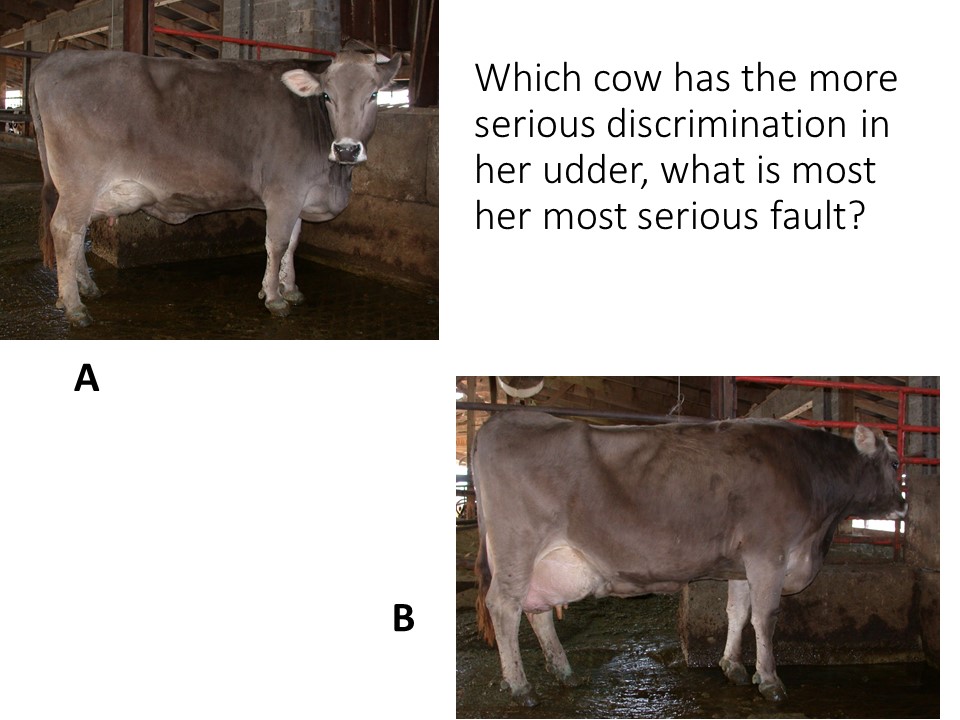
Practice on these Brown Swiss cows, is it A or B?
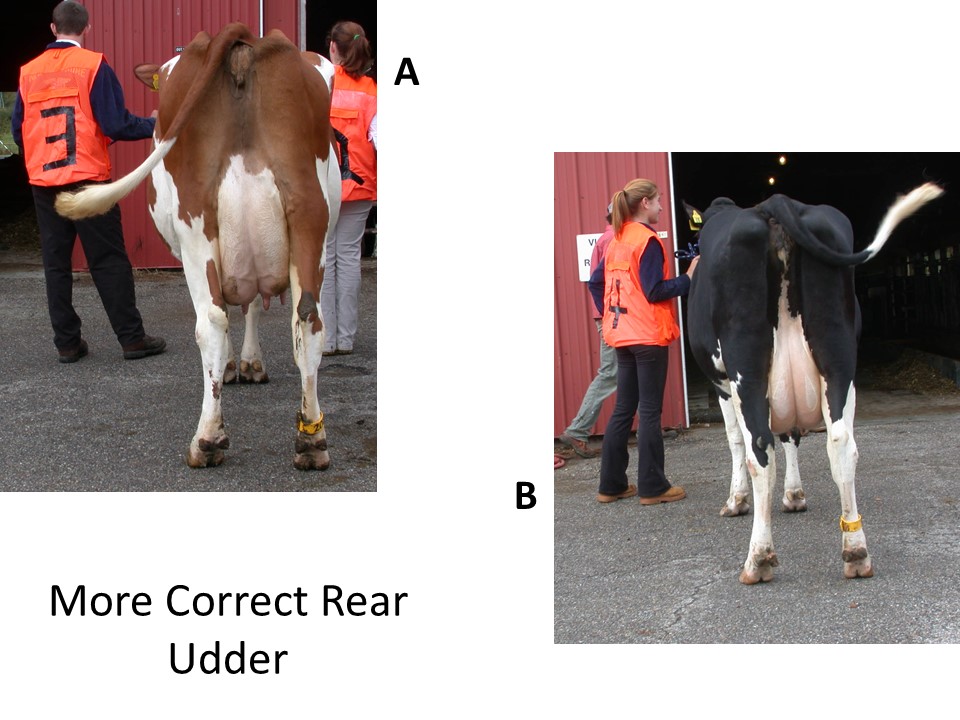
3 year Old Holsteins - look at rear udder height and width
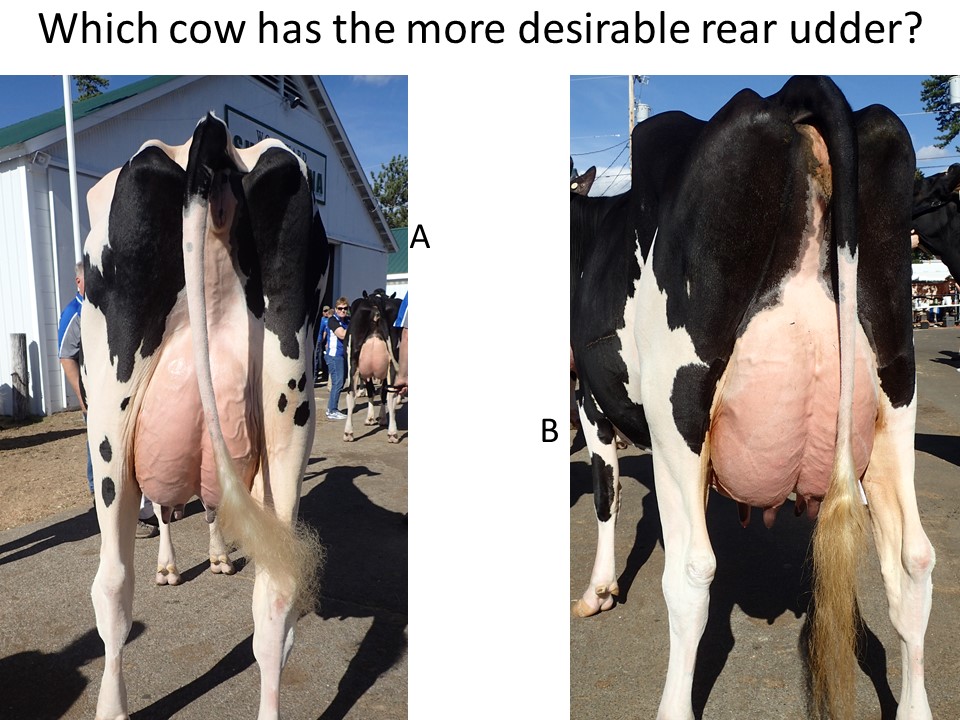
Using the PDCA Unified Scorecard, which of these two udders as view from the rear is more desirable?
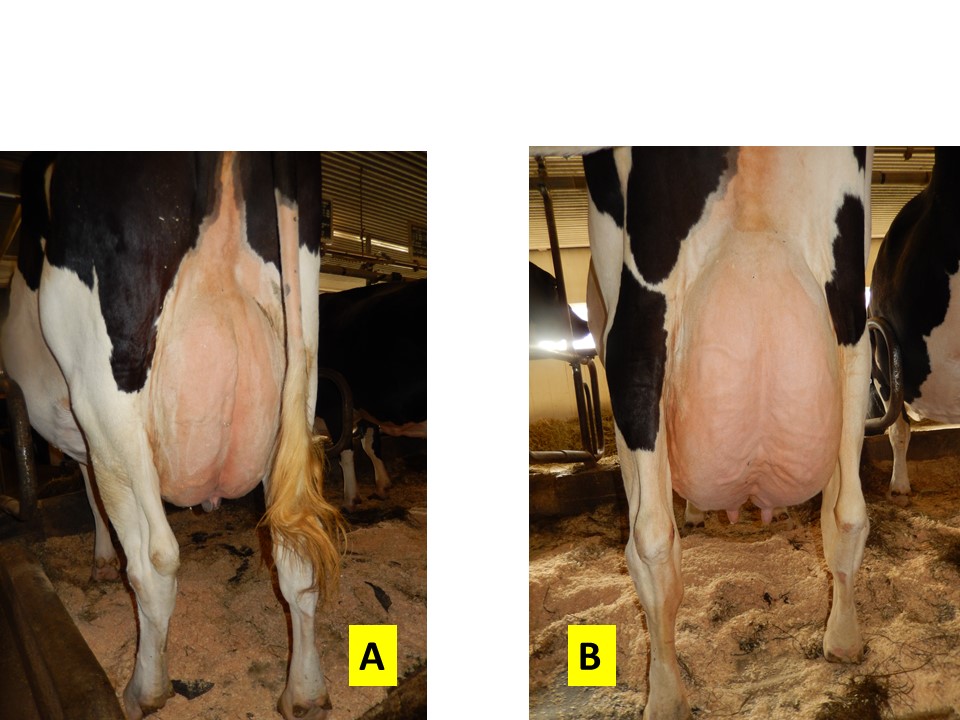
Rear Udders Rear View
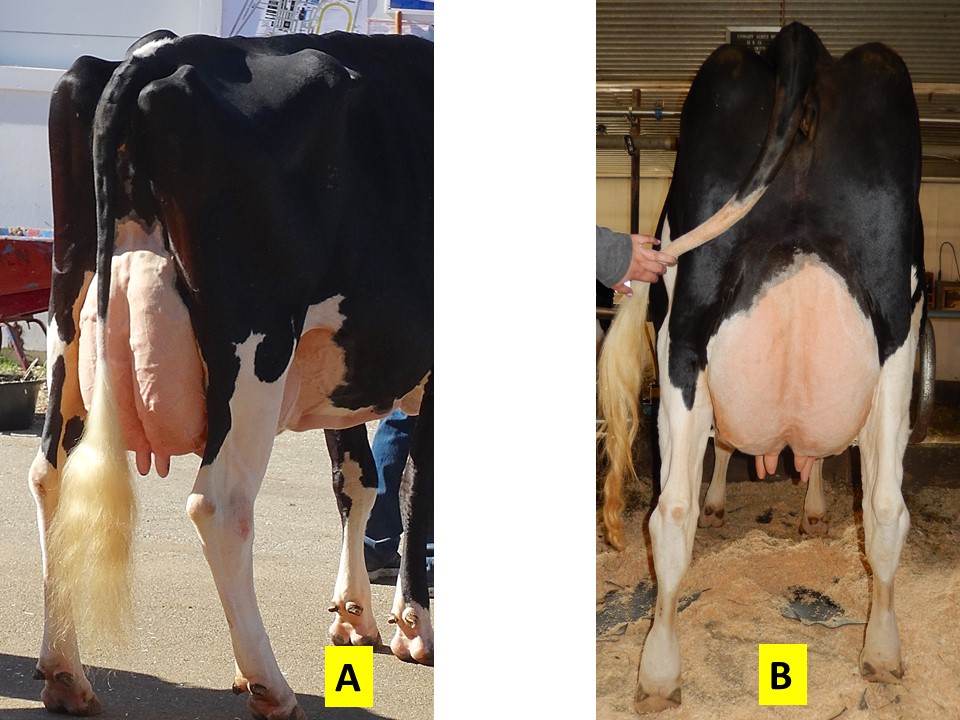
Both of these rear udders show a desirable shape, cleft, appropriate teat size and most importantly are help above the hocks.
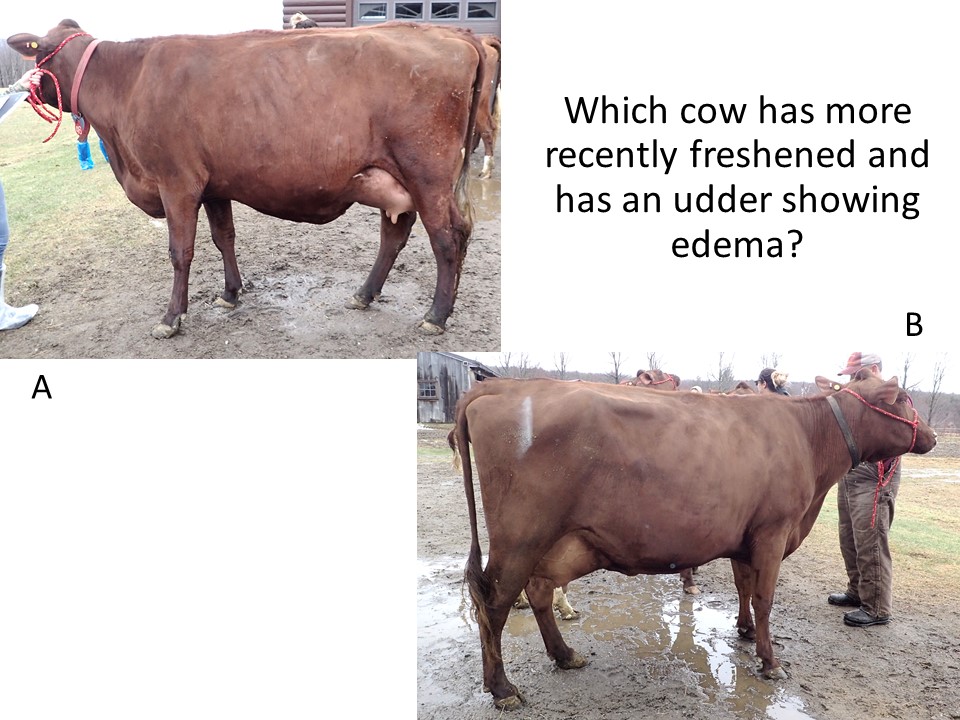
When a cow first calves she may have swelling under the barrel and in the front of the udder called edema.
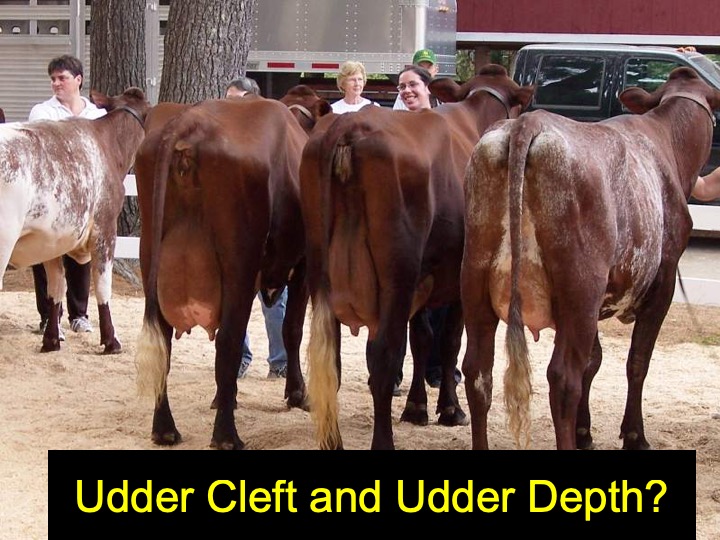
This group of cows shows the tremendous variation that can be found in the shape and attachment of the udder, as well as teat size and placement.
Use this next two sets of images to judge the udders on these four two year old Holsteins.
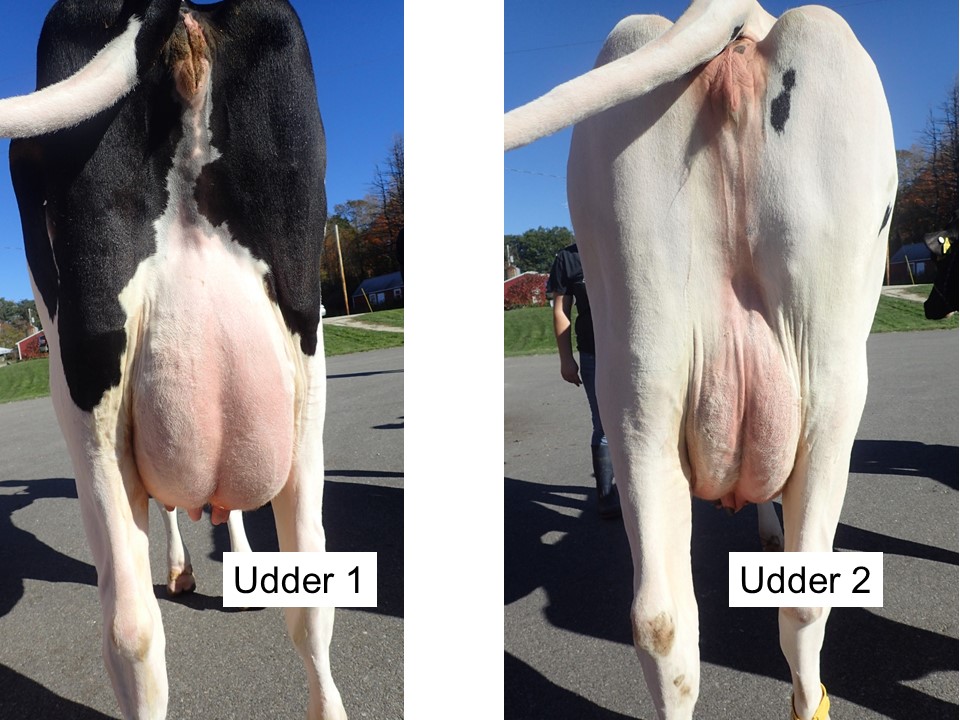
Please judge these four udders of this group of young cows.
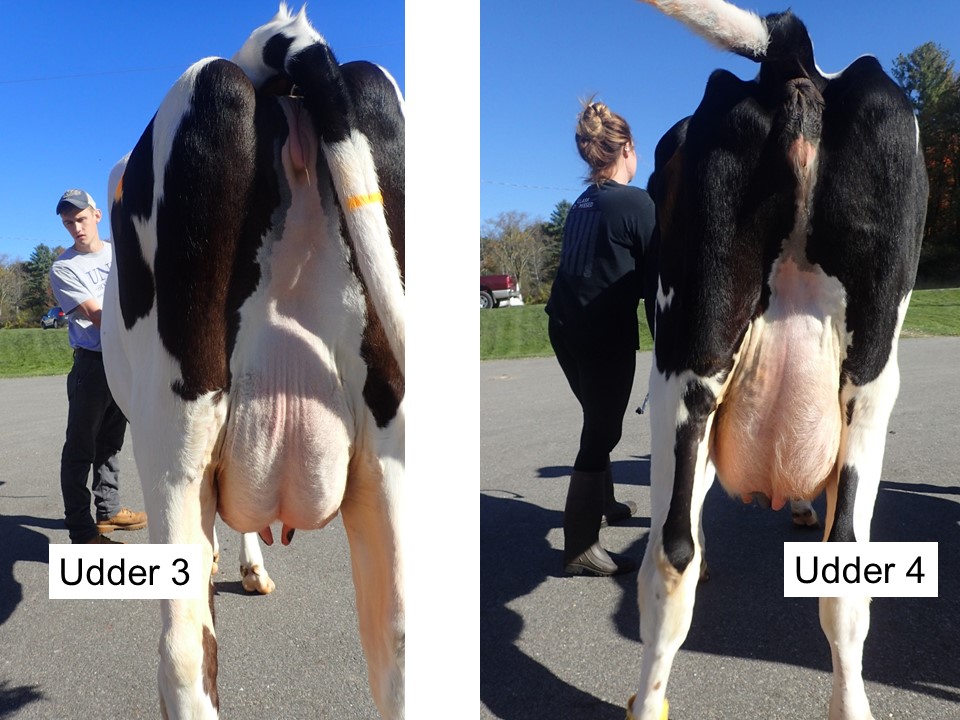
Please judge these four udders
After learning what to look for in the Mammary System or Udder, what next?
After looking closely at the udder, it is important to look at whether or not the cow has any major faults as described in the previous section that might make the evaluation and placement of the animals more simple. If the animals are all sound, then a detailed comparison and analysis is going to be important. Note the most important strengths an animal has and any weaknesses as well. In the following example, two cows are presented, with many differences in conformation and body traits. They make a fairly easy pair to evaluate.
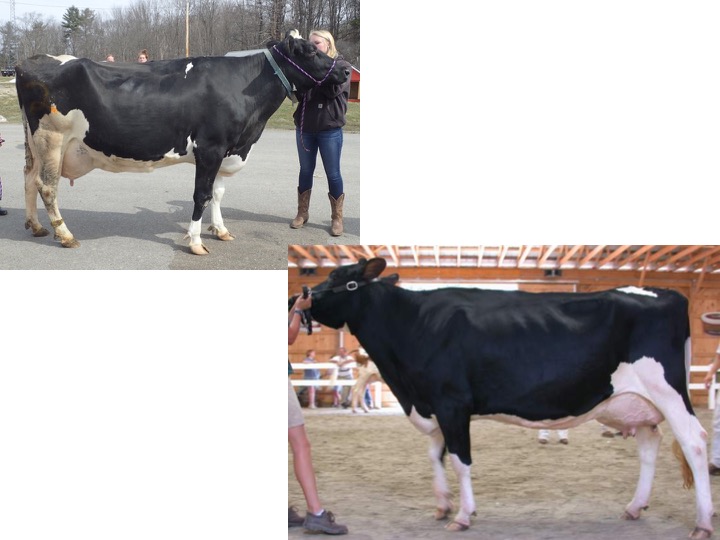
Please evaluate and place these two Holstein cows. Call the cow on the left cow 1 and the one on the right cow 2.
Beyond evaluating a pair of animals, it often becomes important for judges to learn to take notes on the class, to help in their decision making. There are numerous ways to take notes. A good set of simple notes can help sort out the class, even if you do not have to give reasons.
Here is a video outlining some ideas on taking notes for judging contests and later giving reasons.
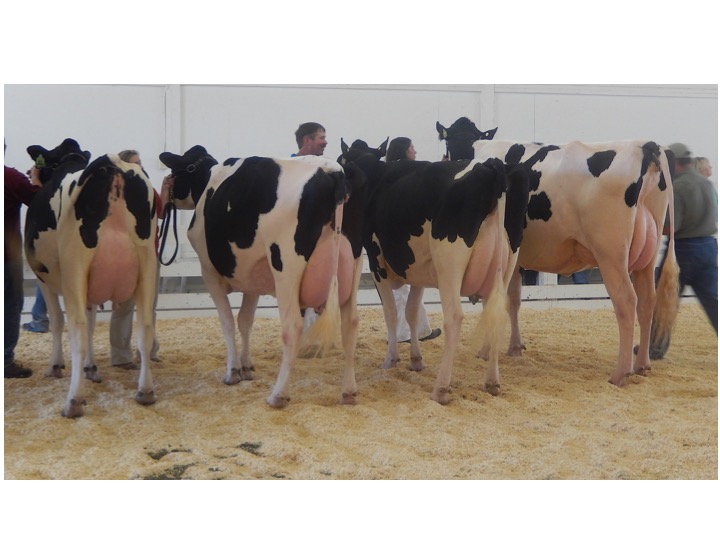
Judging and thoroughly evaluating dairy cattle become more challenging as more animals are added to the class, and even more so if they are all of similar quality. It becomes imperative to think back to the PDCA scorecard and the weighting of each of the four categories.
Recognize and Remember an Image of an Ideal Dairy Cow
In judging cattle, it is easy to find fault with less than ideal cattle, but it can be more challenging to prioritize the more desirable traits. This is especially true when trying to prioritize which animal displays the most ideal physical characteristics of a dairy cow. Keeping a mental image in your mind of the most ideal cow you have seen, with a desirable udder, feet and legs, body size and shape can be helpful in sorting out live animals or images of animals.
Here are a Holstein and a Jersey, both with highly desirable physical traits. A good judge can maintain an image of these ideal animals, and when judging can compare these to less than ideal animals, whey trying to decide on the value or placement of animals in a judging class. These are excellent animals to remember in terms of the shape and size of their udders, as well as the dairy strength and straightness of their frame and lines, as well as outstanding rear feet and legs.
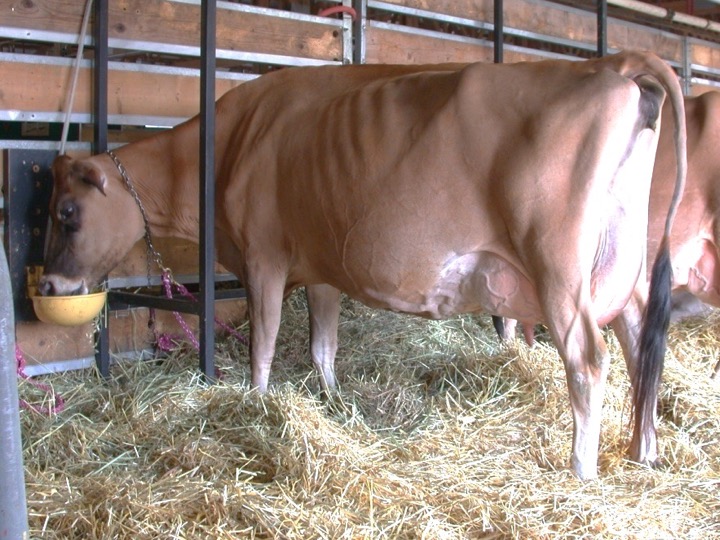
Jersey CowThis Jersey cow displays an udder with many desirable characteristics, such as levelness, being held above the hocks, with a strong rear udder attachment. She stands squarely on her feet and displays legs free of any blemishes. Finally she has a strong straight topline and openness of ribs as well as angularity over the hips, pins and topline.
This Jersey cow similarly displays an udder with many desirable characteristics, such as levelness, being held above the hocks, with a relatively high rear attachment. She also stands on a strong set of feet and legs, also free of any blemishes, with a strong straight topline and finally desiable openness of ribs and angularity over the hips, pins and topline.
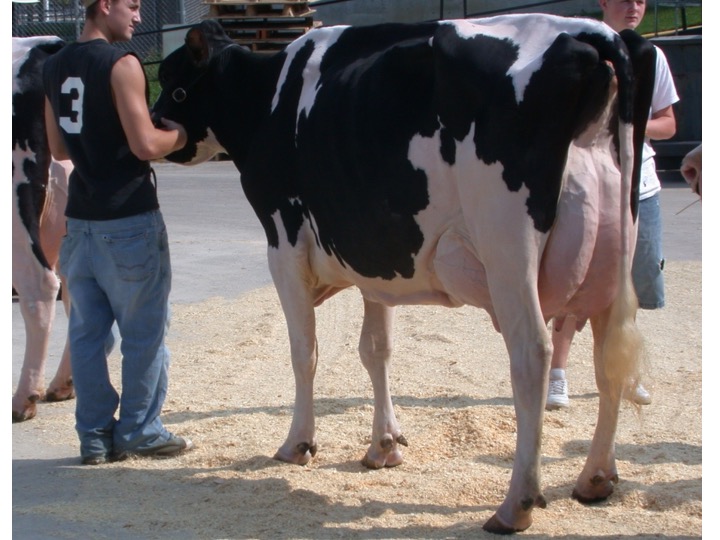
This Holstein cow displays many desirable traits, such as a balanced, level and highly attached udder held above the hocks, with a strong udder cleft, as well as legs that track straight and are free of any blemishes. She also has a level rump and topline, as well as desirable angularity and sharpness over her topline, hips, pins and ribs.
The actual judging of cattle is the comparison of one animal to others. This may be done in a farm setting where the farmer or manager may have to make decisions as to which animals to keep and which animals to cull, based on physical traits, production information or health related issues.
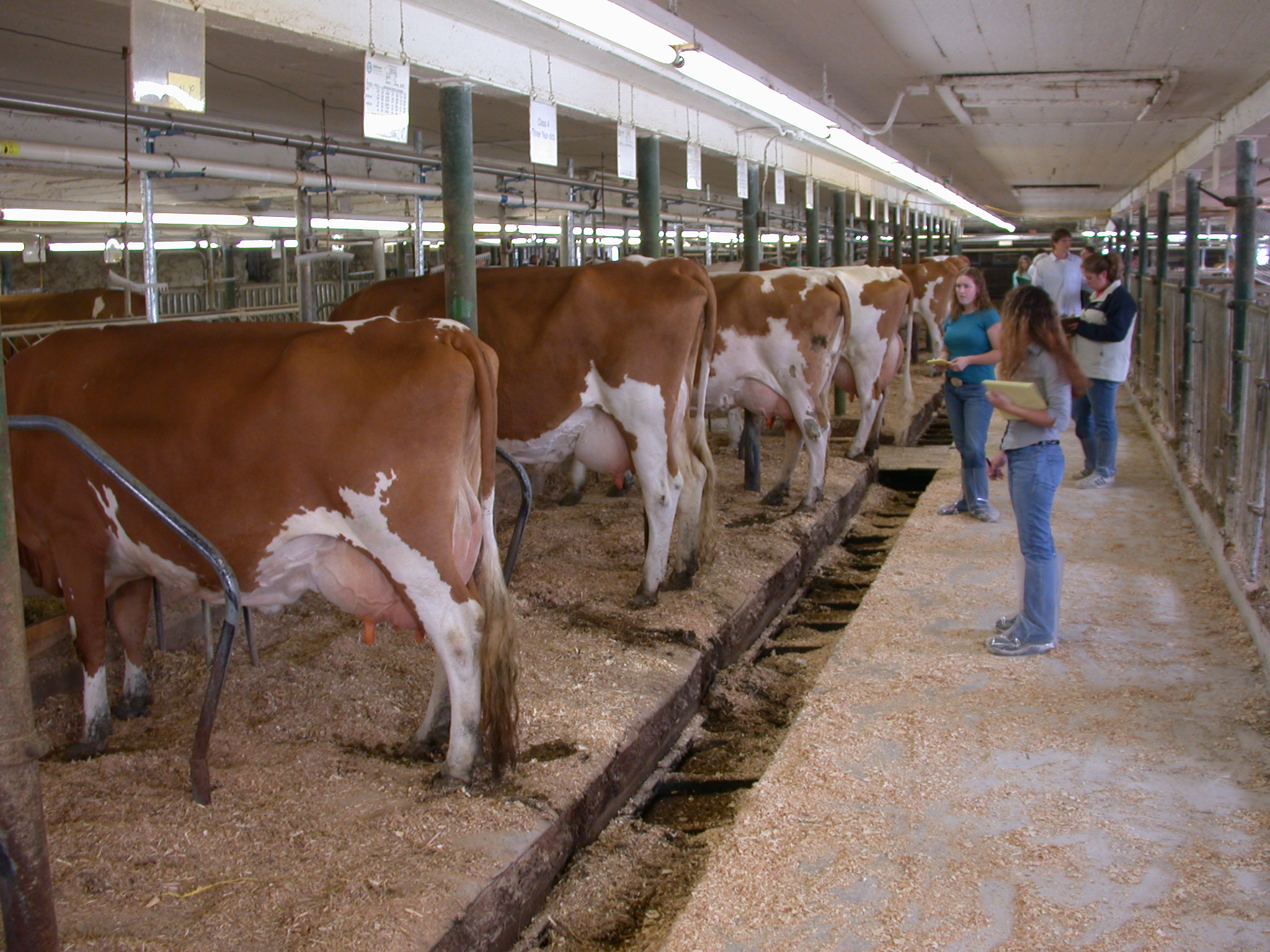
Evaluating the strengths and weaknesses of cows on the farm can assist a farmer in placing a value on the animals they want to keep and those that should be culled.
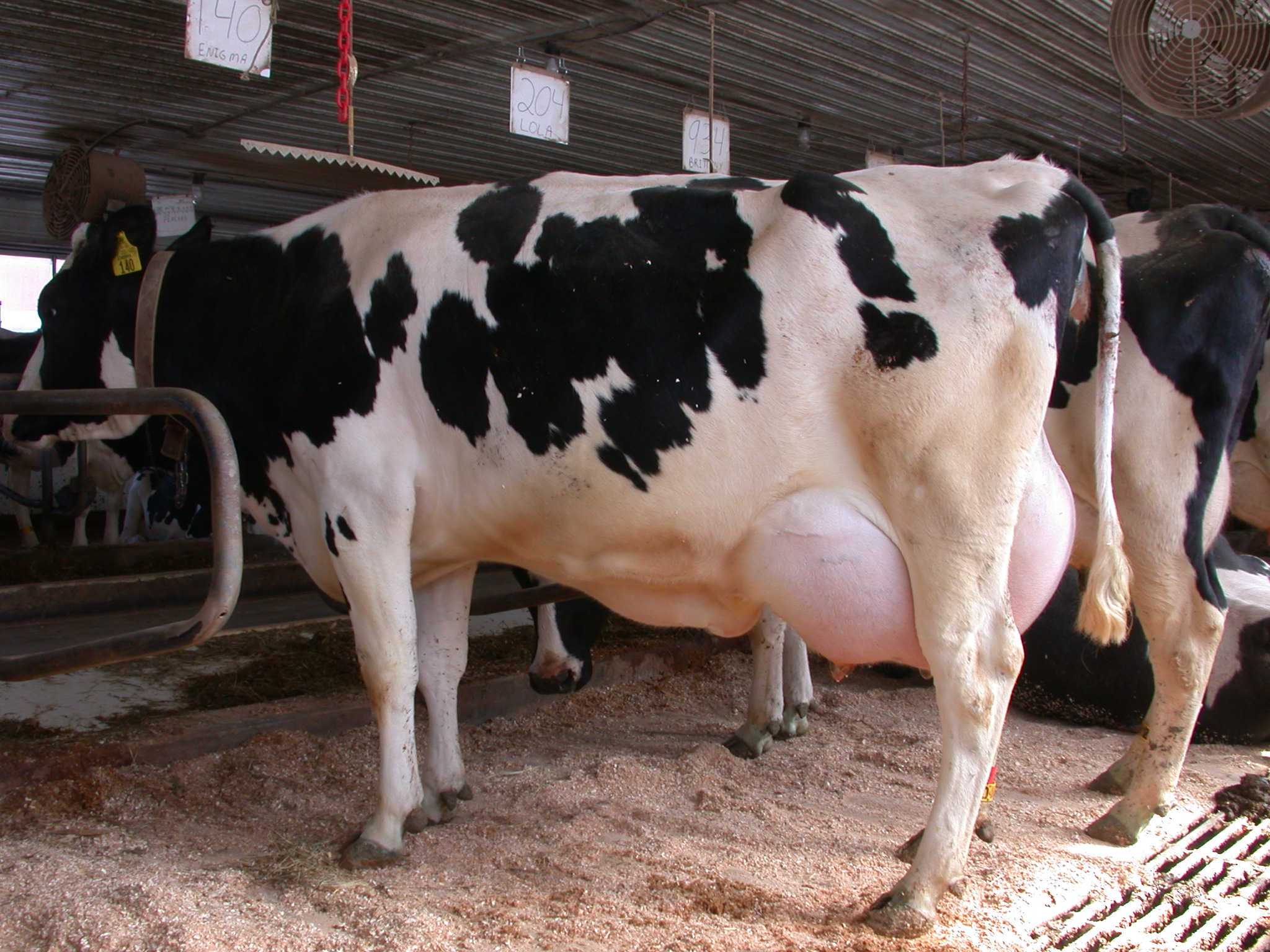
This recently fresh cow is showing some edema or swelling on the belly and udder. Being able to evaluate what is a permanent problem and what is temporary is important in on farm evaluations
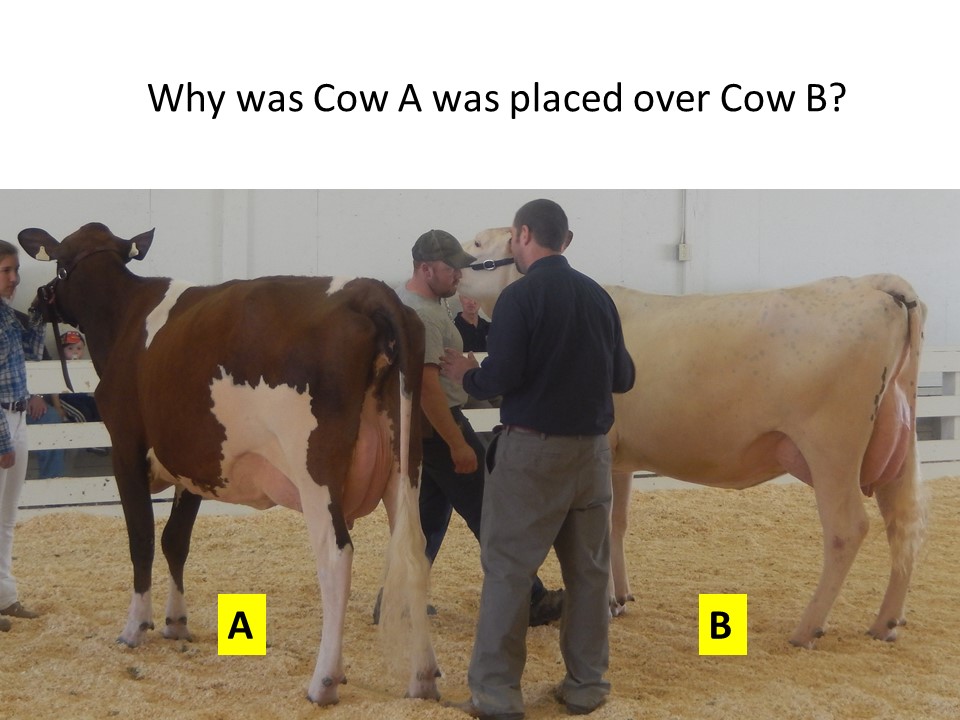
The judge compares the qualities of each cow, based on the criteria set in the PPDCA Unified Scorecard
The other forms of dairy cattle judging involve competitions, where farmers bring their animals to shows or agricultural fairs and professional judges using the criteria outlined above, make decisions strictly based on physical characteristics or type traits of the animals based on the PDCA Unified Scorecard. While every trait is given a numeric value on the scorecard, judges do not have time to do a quantitative assessment of each body trait, so instead highlight and make decisions on the quality of the most important traits the animals are exhibiting.
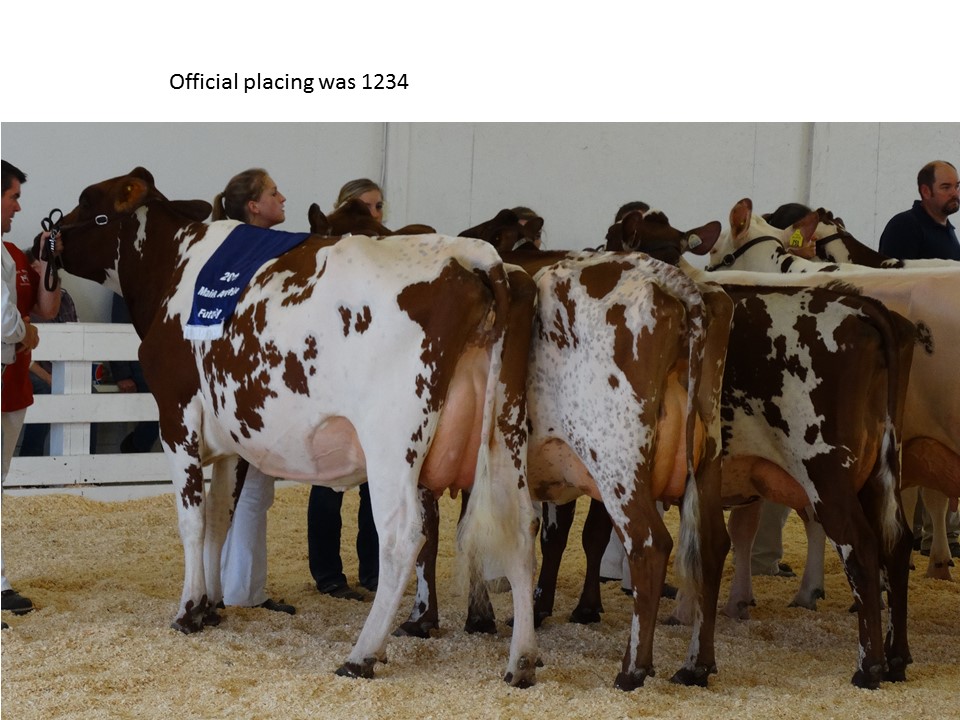
Lined up in a final placing, exhibitors await the judges reasons.
Finally, another form of judging is used in competition, by 4-H and FFA youth as well as students in colleges and universities who compete to judge a class of 4 cows or heifers of the same age and breed, and then present reasons to judges who place the class and listen to the reasons provided by students.
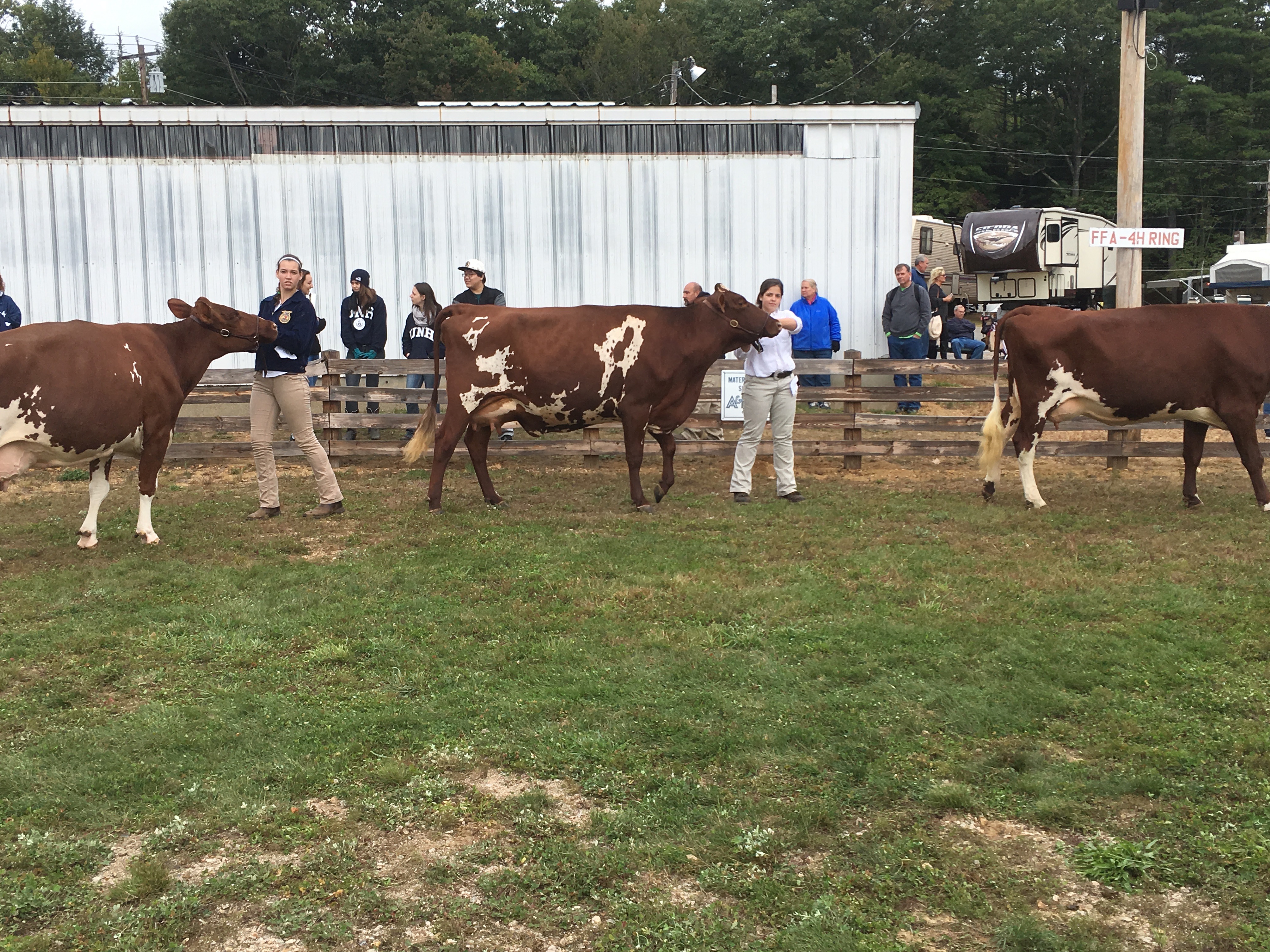
An annual event for many states is the dairy show and showmanship contest
Judging Heifers - How is it different?
Judging dairy heifers requires the use of different criteria, as they do not usually have a mammary system or udder (unless they are close to calving), which in cows is the most important judging criteria. There is no PDCA official scorecard for judging heifers, but the most accepted criteria were developed by Dr. Ted Halbach at the University of Wisconsin in 2011. The scorecard can be found at Dairy Heifer Scorecard 2011
The scorecard uses four categories:
General Appearance worth 35 points
This category includes Style and Balance, Rump, Back, Front End, and Breed Characteristics
Dairy Character worth 25 points
This category includes: Angularity and Openness in the Ribs, Thighs, Withers and Neck. The Skin is also evaluated.
Rear Feet and Legs worth 20 points
This category includes: Ease of Natural Movement, Rear Legs-Side View, Rear Legs-Rear View, Feet or Hooves, Thurl Position, Hocks, Bone, especially leg bone shape, and Pasterns.
Size of the animal (for age) worth 20 points
This category includes: Stature evaluating the height at the withers, leg length and general proportion and balance of withers height to hip height. The category also includes size and scale of the Barrel and Chest.
The following video highlights how judging heifers is different than dairy cows.
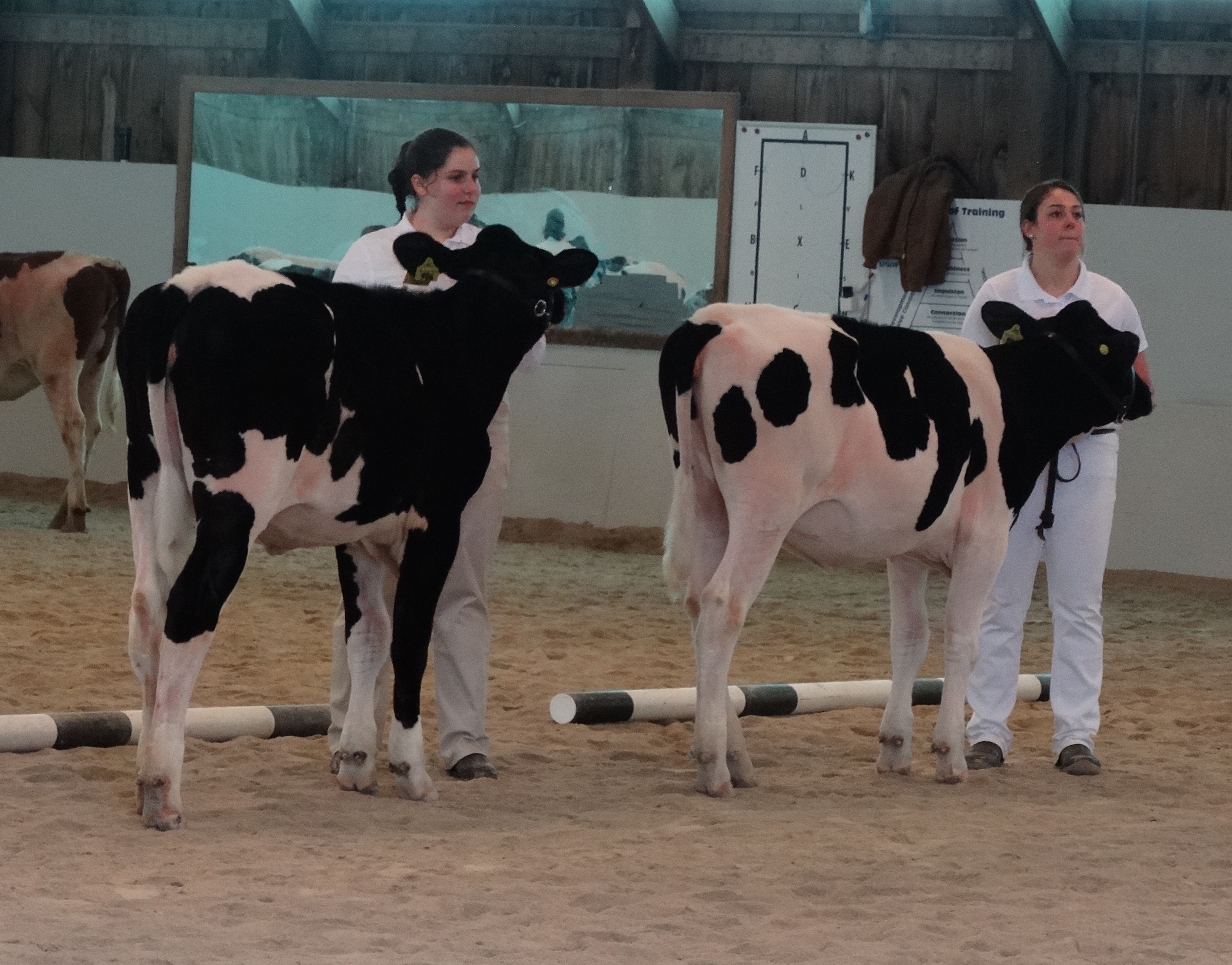
Using the above criteria, it should be obvious there are differences in stature, angularity and dairyness in these two heifers. The heifer in the rear is taller, has more incurving thighs and is sharper or more angular over the topline,.
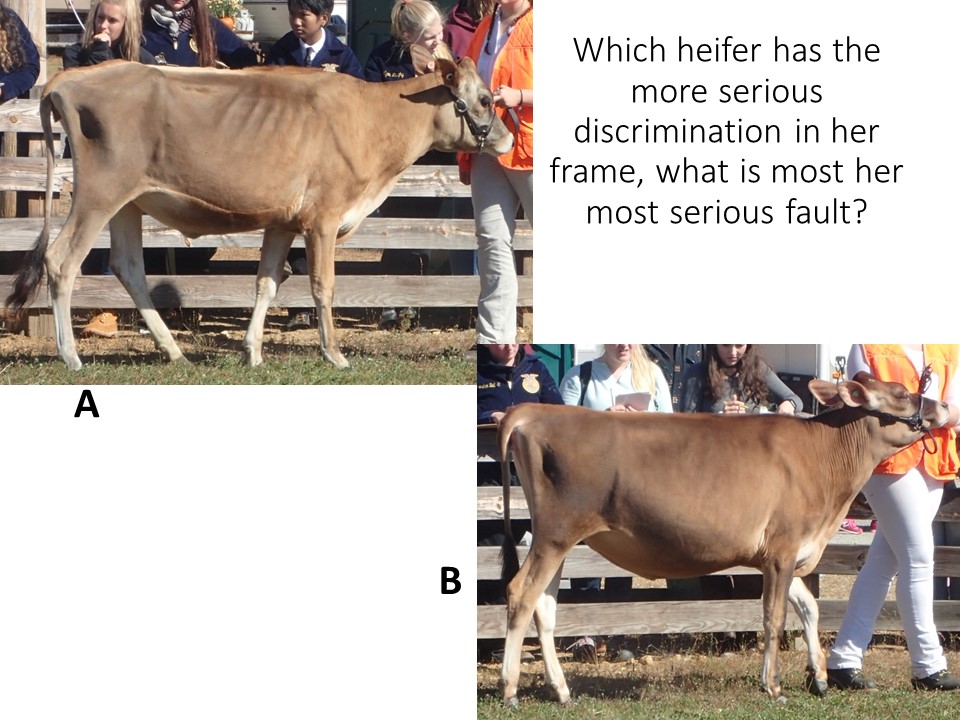
Looking at the categories of frame, including the topline, rump and blending of parts, you should be able to determine differences in quality between these two animals.
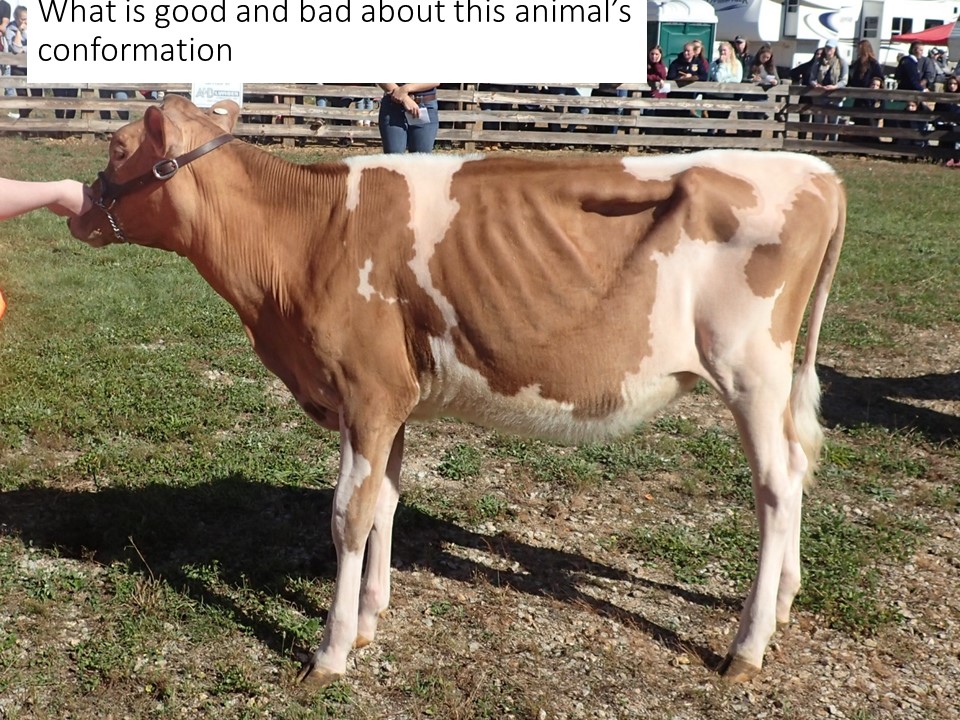
Determine the strengths and weaknesses in this heifer's conformation.
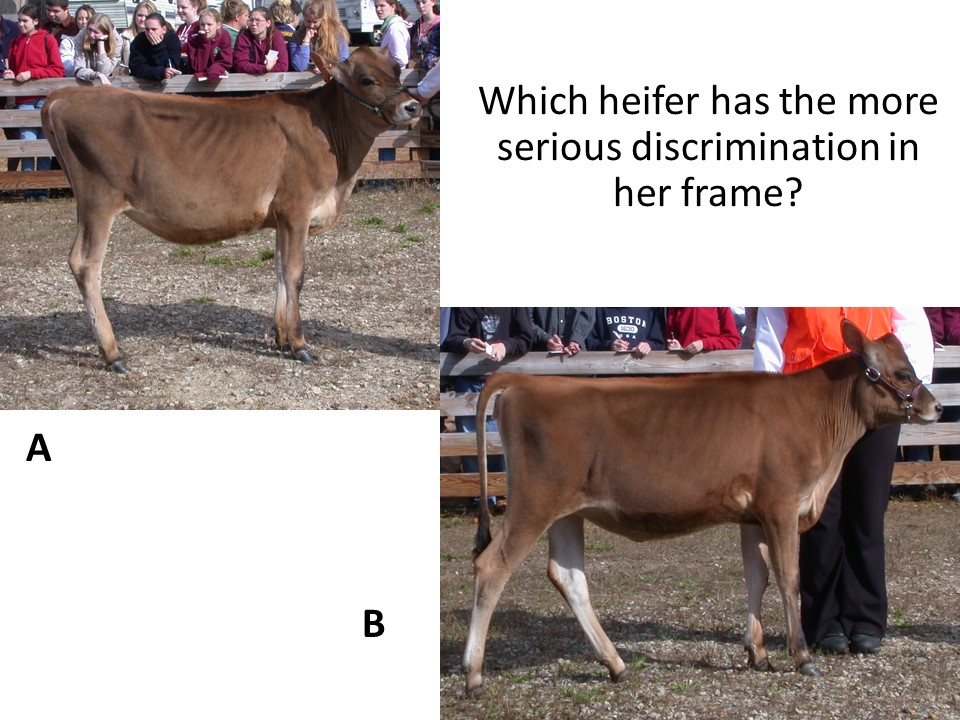
Heifer B is much more appealing in General Appearance and Frame
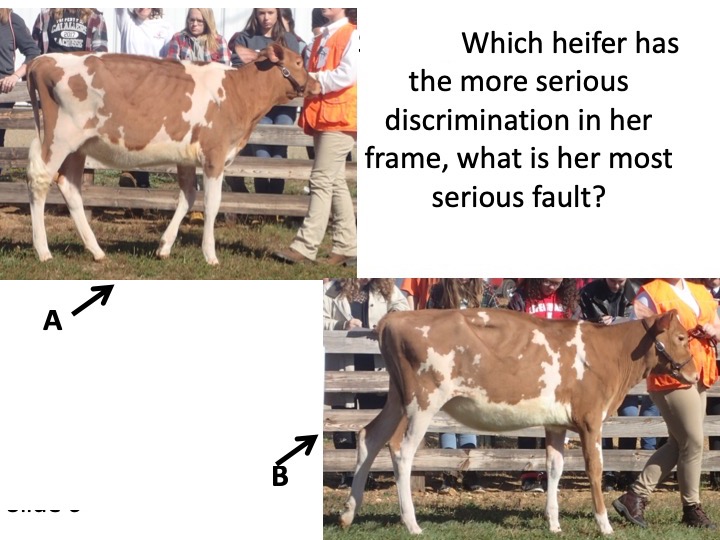
Two high quality Guernsey calves. Look closely and answer the question.
Heifer Classes on Video for Judging Practice
Chapter 5- Terminology and In-Depth Look at Giving Reasons
After learning what to look and prioritize when judging dairy cattle, it is necessary for anyone involved in judging contests, college courses and professional judging to articulate clearly the reasons you placed a class or group of cows. The recommended way to give reasons is to use positive and comparative terminology and provide reasons for pairs of animals. You provide the reasons in a logical and sequential manner starting with the first place animal and working pair by pair to the end of the class. The only animal a judge should refer to using negative terminology is the last placed animal. This is done in order to justify why the animal is there. Even this should be done by first offering even the last place animal a compliment or grant statement, meaning you need to provide one characteristic the last place animal has over the one above it.
The following is a nice guide to why it's important to give reasons and how to do so, with regard to format, presentation, and language.
The why and how to give reasons for livestock
Learning the accepted and recommended terminology for giving reasons is important so a judge can clearly share their reasons for placing a class a certain way. Being accurate with comparative terminology will help the judge be understood and respected for their reasons, even if they may not be detailed or follow the exact format.
Download one of the following guides to offer additional terminology, the format to present reasons and also some examples of taking notes and presenting written reasons for a group of four animals.
A guide to saying what she is, not what she isn't- University of Georgia
Now why the heck did I place that animal first ? Iowa State University Extension
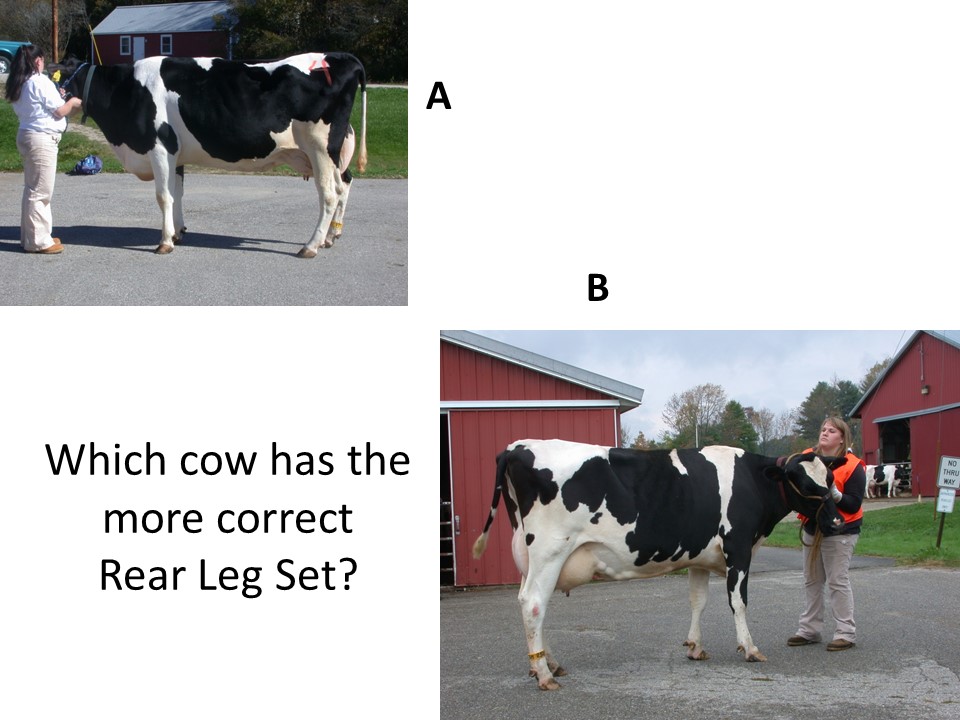
Using terminology to compare the cows and justify the placing is important.
The following Judging Pamphlets include good guidelines for giving reasons, and also include additional recommended terminology and formats that could be used for giving reasons in dairy cattle judging.
Dairy Cattle Judging Mississippi State University Cooperative Extension
Dairy Cattle Judging Giving Reasons - Oregon State University
Dairy Cattle Judging Oral Reasons Guidelines - University of Wisconsin
Dairy Cattle Judging and Learning to Give Reasons
The acceptable terminology in dairy cattle judging uses terms that are a combination of the external anatomical body parts listed in a previous section, combined with terms frequently heard being used by judges and contestants in contests who understand and effectively have used the terminology used in giving reasons. Below are terms the author frequently hears and uses, but the above guides have more detailed lists of reasons.
Terminology for Frame
Positive terms
- the topline is straighter and stronger
- the topline is more level
- the topline is more level from withers to rump
- harder on the top
- more level in the rump
- wider in the thurls
- wider in the pins
- straighter from hooks to pins
- less slope from hips to pins
- more correct in her tail setting
- tailhead more neatly set between the pins
- blends more smoothly through the shoulder
- cleaner in the shoulder
- taller
- more upstanding
- showing more size and scale
- larger framed
- blends more smoothly from front to rear
- stronger in the loin
- fuller in the crops
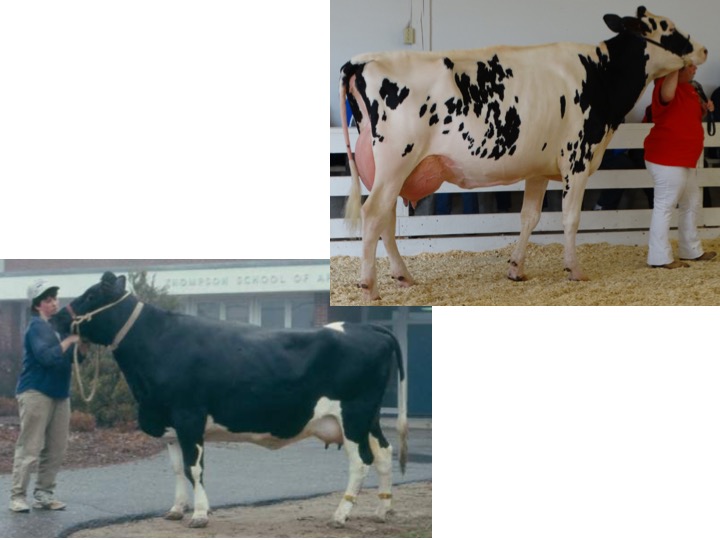
These two cows differ significantly in the category of frame, what terms could be used to describe each cow?
Negative Terms - be careful to not focus on the negative and only use these terms when describing why an animal is in last place
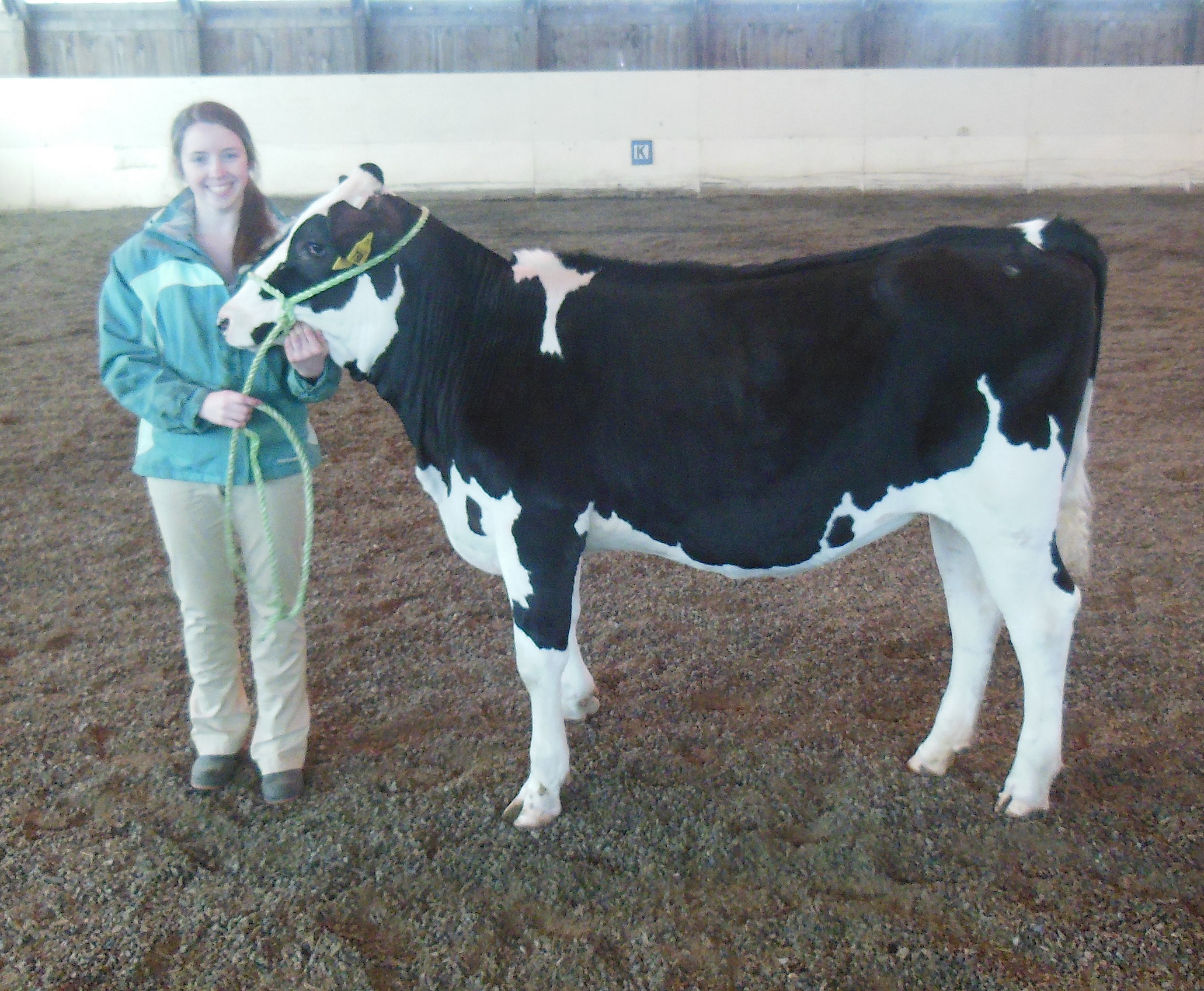
This heifer is showing a number of weaknesses, including a weak topline and overconditioning
- weaker in the topline
- shorter in stature
- greater slope from hooks to pins
- narrower through the pins
- higher in the tailhead
- more sloping in the rump
- shorter
- showing less frame
- lacks blending through the frame
- less harmonious blending from front to rear
- weaker in the loin
- weaker in the chine
- too high in the pins
- hips lower than the pins
- capped hip
- more prominent shoulder
- shoulder more loosely attached
- elbow less neatly set against the body
- tail set to one side
- weaker at the crops
Terminology for Dairy Strength
Positive terms
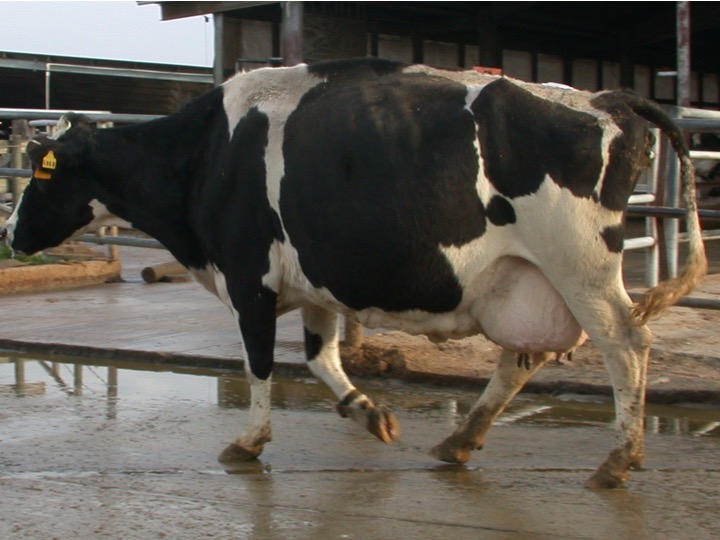
This cow is on a commericial dairy farm, but displays tremendous strength combined with angularity.
- More open ribbed
- Showing more depth and spring in the barrel
- Deeper bodied cow
- Showing more depth of heartgirth
- Leaner in the thighs
- Sharper over the withers
- Showing more angularity over the top
- Leaner and longer in the neck
- More smooth in the blending of the shoulders
- Wider in the chest floor
- More spring and depth of rib
- More angular from front to back
- More prominence about the hips and pins
- More incurving in the thigh
- Showing greater dairyness about the head and neck
- Displaying a milkier appearance
- More clean cut about the head
- Smoother in the shoulder
- Holding her elbows tighter to her body
- Flatter in the ribs
Negative Terms - be careful to not focus on the negative and only use these terms when describing why an animal is in last place
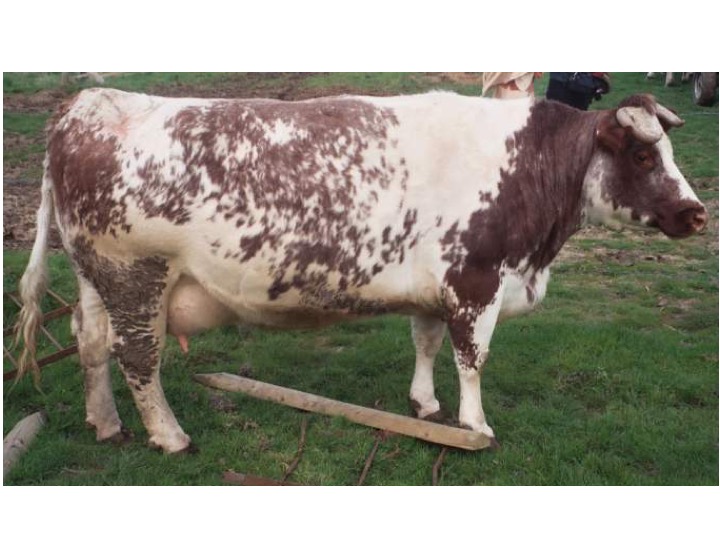
This is a very masculine looking cow, who is carrying too much flesh and is much too thick about the head and neck.
- Less feminine about the head
- Thicker in the neck
- Carrying excess flesh
- Thicker in the thigh
- Showing courseness about the head and neck
- Heavy in the dewlap and neck
- Showing less barrel
- Lacks smoothness of blending in the shoulders
- Weak in the shoulder
- Lacking depth of body, especially in the heartgirth
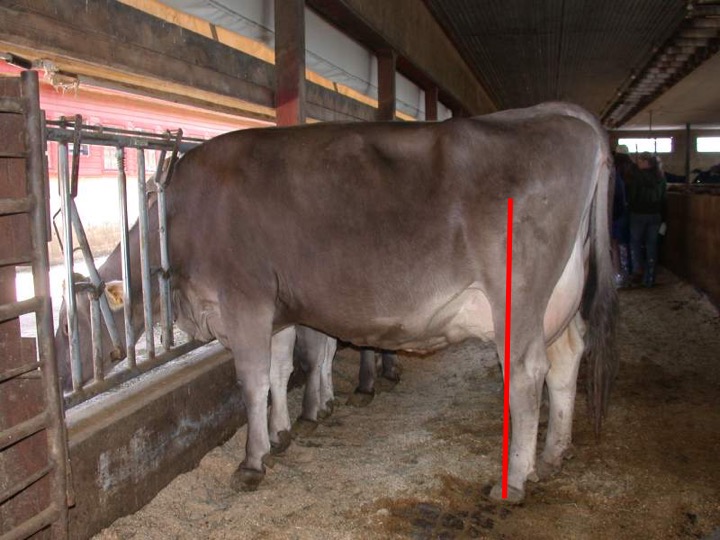
This late lactation yougn cow shows many outstanding characteristics, but is a bit post legged.
Terminology for Rear Feet and Legs
Positive terms
- Standing on a stronger set of rear legs
- More correct in her leg set
- Straighter and stronger in her pasterns
- Showing more ease of movement
- Tracking straighter on her feet
- A steeper hoof angle
- Stands more squarely on her rear legs
- Wider at the hock
- Flatter bone in the leg
- Standing straighter in her rear legs as viewed from behind
- Cleaner in the hock
- Deeper in the heel, standing more on her toes
- More correct set to the hock as viewed from the side
Negative Terms - be careful to not focus on the negative and only use these terms when describing why an animal is in last place
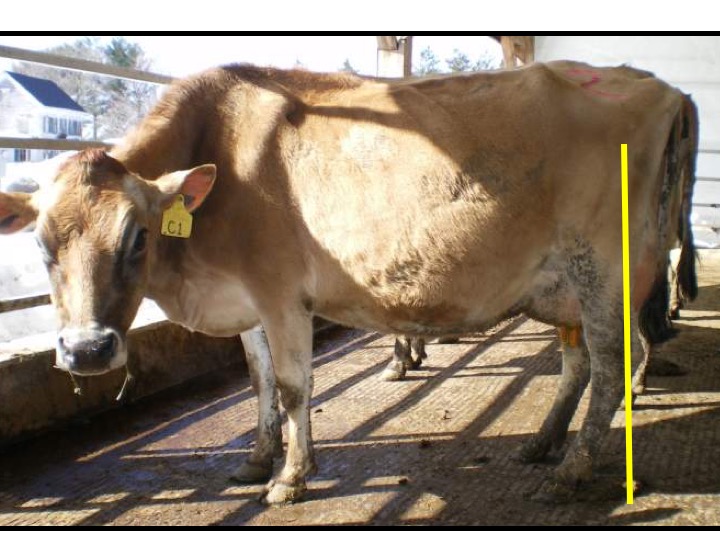
This cow is extremely sickle hocked
- Lower in the heel
- More shallow in the heel
- More sickle hocked
- Standing post legged
- Toes out
- Larger and puffy about the hock
- Showing some puffiness in the hock
- Weaker in the pasterns
- Lacking substance of bone in the rear leg
- Weak set of rear legs, being both sickle hocked and low in the heel
- Shows too much set to her hock
- Rear legs set too far back
- Showing signs of lameness
Terminology for Udder
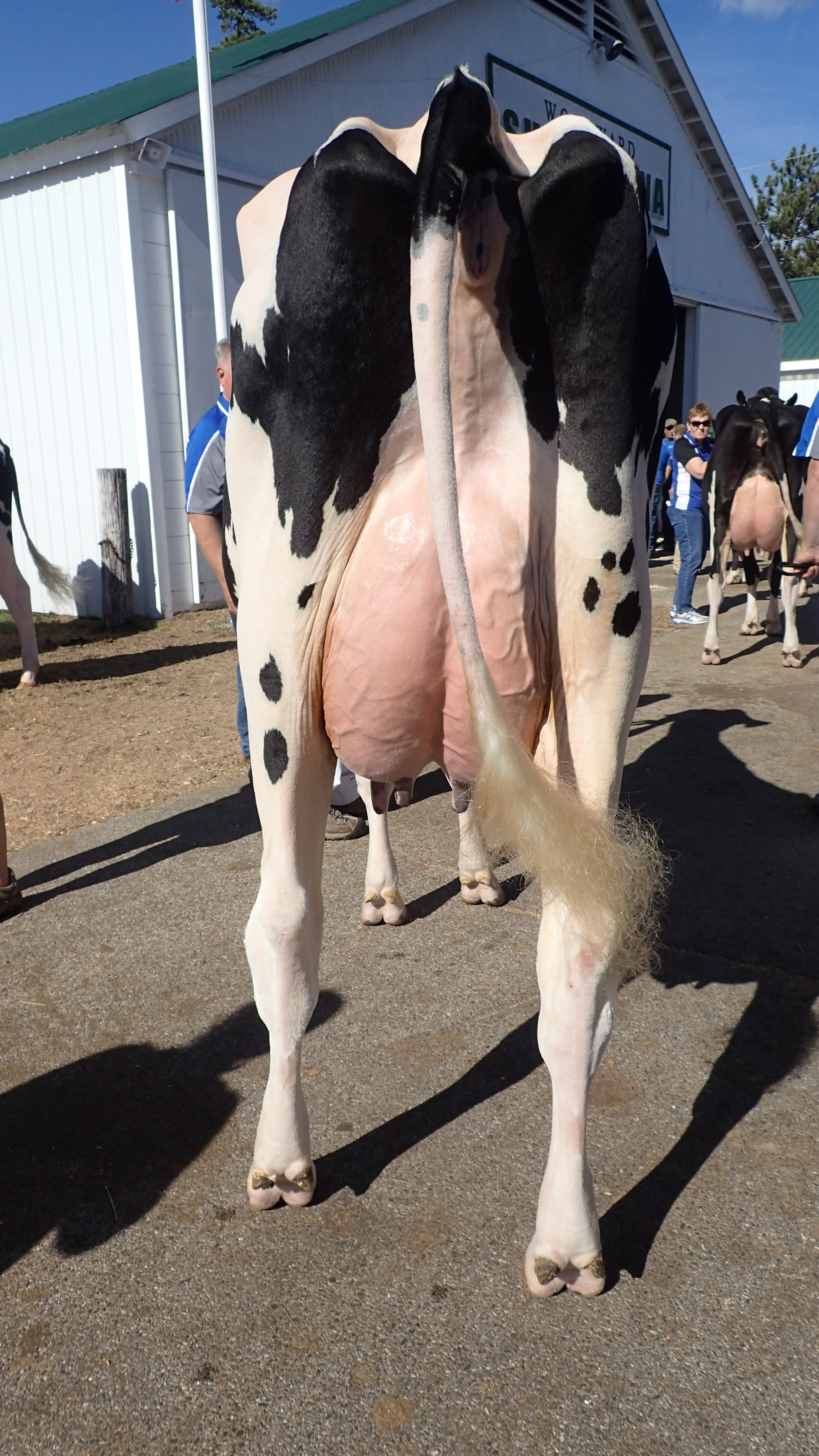
Highly desirable rear udder
Positive terms
- Smoother in the fore udder
- A fore udder that tucks more neatly into the body
- Strongly attached in the fore and rear udder
- More snug in the fore udder
- Wider rear udder
- Higher attachment of the rear udder
- More cleft
- Greater halving in the rear udder
- More balanced udder
- More level on the udder floor
- Udder is higher above the hocks
- The udder is more balanced from front to rear
- The udder shows greater capacity
- More bloom to the udder
- More prominent milk veins
- Shows greater udder quality and veination
- More symmetry and balance to the udder
- More correct teat size
- Teat more squarely placed on the udder
- Teats held closer together in the rear
- A higher rear udder attachment
- A deep cleft that goes higher on the udder
- Teats showing more desirable size and placement
- Teats that hang more plumb
- Teats that are squarely placed on the udder
Negative Terms - be careful to not focus on the negative and only use these terms when describing why an animal is in last place
- Loosely attached fore udder
- Bulgy in the fore udder
- Unbalanced in the fore udder
- Too short in the fore udder
- Lower rear udder attachment
- Less width in the rear udder
- Showing less cleft
- A weaker medial suspensory ligament, resulting in less cleft
- A cleft that does not track to the top of the udder
- Lacking balance in the rear quarters
- Less level on the udder floor
- Lacking symmetry and balance from front to rear
- Showing a lack of udder quality and veination
- Lacking bloom and quality
- Pendulous udder
- Round tight udder
- Rear teats that are too close
- Rear teats that are too wide
- Front teats too wide
- Lacks defined halving in the rear udder
- Light in her (right rear, left front, etc) quarter
- An extra teat might interfere with milking
- Shows congestion in the udder
- Teats that are too large
- Teats that are placed to far out
Chapter 6- Learning to Present Oral Reasons in Dairy Cattle Judging
After learning the basics of judging cattle based on physical traits, it is important for students, and for people who hope to judge cattle in public to be able to give reasons orally. At cattle shows exhibitors are interested in knowing why their individual animals were placed in a certain way, and a good judge provides organized, comparative and positive reasons for why animals were placed a certain way in any line-up. In 4-H, FFA and collegiate judging contests, providing reasons for the placing of classes of four cows or heifers is used in ranking and recognizing individuals and teams for their dairy cattle judging skills. Good reasons need to be accurate, reflect the proper emphasis areas on the scorecard relative to the animals being judged, as well as be organized, provide adequate detail and be presented in a manner that is comparative rather than descriptive in nature.
First and foremost in presenting reasons is need for being accurate. The best presentations or detailed reasons are really irrelevant if they do not show that the animals have been judged and described comparatively in an accurate manner. This means that the person giving the reasons has to be able to organize their thoughts and present them with effective communication skills.
Some people who know cattle and how to judge them never master the ability to give reasons, especially in a public setting without notes. There are various ways to prepare for giving reasons, but like any other skill it takes practice and is a learned skill. In fact, some judging coaches, teachers and college instructors will say learning to give oral reasons clearly and with accuracy and confidence is one of the most valuable skill that a person can take away when learning to judge cattle. As dairy farms become larger, fewer in number and less common in rural areas, learning oral communication skills while judging dairy cattle, is a skill that goes far beyond the actual judging and placing of cattle in a show or competition.
The easiest way to think about reasons, is to first simply remember that you placed a class for some reasons. The trick is to learn to systematically present the reasons in a way that does not really change from class to class or cow to cow. It helps keep your thinking organized and help a judge from getting side tracked or getting stuck on the attributes or problems one cow may have. The other general bit of advice I give students in giving reasons is start small and remember to be positive. You offer comments about cows in pairs, no matter how many you are judging. Start with describing briefly why one cow is superior to the other. Below are some examples of how to start without being overwhelmed with more than two animals. This is just a way to begin. I will present more detail and examples of giving a full set of reasons below.
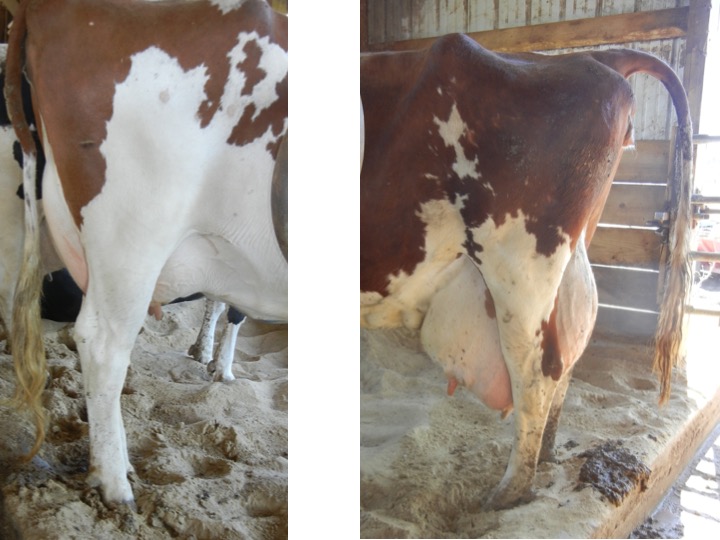
Look at these two udders. They are from cows of different ages, which would not be seen in a contest, but what are the differences that are important in placing one cow over the other? Obviously start with the udder, and look at fore udder, rear udder and udder height.
With the above pair of Red Holstein udders you should start with the fact that the cow on the left (call her cow 1) holds her udder higher above the hock, faulting the cow in the right (cow 2) for having a loosely attached udder in both the fore and rear. The cow on the right also has an udder held below the hock, and an udder that is not level on its floor. A set of reasons might be, "I placed cow 1 over cow 2 for holding her udder higher above the hock, with a more level udder floor. She is also higher in her rear udder attachment and stronger in her fore udder. However, cows #2 cannot place any higher because her udder is held to low in relation to her hock."
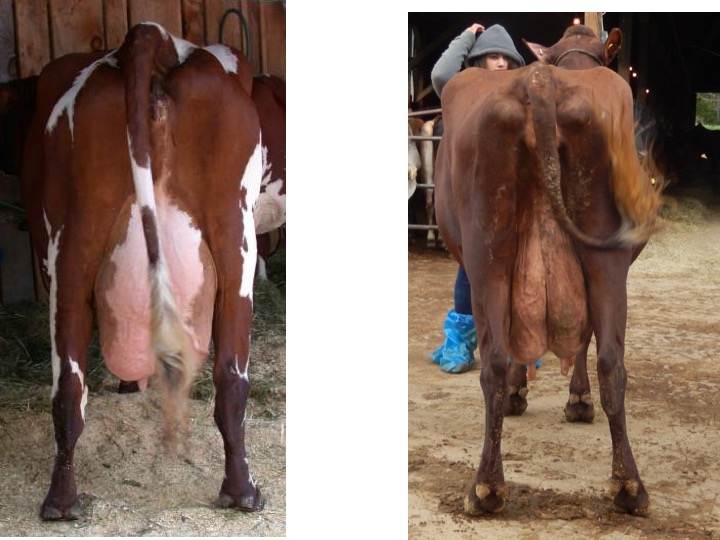
Like the last pair of cow udders, consider the cow on the left to be cow 1 and the cow on the right to be cow 2. Now evaluate both animals and develop a few reasons why one cow would place over the other just based on rear udder traits.
Examples for learning to articulate a set of reasons
Start with developing reasons for just a pair of cows, beginning with only evaluating one characteristic, the udder. This focuses the beginner on just a few traits at a time and is not as overwhelming as looking at the whole cow, or a whole group of cows and becoming frustrated with too many things to look at and not enough time to do so.
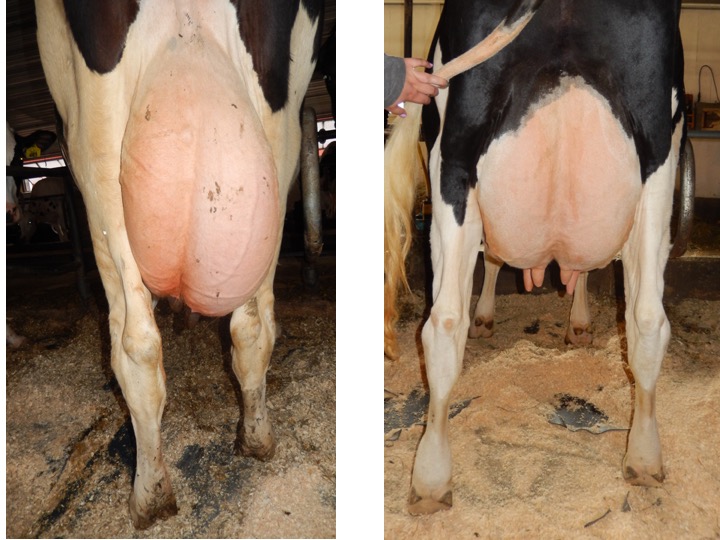
Here are two Holstein cows, evaluate their rear udders, and provide a short set of reasons why you placed them the way you did.
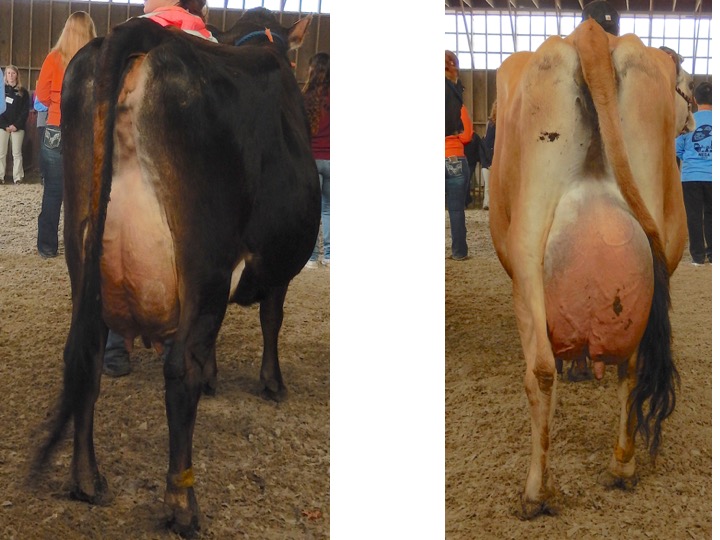
Again use these two udders for practicing both judging and developing simple reasons. Cow 1 is on the left and cow 2 is on the right.
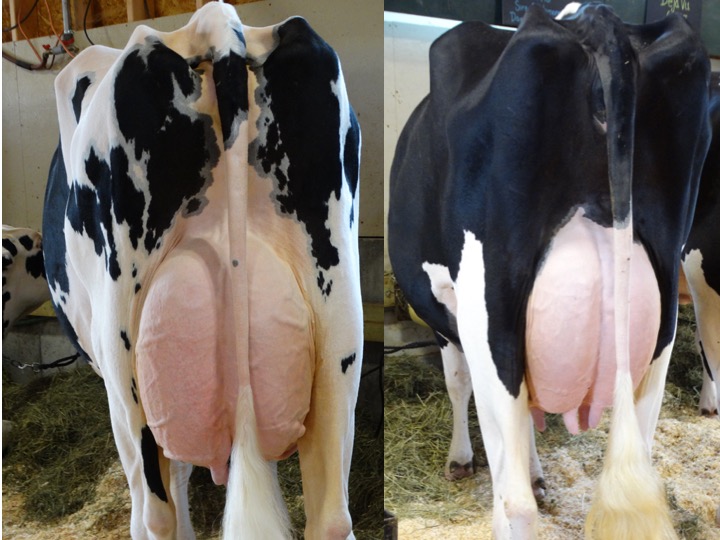
These two Holstein cows were on their way into the showring at a regional fair. The quality of these two udders is higher and will be more challenging to evaluate. However, look them over, and decide on a few reasons why you placed them a certain way.
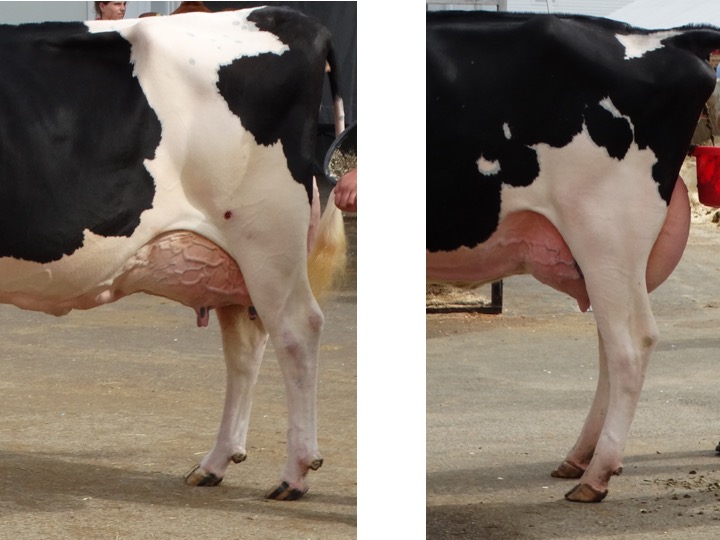
Evaluate these two Holstein udders, again from higher quality animals and develop some reasons as to why they should place a certain way.
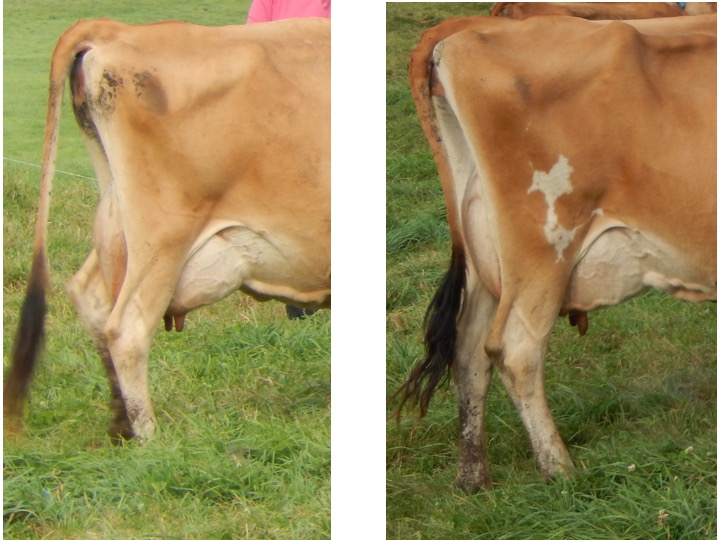
With these two cows please evaluate and develop reasons for placing these two cows based on both a side view of the udder and their rear legs as viewed from the side.
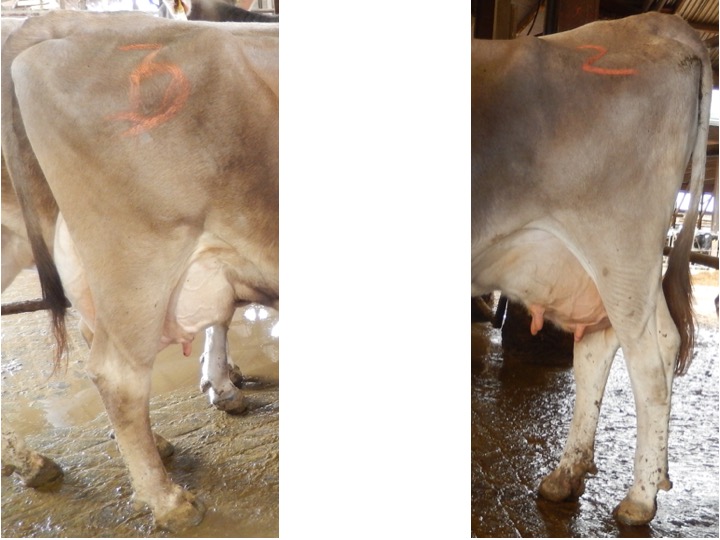
Now the example is more challenging. Please evaluate 3 different body parts. The udder with only a side view, the rear legs and feet, as well as the rump angle on these cows. Take more time, look at the PDCA Unified Scorecard and place the pair of animals. Again the cow on the left is cow 1, the cow on the right is cow 2. Now justify your placing by writing some positive reasons as to why one cow ought to place over the other, with a single fault for why the other cow is below her.
For the beginning judge the reasons should be at least 2 minutes long. This is only 30 seconds per animal, and with talking in a normal tone and pace, it does not require a huge amount of effort. However, giving reasons does require practice.
What do you need to know when giving reasons?
Watch this video for some great tips and examples for giving reasons.
More Examples of Oral Reasons
Holstein Jr 2 yr olds
Chapter 7- Fitting and Showmanship
Throughout the United States, and in many countries of the world, dairy cattle are exhibited and prepared for public shows and competitions. In doing so the cattle are fitted, which means they are fed to the optimal body condition and later clipped and cleaned to exhibit the animals in their best possible condition, showing off their attributes and minimizing their flaws in conformation.
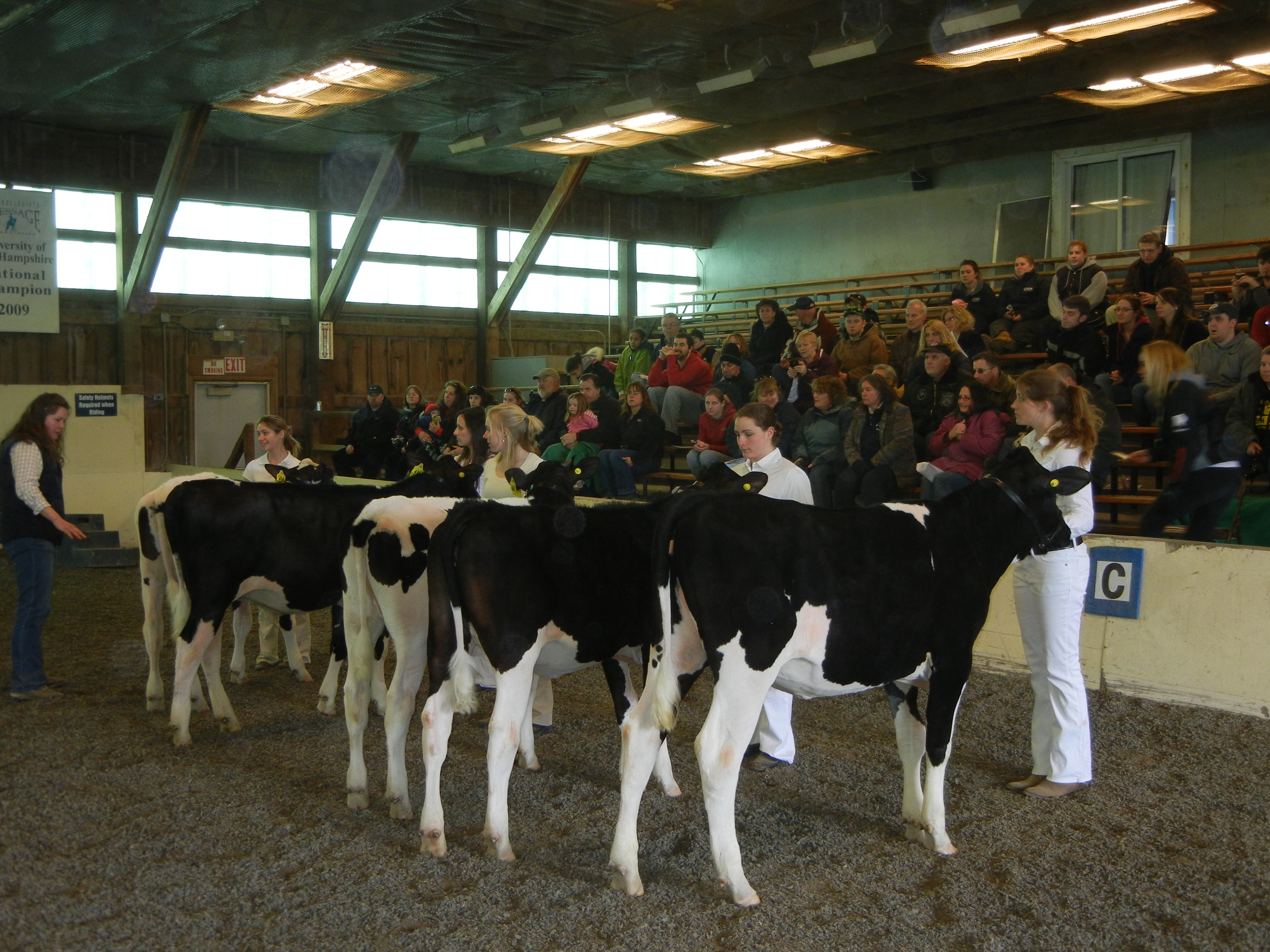
Dairy heifers being shown at the UNH Little Royal
First and foremost animals need to be prepared months in advance through proper feeding, housing, and care. Having animals in the best condition for their stage of life and/or stage of lactation at the time of a show, with shiny clean hair coat and being free of blemishes or disease problems like ringworm, is critical for good public relations. The nutrition of the animal also will impact its size compared to other animals of the same age, which is important in showing heifers. In dairy cows that are lactating it is important to have animals that appear to be lean and angular. This is a sign of high milk production, but at the same time it is also important that the animals not be too thin or too fat, as to distract from their other attributes.
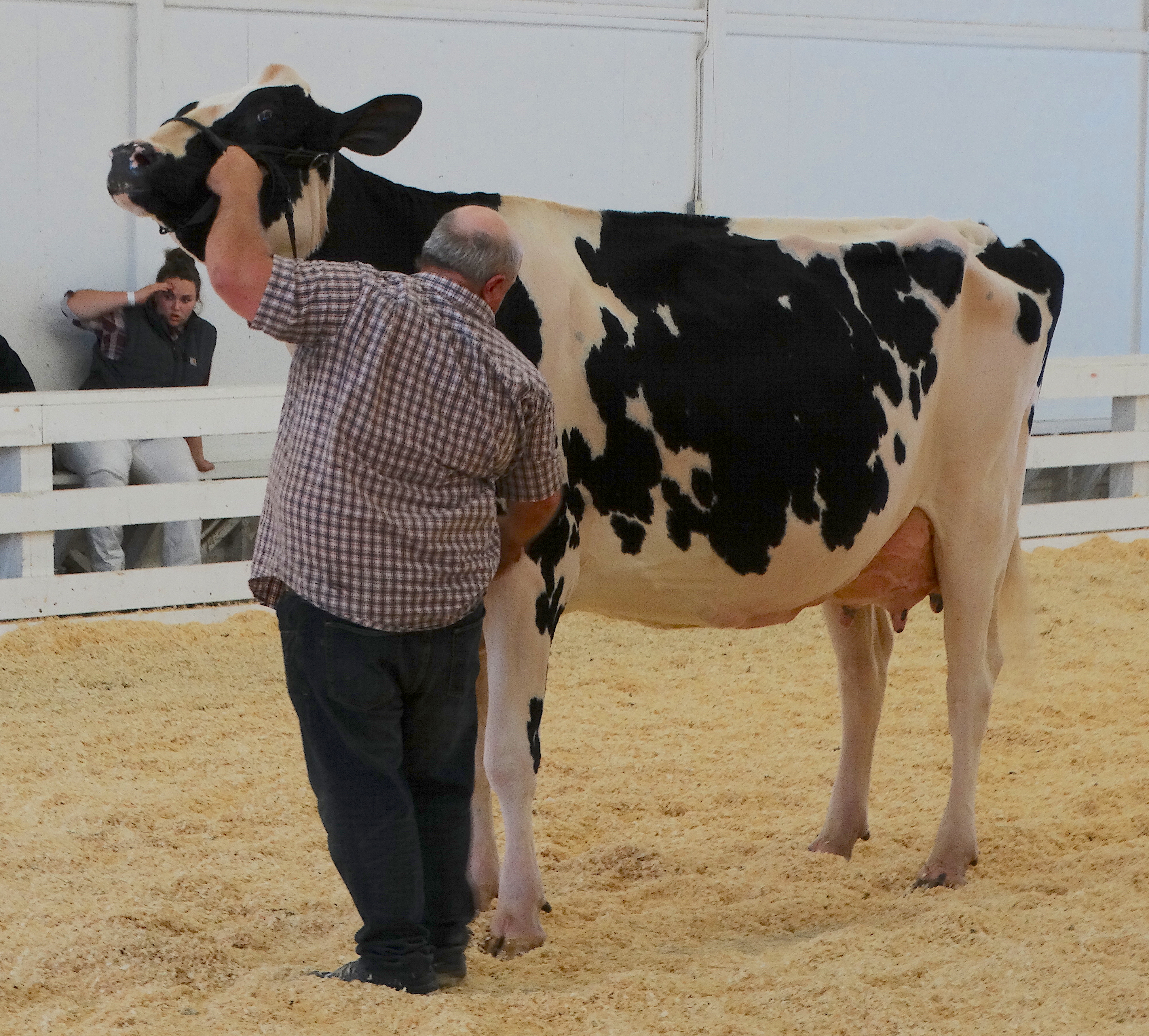
This cow just won her class, in part due to her size, angularity, udder shape, balance and attachments, but also how high it is above the hock. She is also very well trained, and almost poses in the show ring for her handler without any fuss.
Second cattle that are exhibited need to be trained. Cattle are fairly easily trained to lead, especially at a young age. If they are trained to lead and have had adequate numbers of hours in a halter as a calf or heifer, they will remember how to behave and respond to their handler for months and even years after training. Well behaved dairy cattle need practice. it is important that the handler understands how to train the animal and works with them regularly before a show. Cattle can also learn to hold their heads up, as desired by judges, as well as how to quickly place their feet squarely under themselves with minimal cues from their handler.
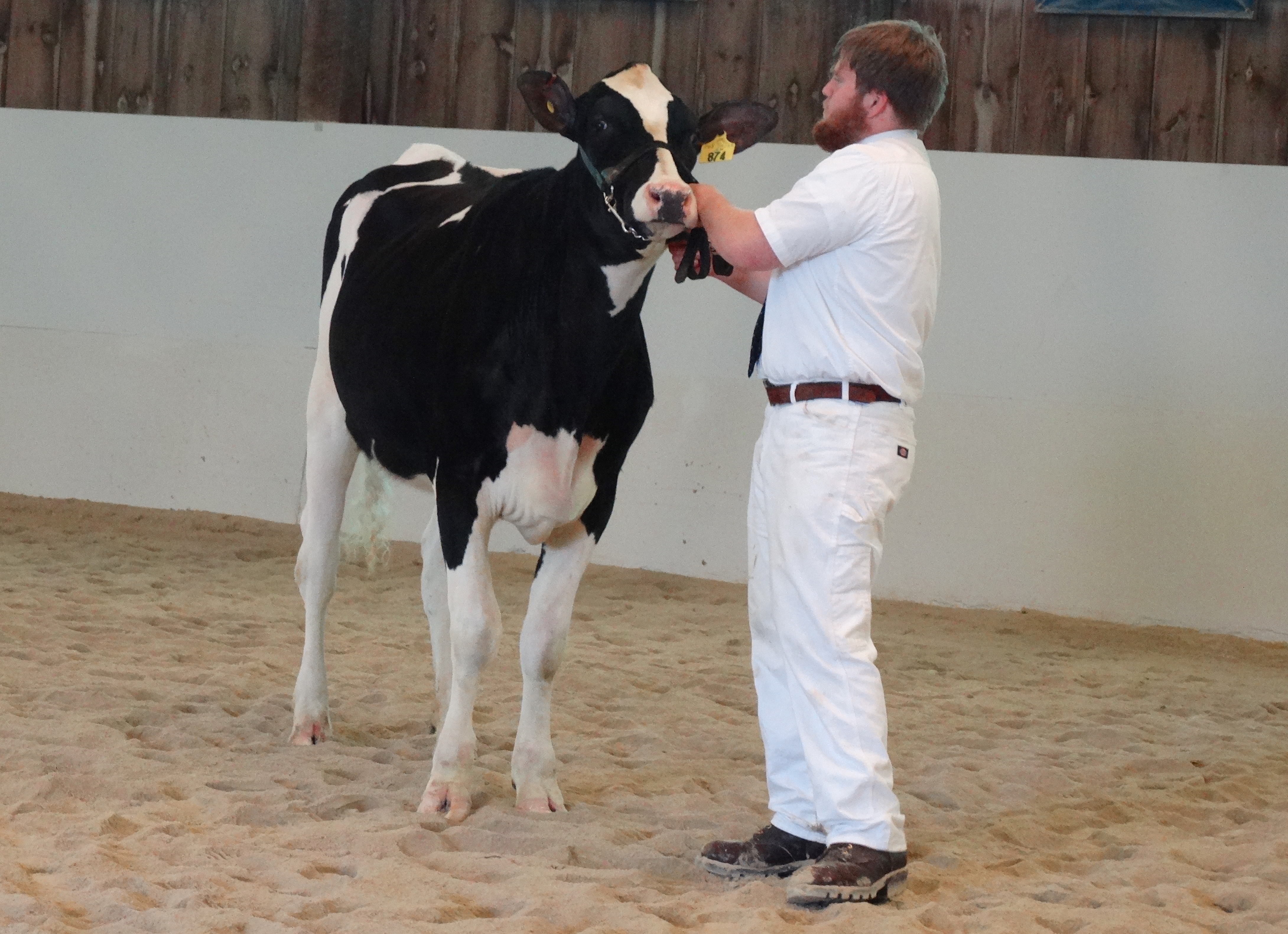
Heifer being shown by a student at the University of New Hamsphire
Finally, dairy cattle that are exhibited must be cleaned and clipped to present them at their best during a show. Cleaning can start by brushing the animals weeks before the show, which has the added benefit of acclimating them to their handler and the pleasure of being brushed. It removes loose hair and provides regular close inspections of the animals, allowing the handler to note any problems, blemishes, wounds, etc. Cleaning with an appropriate soap and ample water to remove dirt, dust, stains on the legs and other body parts. Washing should be done before clipping, so the clippers will not be dulled by dirt or manure on the animal. Clipping begins with closely clipping the hair on the head, neck and ears, and then clipping the body, legs, upper part of the tail. This is sometimes done with a different set of blades than the head and neck, possibly leaving slightly more hair on the body and belly, depending on the season of the year and the expectations of the show.
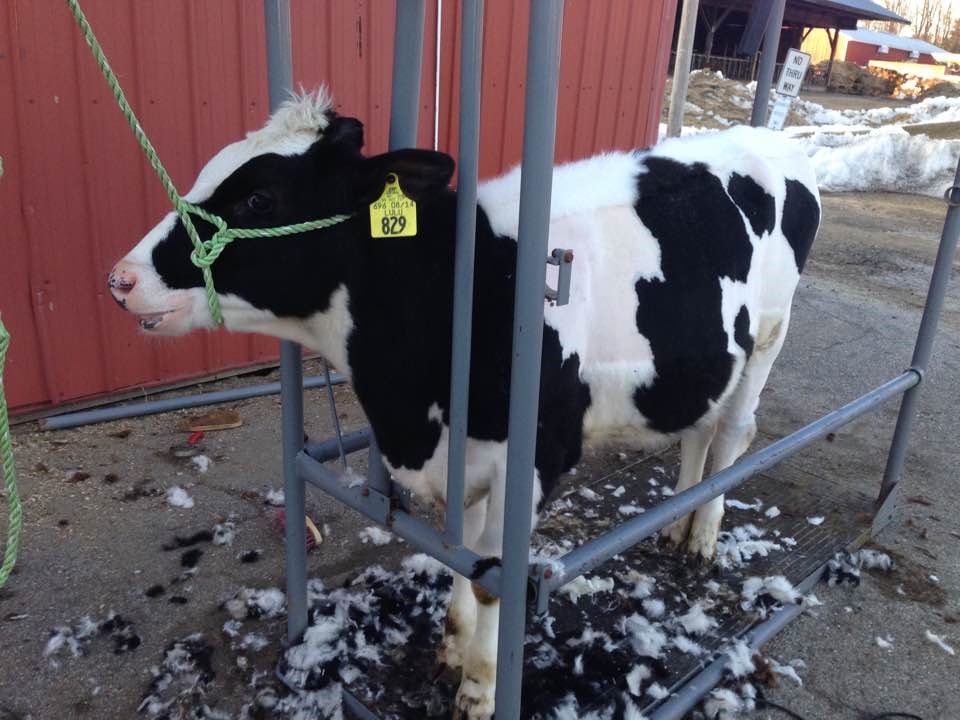
Clipping the heifer in a chute restrains the animal, making this process easier for both the handler and the animal.
If clipping for the first time it is important to learn how to clip before attempting to do it on an animal intended for show. Sometimes novices practice clip on animals not going to a show Another possibility is to clip the show animal weeks before the show for practice and then touch them up closer to the actual show day.
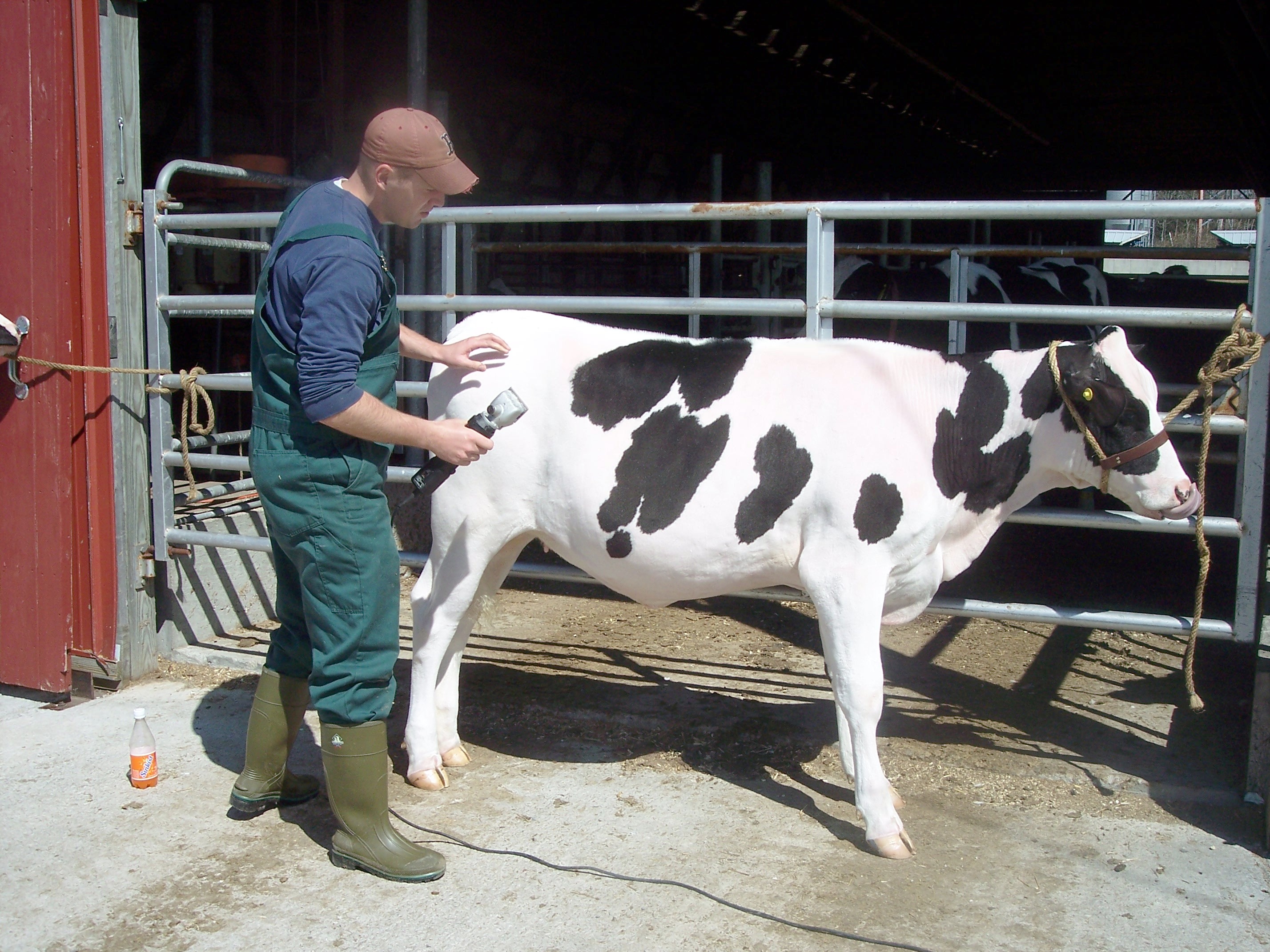
After the animal is halter trained, washing and then clipping the animal are essential before a show.
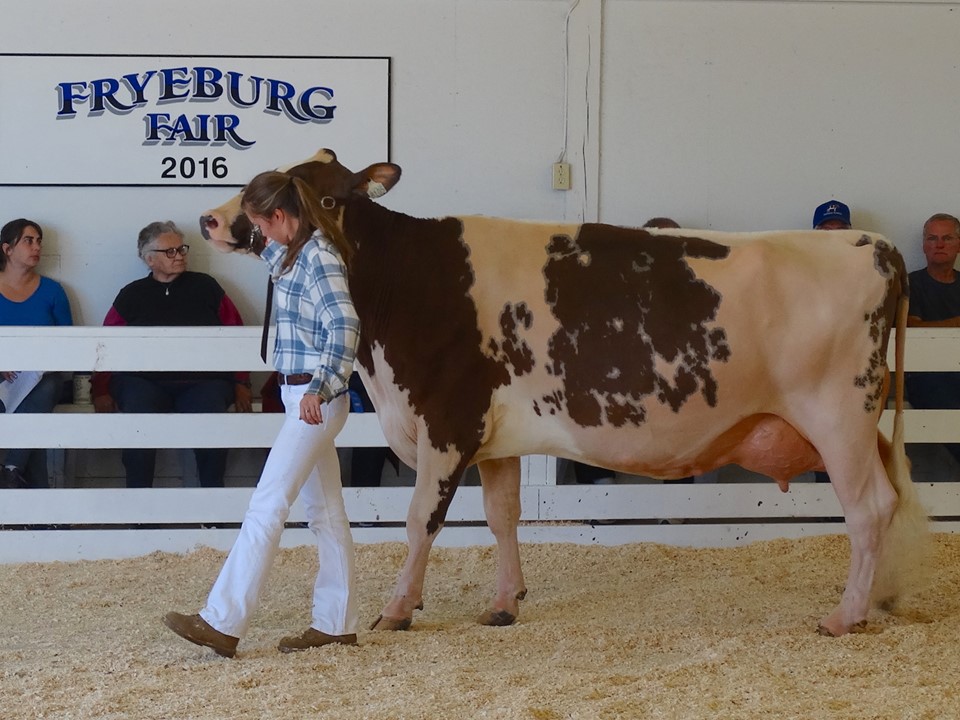
Presenting an animal for show ideally presents the animal at its best. This means training, so they pose and behave at the show. It also includes cleaning, and then clipping them to enhance femininity and angularity.
The following videos provide insight into how dairy cattle are to be exhibited.
Chapter 8 - Linear Classification of Dairy Cattle
Linear Classification of dairy cattle is used to assign scores (numbers) from 1-50 based on biological extremes that will be typically seen in 17 different body parts of modern dairy cattle. This system uses measurements assigned to important body parts versus opinions as seen in qualitative judging.
The system works to help people identify weaknesses or strengths in their herds, as this system of evaluation is done by professional classifiers who do this as a full-time job. The "classifiers" are therefore familiar with the biological extremes seen in animals and the practice and experience they have allows them to quickly assign numbers or scores to each body part assessed.
Linear classification is often something dairy farmers pay for in order to have their animals scored by professionals, who are supposed to be unbiased. Sometimes if not enough bull daughters have been classified by the dairy farmers, the companies who own the bulls will send a classifier to the farms where known daughters of the bulls reside and have them assessed with the farmer's permission. Linear classification assesses daughters of bulls, which are given scores based on their various body parts, such as fore udder, rear udder height, rear udder width, teat size, stature, hoof angle, and others. The data is important in also providing artificial insemination companies with unbiased information on the type or physical characteristics of daughters of their bulls across the United States. It also provides farmers with an outside evaluation of their herd and each cow with a record of her classification based on the 17 categories, which can be used for marketing or mating and selection purposes. Finally, the same classifiers also assign cows with a final classification score, based on 5 categories. These categories include Front End and Body Capacity 15%, Dairy Strength 20%, Rump 5%, Feet and Legs 20% and Udder or Mammary System at 40%. With this system the cow gets a single numerical score based on their conformation in these areas, and this number can change over time. These numbers generally vary from 60-97, with no cows scoring a perfect 100, and no cows scoring below a 50. Cows that score 90 or above are considered Excellent (E) in conformation, and this is a widely recognized accolade for the farmer and their cow. Cows scoring 85-89 are considered Very Good (VG). Cows Scoring 80-84 are called Good Plus (GP), Those scoring 75-79 are considered having a conformation that is Good (G). A cow that scores from 65-74 is considered Fair (F), and a cow from 50-64 is considered Poor (P). These scores, especially when Excellent or Very Good are used in marketing animals and can be seen on their pedigree.
Linear Classification is most easily learned using a worksheet designed to guide the beginning judge in what to look at when evaluating the 17 different body parts. FFA contests use a worksheet like this: Linear Scoring Worksheet without pictures
The U.S. Holstein Association has put together the following Guide that can be downloaded from their website, or found in the booklet on dairy judging as well. It is one of the easiest ways to learn what the biological extremes are that we find in dairy cattle. It is important to print or download this worksheet before attempting the exercises in scoring body parts below.
Linear Scoring Worksheet with Images
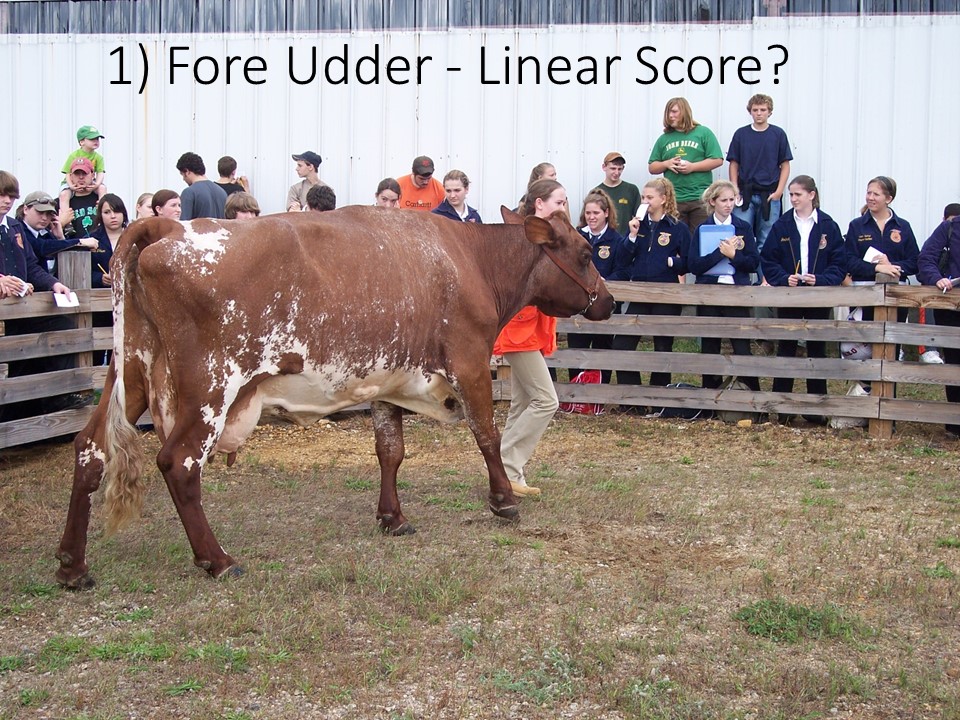
Practice Linear Scoring on this cow
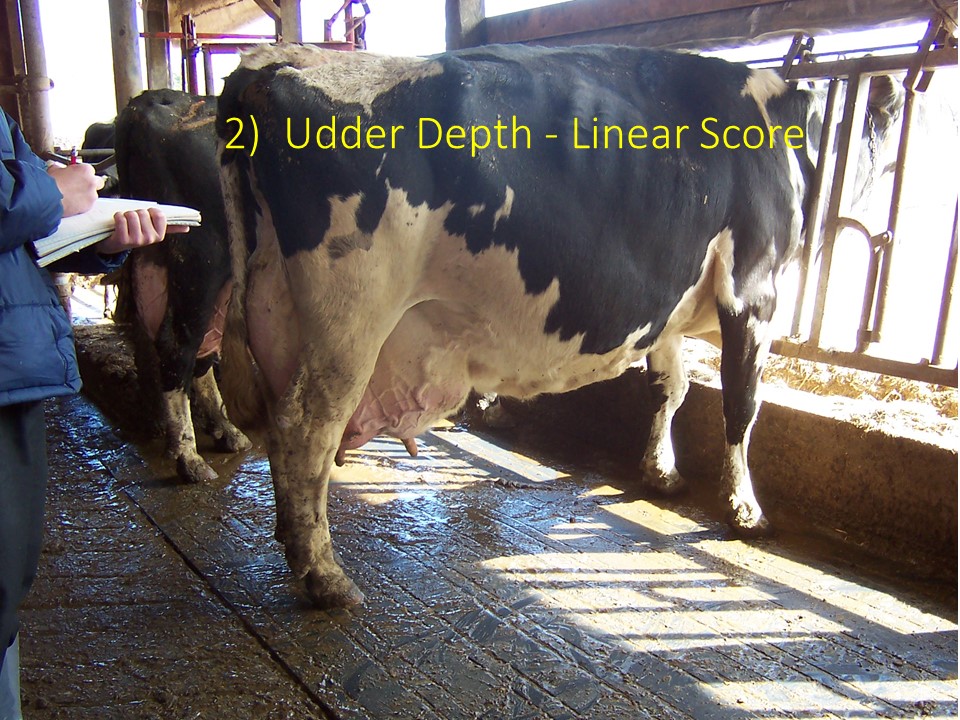
Practicing Linear Scoring on this cow
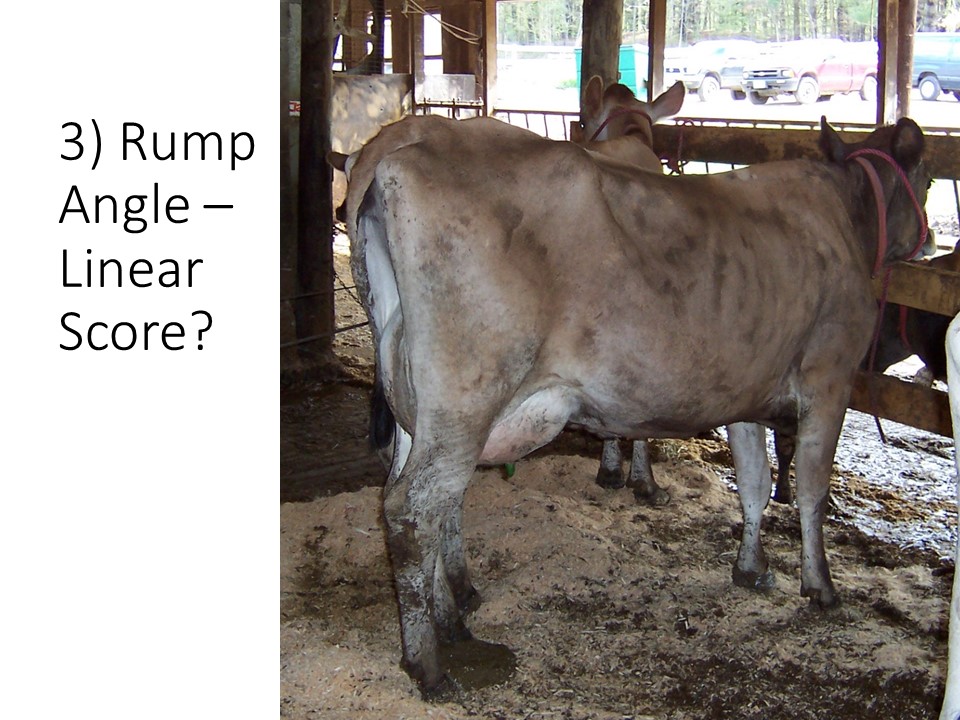
Practice Linear Scoring Rump Angle
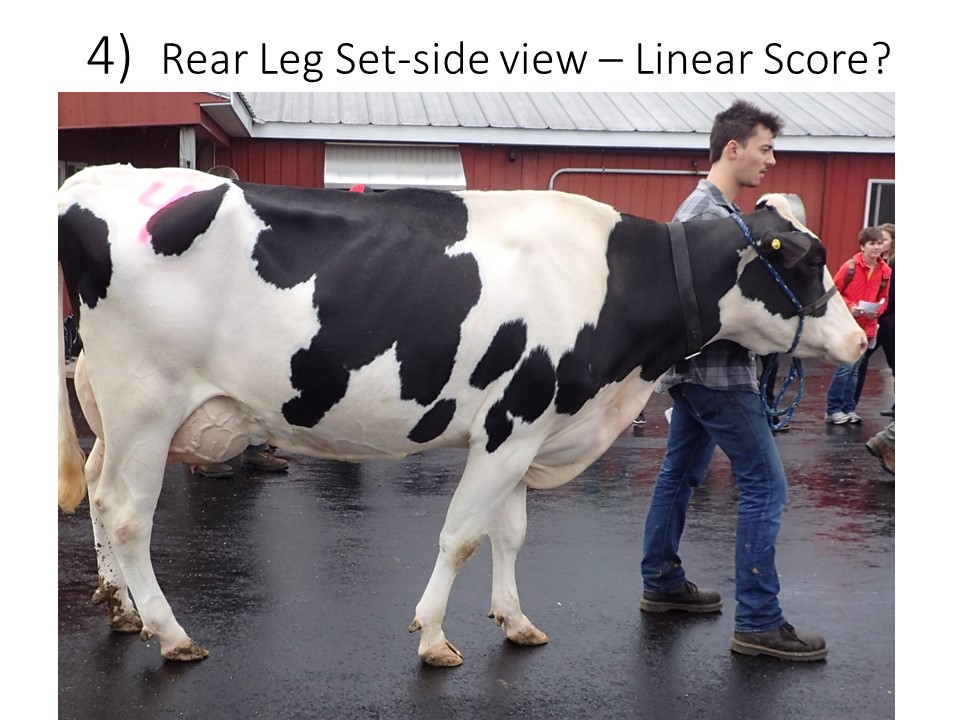
Practice Linear Scoring Rear Leg - side view
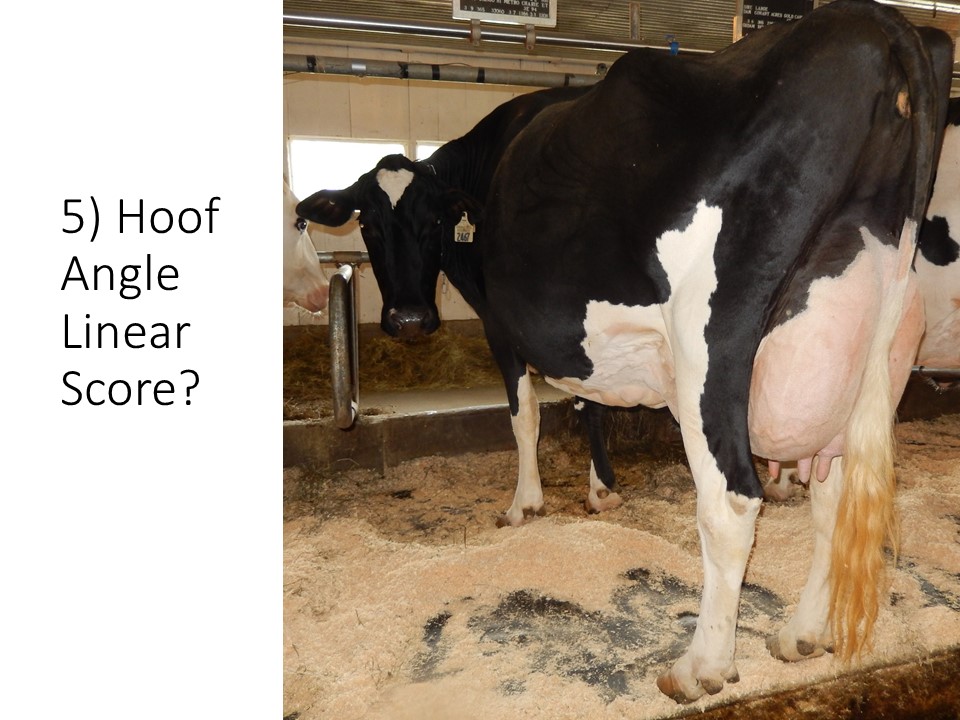
Practice Linear Scoring for Hoof Angle
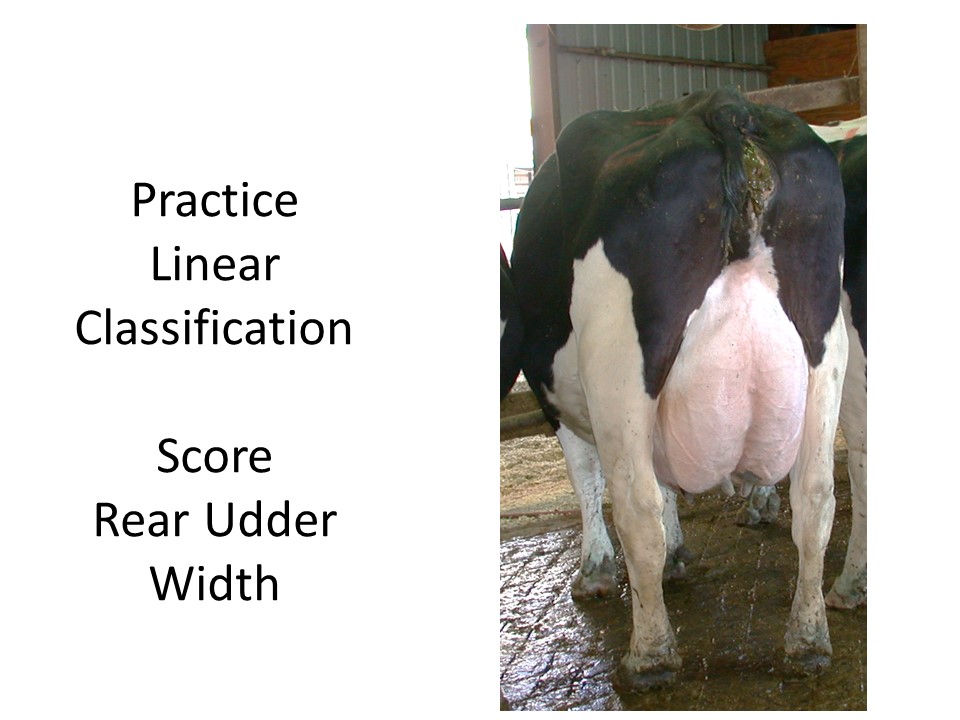
Score this cow for rear udder width
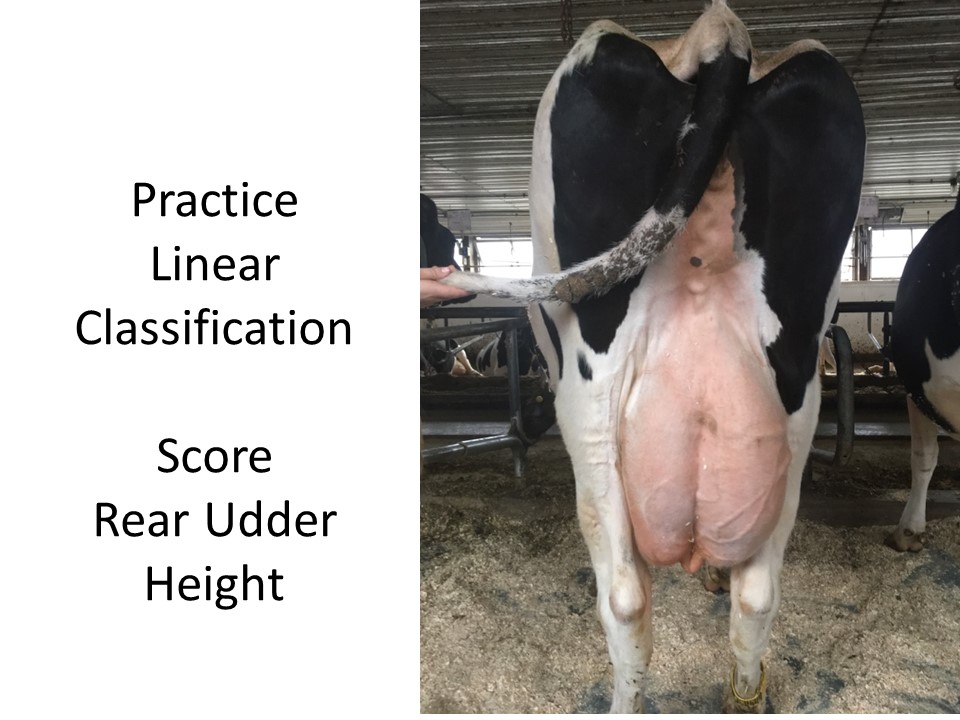
Score this cow for Rear Udder Height and also Rear Udder Width
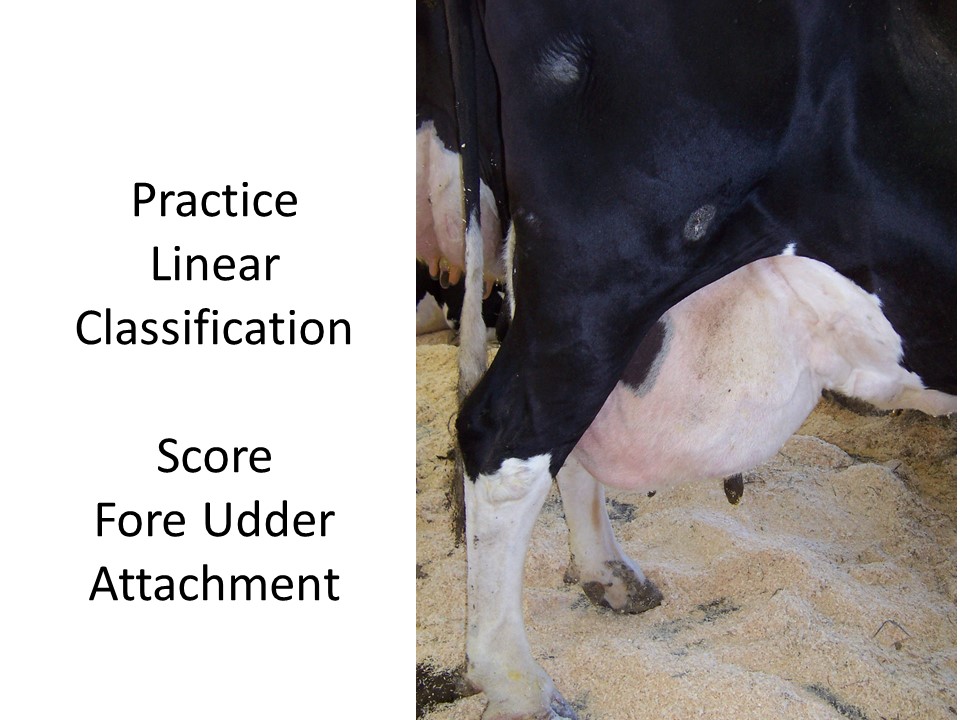
Linear Score Practice
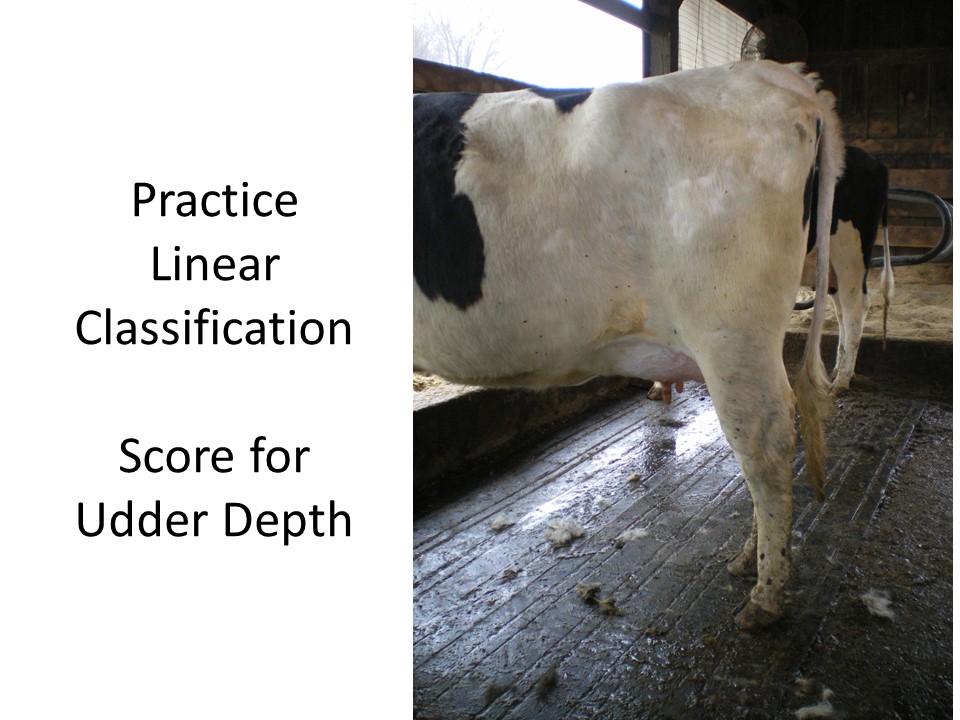
Linear Score Practice
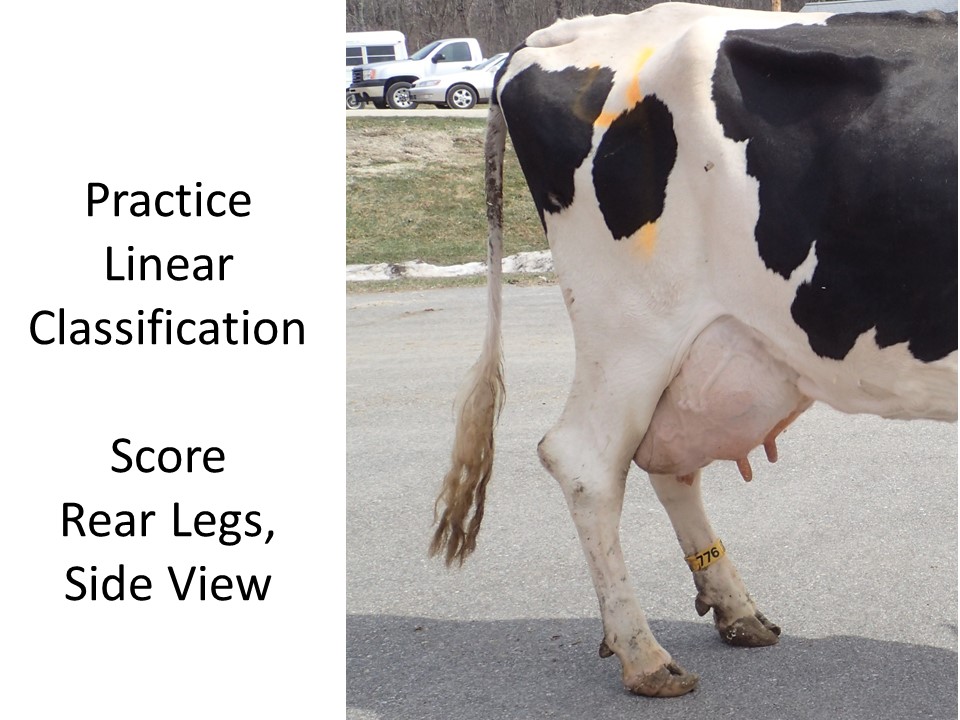
Linear Score Practice
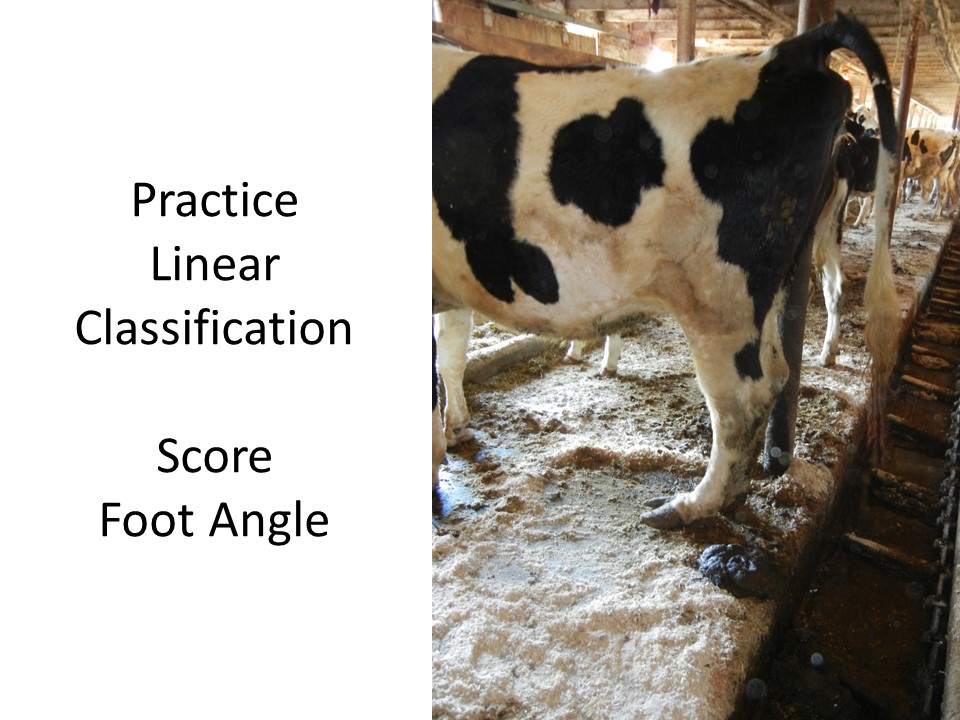
Linear Score Practice
Chapter 9- Dairy Cattle Pedigree Evaluation –
Many dairy cattle have production records and pedigrees that can be used to help evaluate the animals. These are often presented at cattle sales or auctions as a way to provide additional insight into the quality of the animals beyond what can be seen in a visual evaluation. In addition, the same pedigree and production information is integrated and used in dairy sire proofs, which allows people breeding cattle to have additional criteria and information in order to make sound breeding decisions.
The dairy pedigree is essentially a family tree of the animal, showing its sire and dam, grand sires and grand dams on both sides, and sometimes additional and more distant relatives. The value in this information is that it usually includes production data and final classification information about the animals, which is helpful in determining the quality of the animal someone is evaluating. The production and final classification information is not a guarantee that the animal in question will have the same traits, as genetics, and breeding animals involves the random mixing of genes, which results in the genetic diversity we see in any family of cattle or people for that matter. However, historically this information has been helpful in more or less "stacking the deck" with better quality animals, with known production records and traits, and by breeding the best to the best has allowed animal breeders and farmers to make positive changes for decades, without actual genetic information that over time will become more available in dairy cattle selection.
How to Read a Pedigree
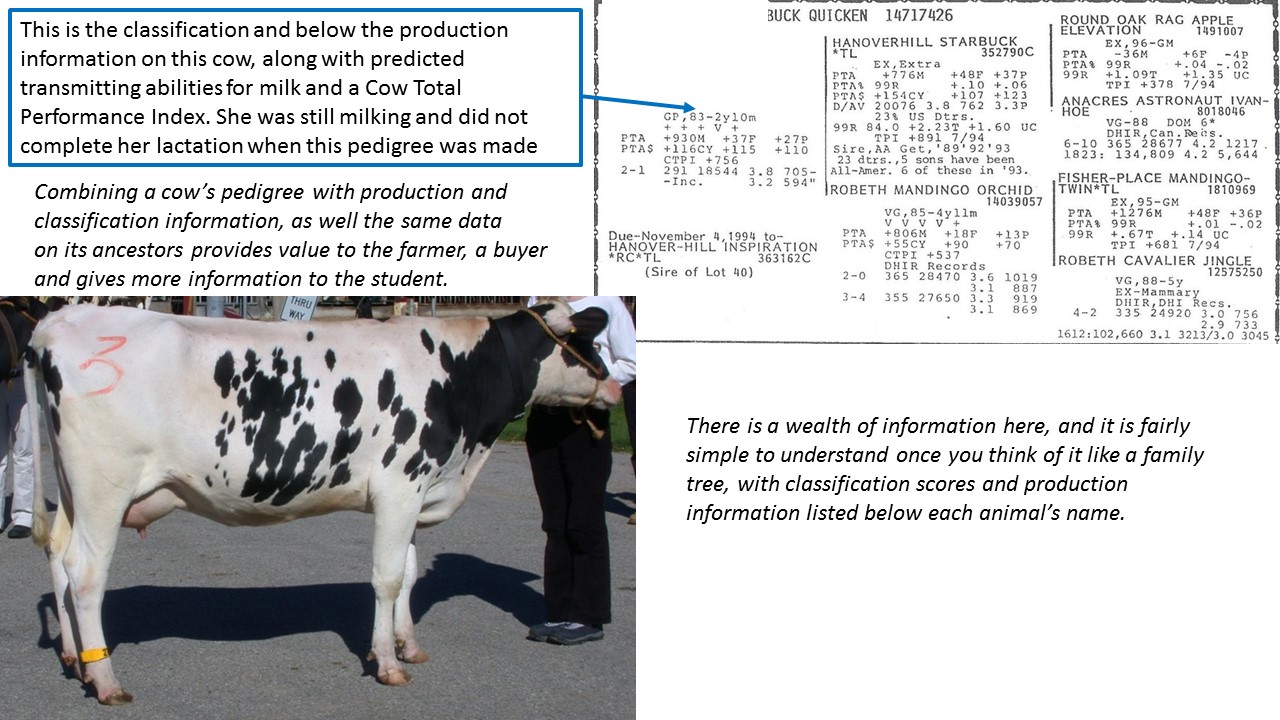
Here is a description of some of the data that are available on a cow pedigree
The Holstein Association on their Youth Page has an excellent short guide to reading and understanding a cow or bull pedigree. See: Booklet on Reading a Cow Pedigree
Holstein Pedigrees
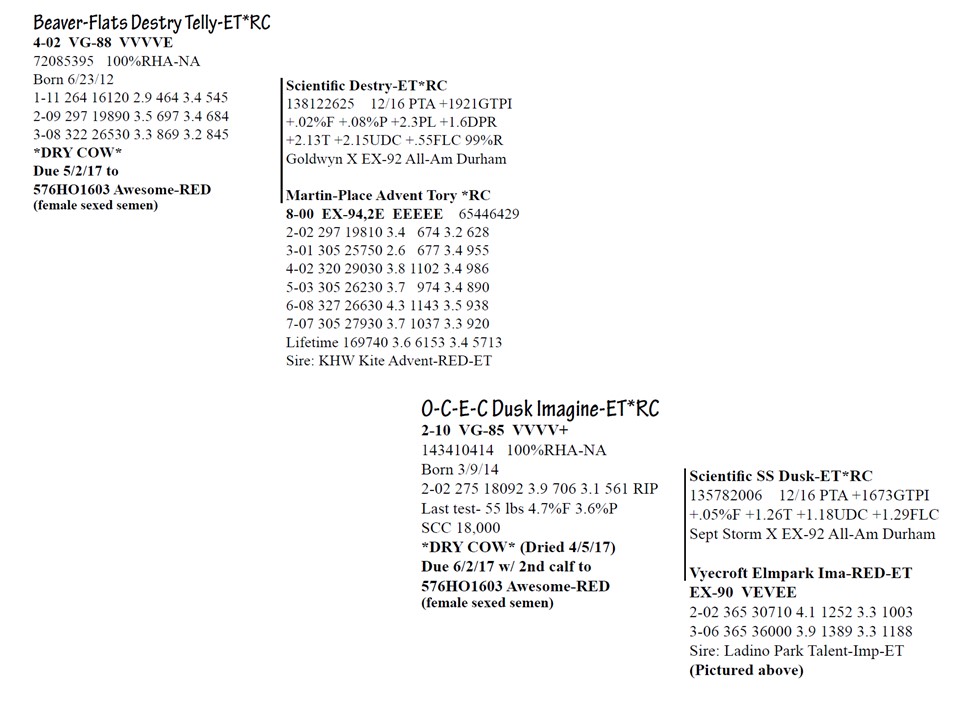
Use these pedigrees to practice evaluating animals, using DHI, Classification and other historic data
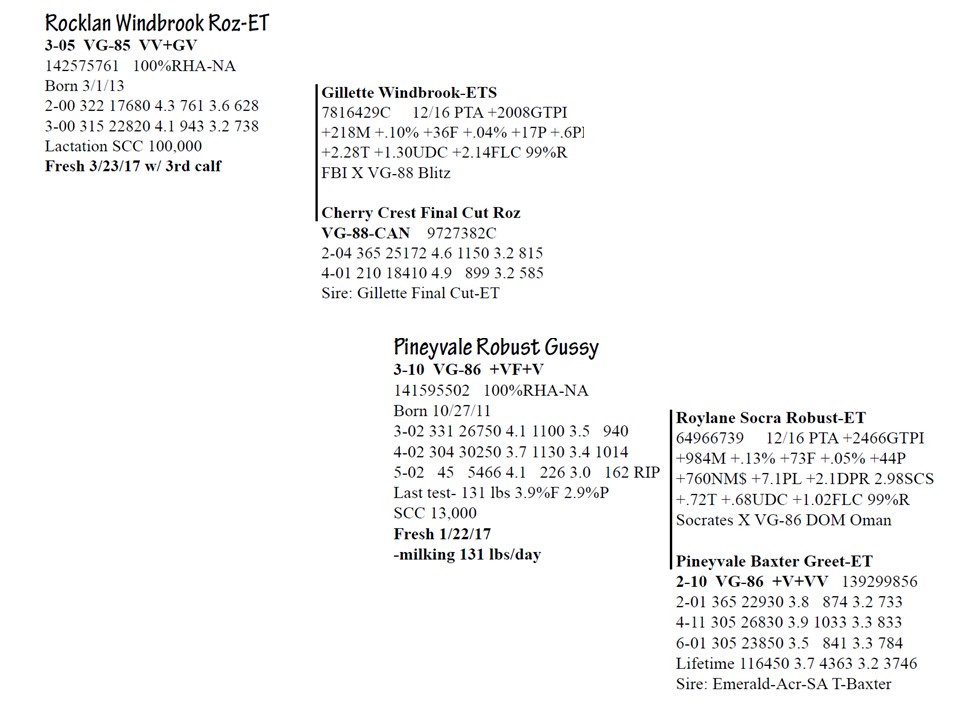
Use these examples to evaluate and place the four Holstein cow pedigrees
Holstein Heifer Pedigrees
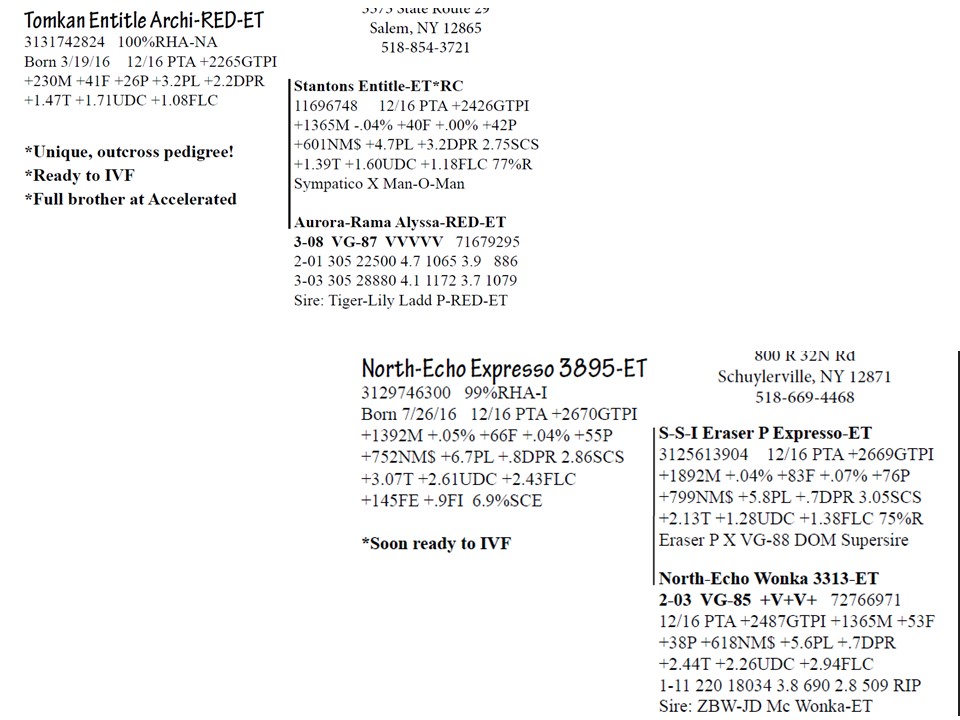
Evaluate and Place these 2 Heifer pedigrees
Ayrshire Pedigrees
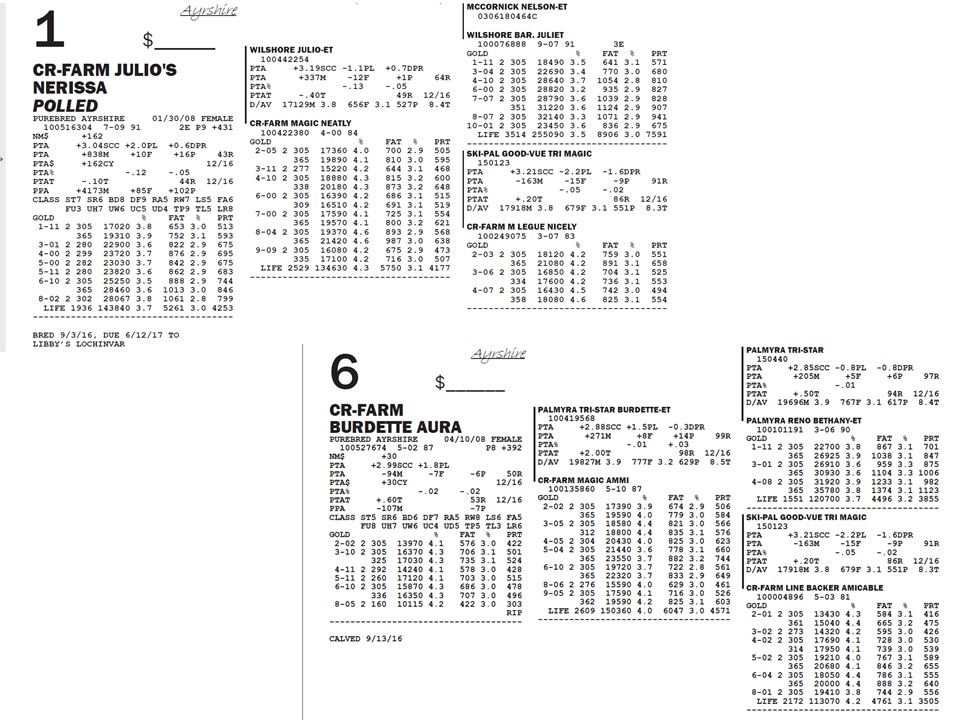
Use these pedigrees to evaluate the four Ayrshire cows
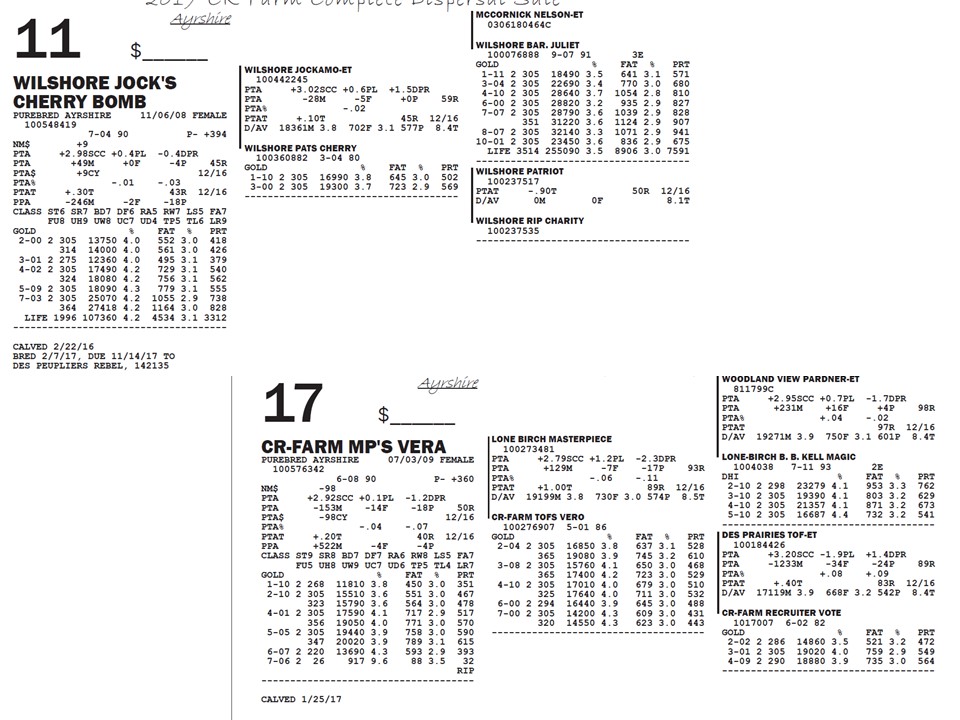
Use these two additional Ayrshire cow pedigrees to evaluate and place the four animals based on their DHI, Classification and Breed Association data.
Ayrshire Heifer Pedigrees
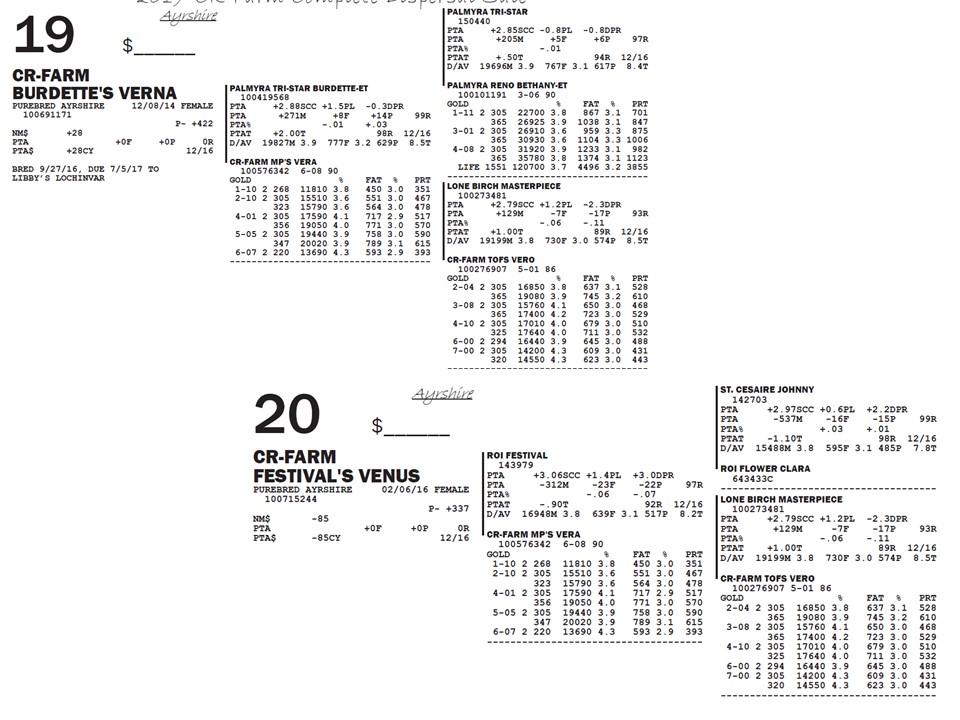
Use the four Heifer pedigrees to practice evaluating and placing the heifers based on the data available for them and their parents.
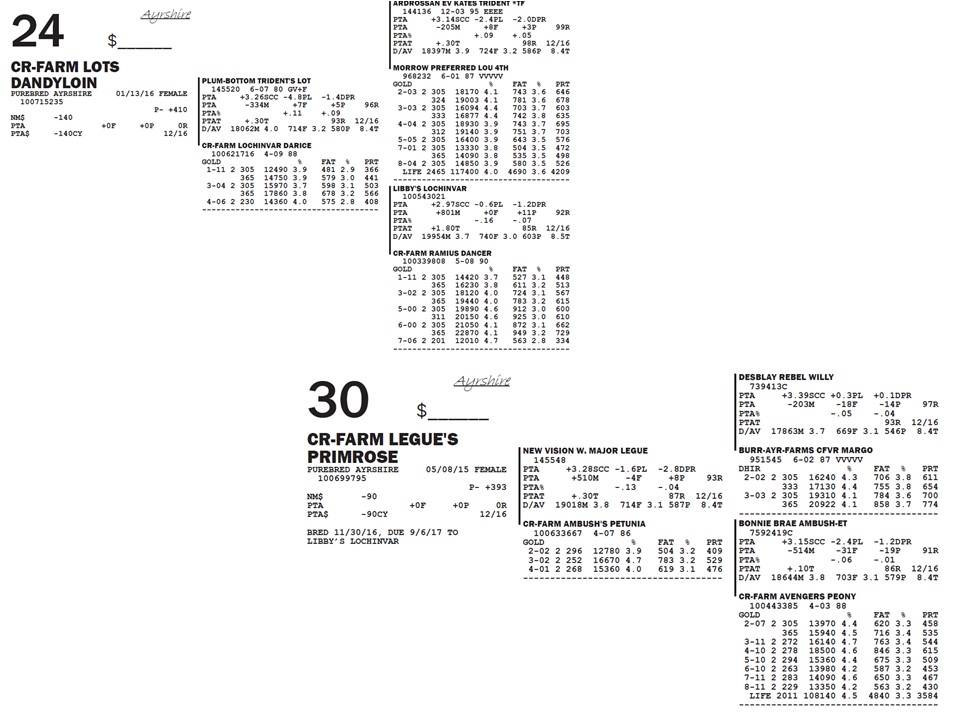
Use these pedigrees and the ones above to evaluate and place the four heifers.
Chapter 10- Dairy Cattle Evaluation Practice Classes –
Holstein 5 year old cows
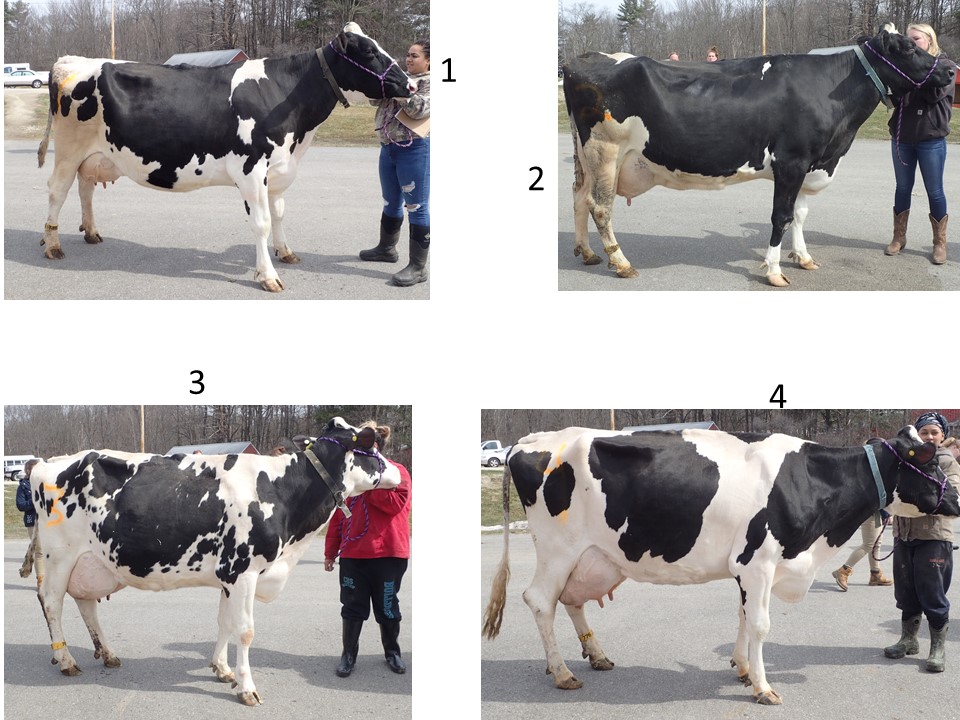
Evaluate these animals according to the Unified Scorecard and place them
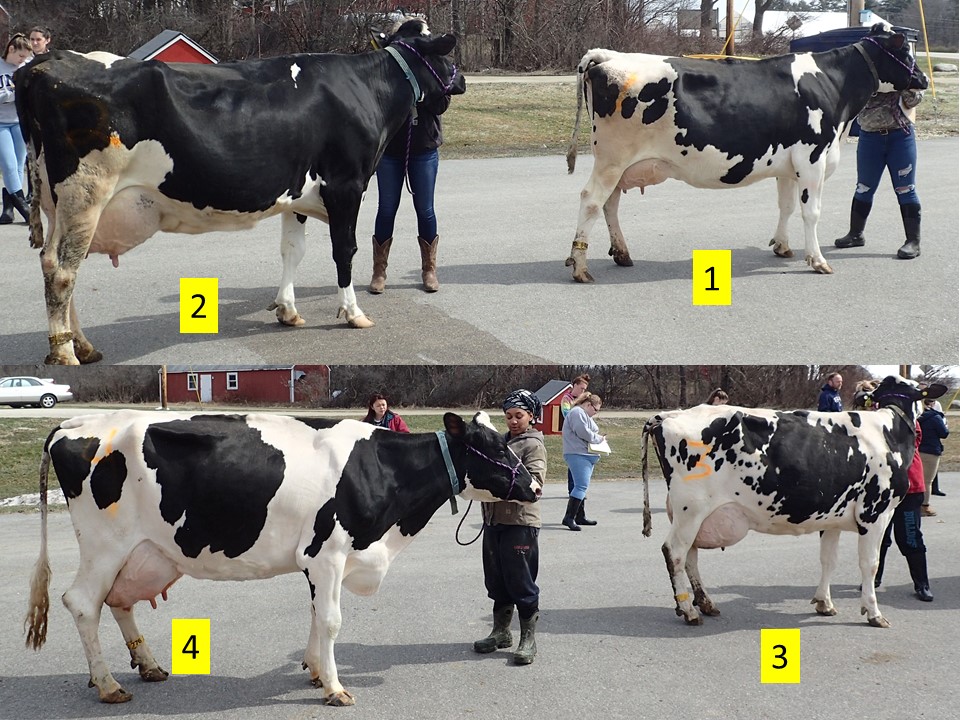
The cows are lined up together to make it easier to compare their actual size and stature
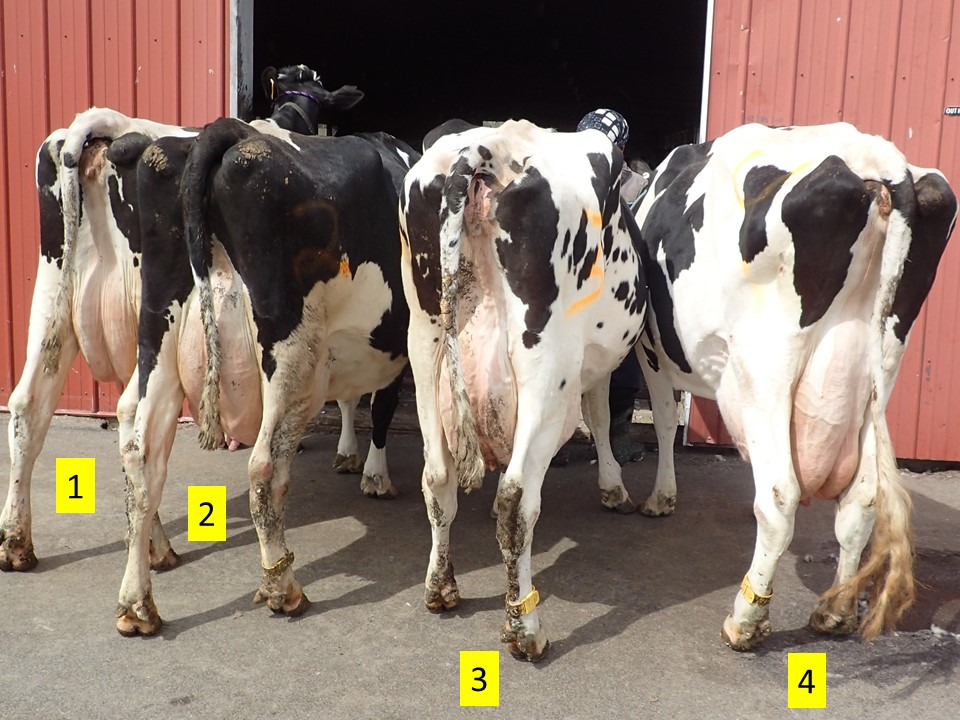
Side by side to compare size, the rear udder shape and height as well as a rear view of the hind legs.
Ayrshire 2 year old cows
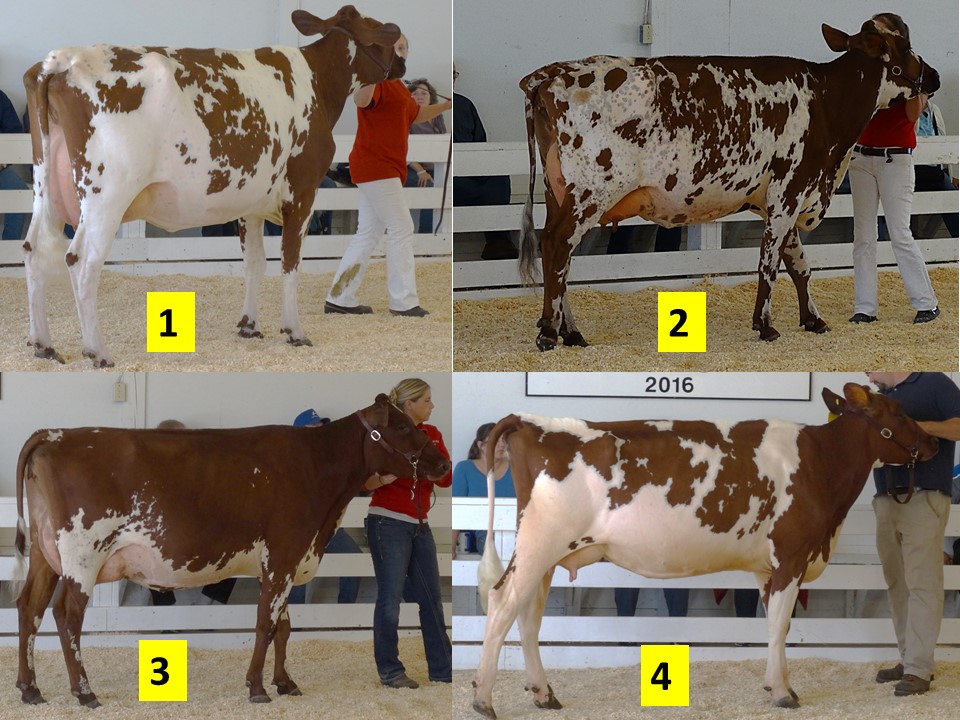
Please evaluate these 4 animals, based on the unified scorecard and place them.
Milking Shorthorn 4 year old cows
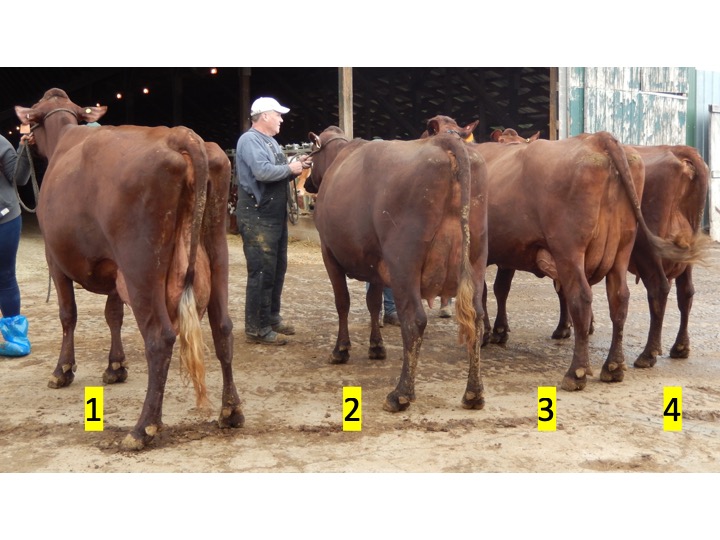
Use this photo and the others in this set to judge this class of Milking Shorthorn Cows
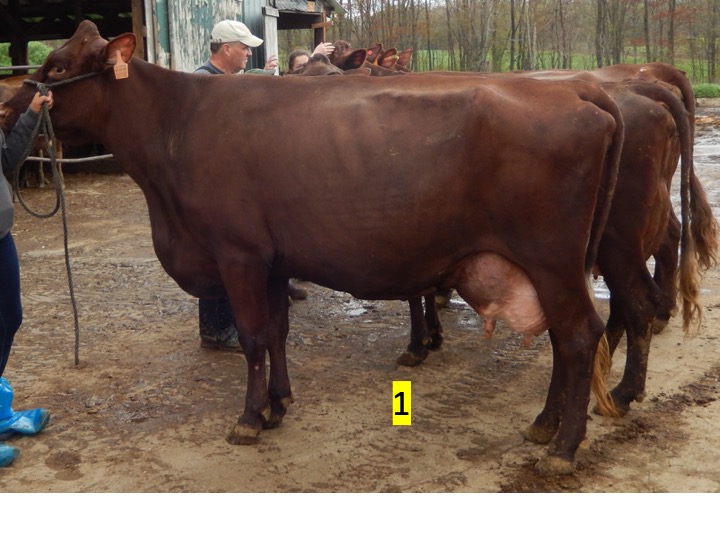
Cow 1 - side view
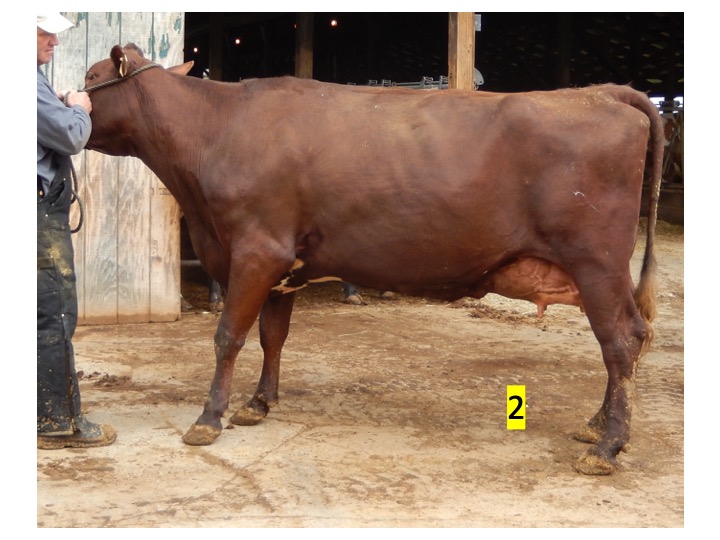
Cow 2 - side view
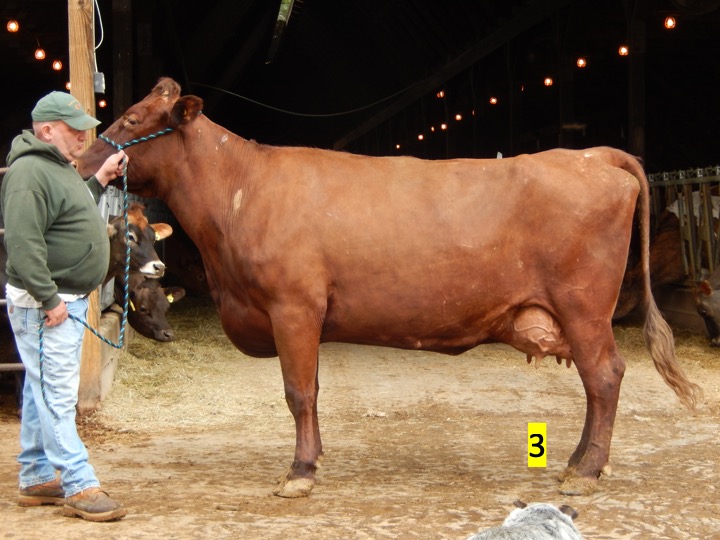
Cow 3 - side view
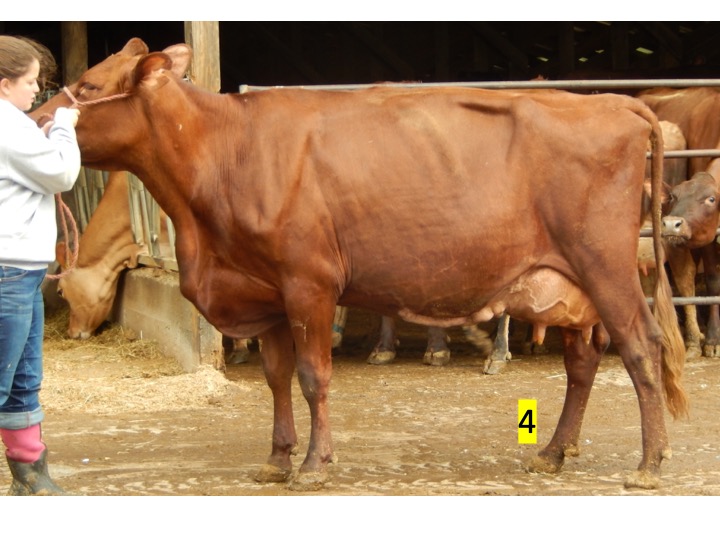
Cow 4- side view
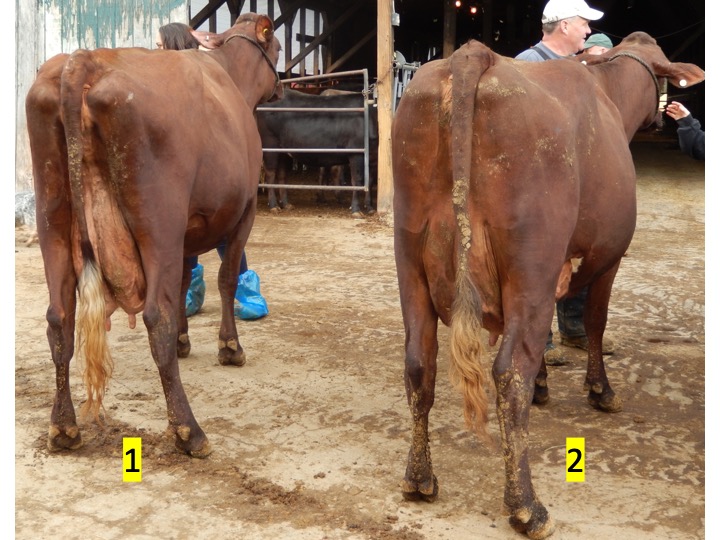
Cow 1 and 2 - rear view
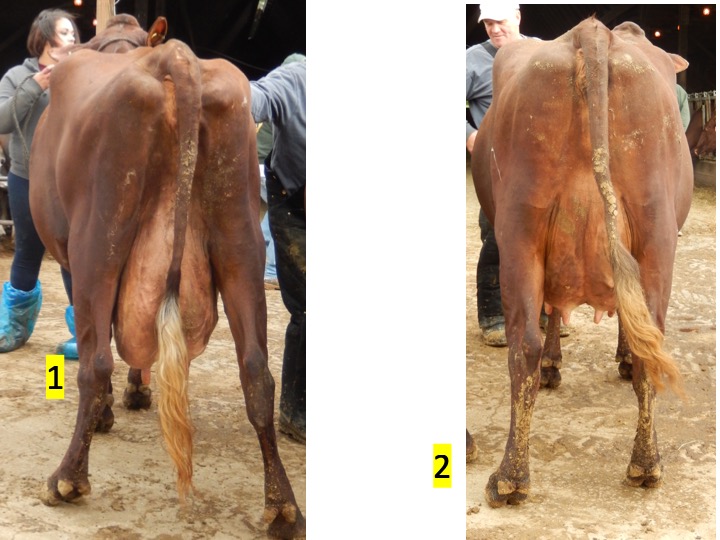
Cow 1 and 2 rear view - option 2
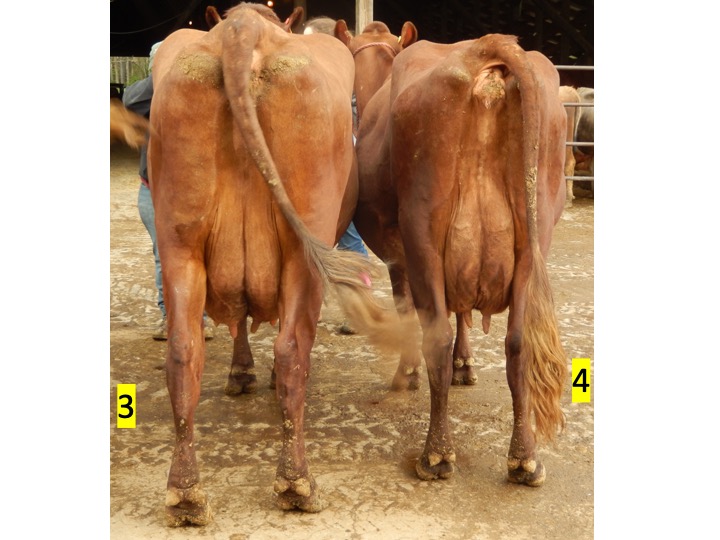
Cows 3 and 4 - rear view
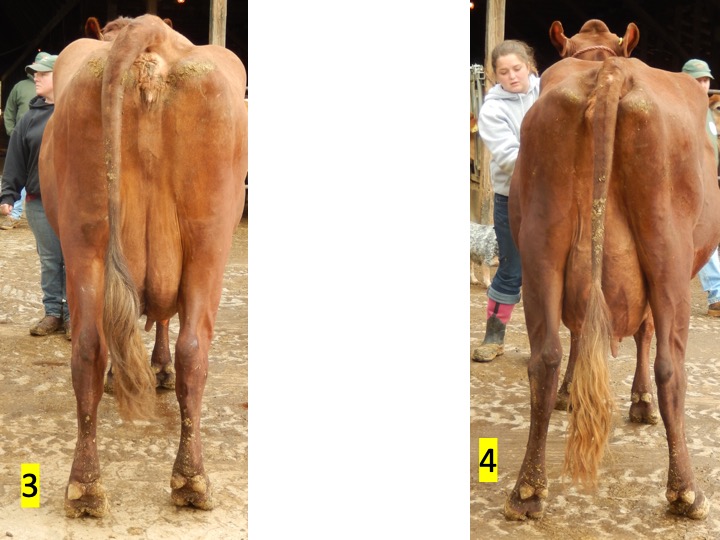
Cows 3 and 4-rear view- option 2
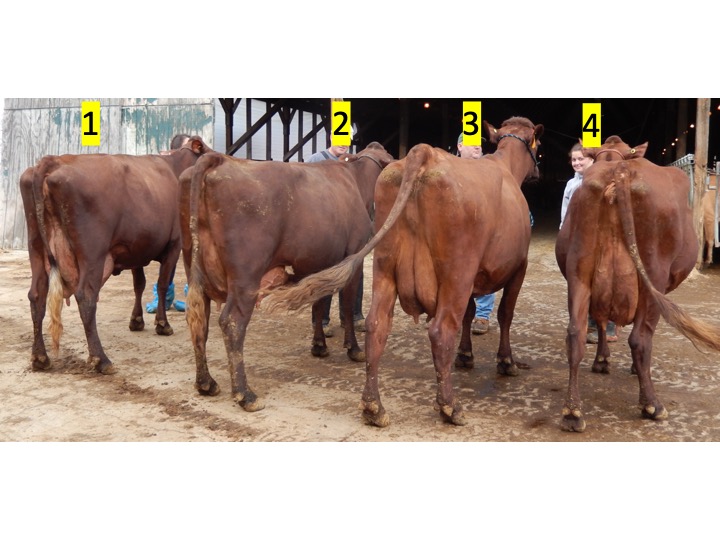
Group Shot - rear view
Holstein 3 year old cows
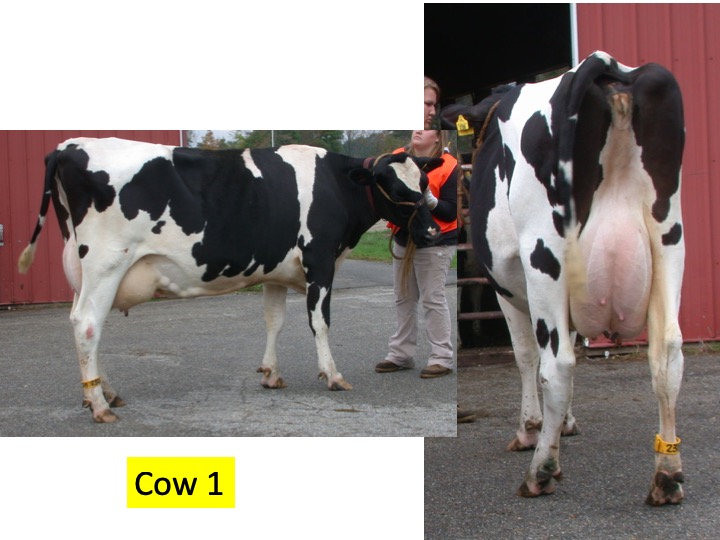
Evaluate this cow compared to the next 3 animals in the class
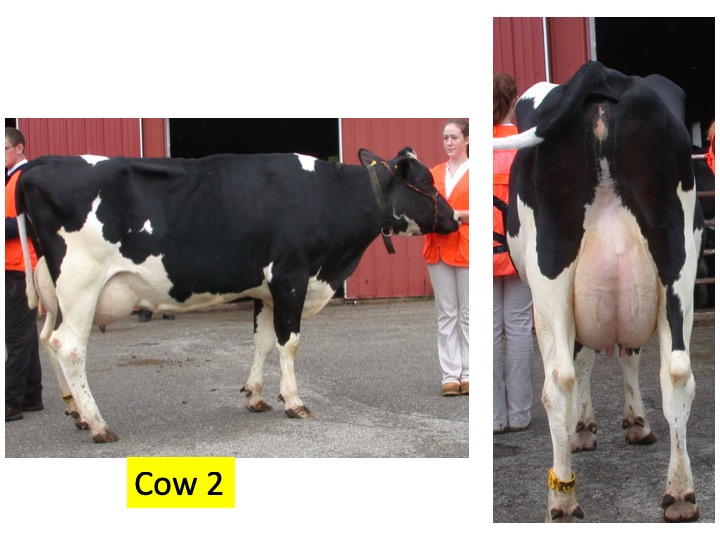
Evaluate this cow compared to the other 3 cows in the class.
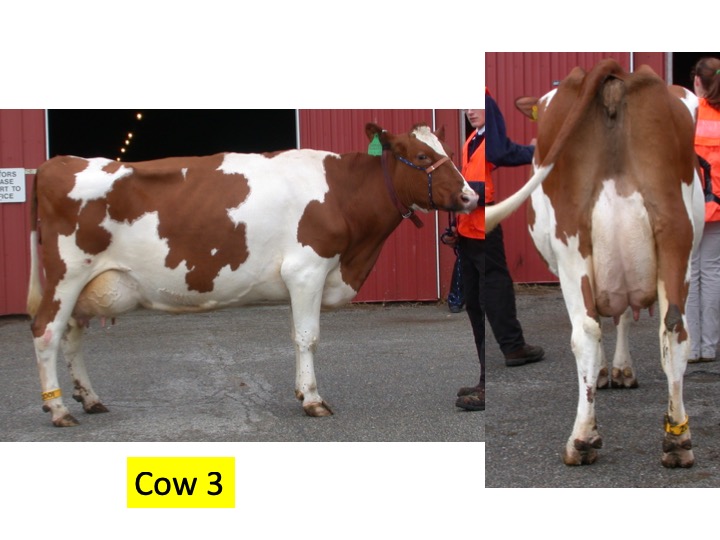
Evaluate this cow compared to the other 3 cows in the class.
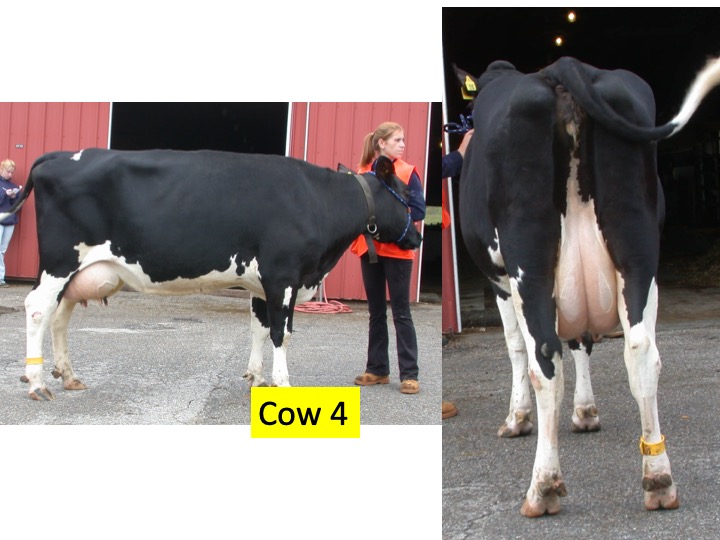
Evaluate this cow compared to the other 3 cows in the class.
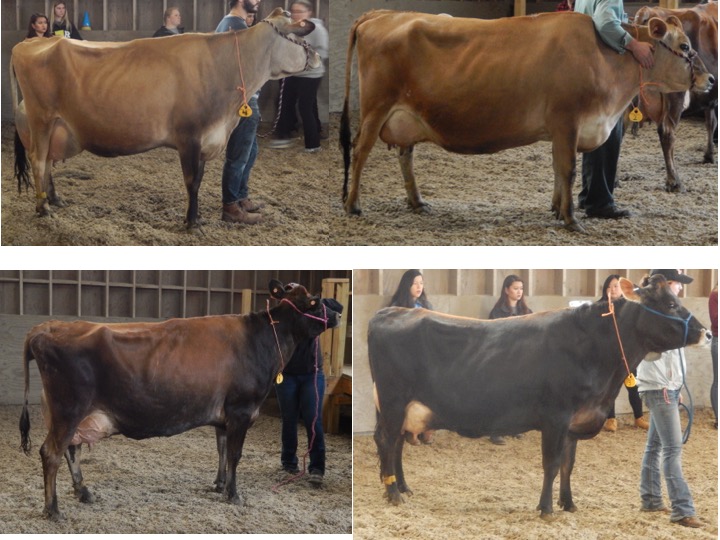
This is a practice class of Jersey Cows from a contest in Rhode Island. The cows were 3-4 year olds.
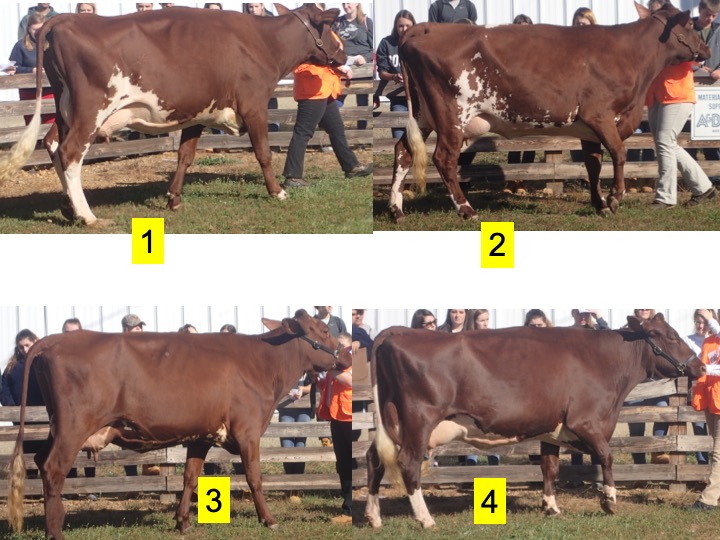
This is another practice class of Milking Shorthorn 3 year olds. Use this image and the one below to place the class and generate a set of reasons.
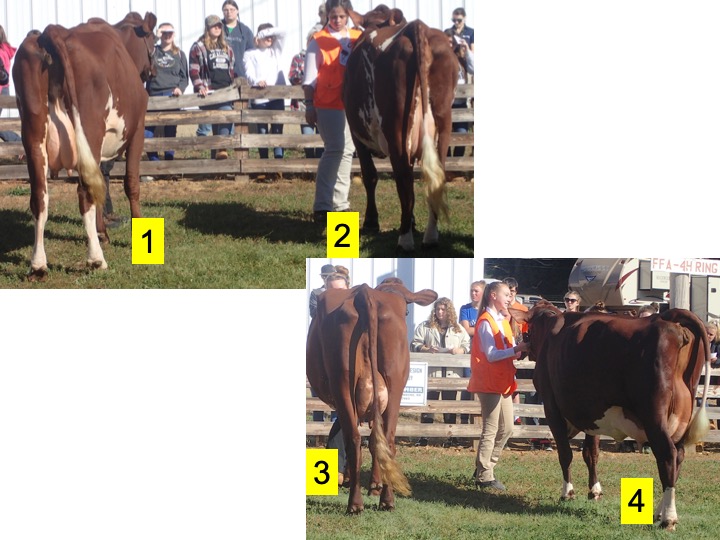
Use this image with the side view of the same cows above.
Additional Videos for Judging Practice
This one was put together at the National FFA Contest in 2018 can be found at:
Six classes of dairy cattle can be found at this link compliments of the 2018-FFA-CDE
Activity Ideas
Here are some resources available on-line which can help teachers and leaders create activities and practice related to dairy cattle judging and giving reasons.
Hoard's Dairyman Practice Classes and Videos
4-H Dairy Project Guide - Canada